 Kent Coast Sea Fishing Compendium |
Lures |
- Introduction
- Lure Colour
- Lures
- ① Picol'eau Rigged Eel
- ② Dexter Wedge
- ③ Red Gill Sandeel
- ④ Berkley Gulp! Sandeel
- ⑤ Calcutta Flashfoil Swim Shad
- ⑥ NOJO's Original Serpent Worm
- ⑦ Delalande Super Sandra
- ⑧ Art Baits Flatfish
- ⑨ Mepps Aglia Plain Single-Hook French Spinner
- ⑩ Marukyu Power Isome Worms
- Sarcelle Bait
- Belgian Grub
- Baited Spoon
- Flies
- Spinners
- Light Rock Fishing
- The Porosand-Eel
Introduction
| Sea-Fishing as a Sport (No 9) Spinning and Whiffing Percy R. Craft "The Illustrated Sporting and Dramatic News" 28th August 1886 |
||
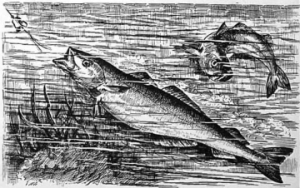 |
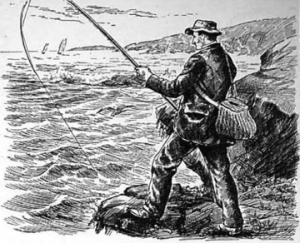 |
|
| "Taking the Lure" | "Spinners: Pipe Lead Sinker, Baby Spinner with Cuttle Bait" | "Into a Big One" |
"The Sea-Fisherman" (1884 - 4th edition) James Carrall Wilcocks at pages 127, 128 & 199
The Mackerel (Scomber scombrus)
Artificial Baits
This well-known fish … affords excellent sport with hook and line; it is taken … in considerable quantities between April and September, but the best fishing is in July and August. They are usually caught from a sailing-boat during a fresh breeze, thence called a Mackerel-breeze, when the boat has good way through the water; but in calm weather a light rowing-boat is often had recourse to with much success, when the fish are abundant.
Artificial Baits
… consist of white and red feather, or other gaudy flies (see fig. 33, p. 89), or mother-of-pearl fish 2 inches long, and of late years artificial spinning baits have been introduced. They are especially useful for mackerel-fishing, although other kinds of fish are taken with them. Every amateur should keep a few by him, as they are as cheap as useful. I prefer them with one hook for mackerel-fishing. A bit of tobacco-pipe (fig. 41) is often used by fishermen with much success, and the best plan of fixing it is as here represented, which can, however, only be managed with a Limerick hook; having no flattened top, this will enter the hole in the pipe easily. However, sea-fishermen often use it with a common sea-hook, and with success, but it is not nearly as snug a method of fitting it. The hook must be whipped on with fine silk, and the edge of the pipe-hole be scraped with a pointed pair of scissors, that it may not chafe off the snooding, which should also be lapped round with silk ½ an inch above the top of the pipe.

By rowing to windward of the shoal of the fish and casting the flies with a rod, as for trout, mackerel are also caught. Not infrequently using two flies, you will take a pollack on one and a mackerel on the other.
General Baits for Sea-Fish
Artificial Baits
The Spoon-Bait is widely used. In addition to these, I may mention the India-rubber band and Captain Tom's Spinning sand-eels and lug-worms, as well as the silver-spinners, by several makers. See p. 83, figs. 27, 28, and 29. Use none but brass swivels for sea-work, as those made of steel corrode very quickly.
"Sea-Fishing on the English Coast" (1891) Frederick George Aflalo at pages 48, 49 & 50
Chapter IV
Baits and Diary
Natural Bait
The other interesting question on the subject of baits is the war of Artificial v. Natural. This strife is far from settled one way or the other, so that it will probably be undertaking too much to give a very decided opinion either way, until fresh improvements in artificial baits have been given a longer trial. In his recent work on "Sea-Fishing for Amateurs", Mr. Hudson takes occasion to emphatically warn his readers against making use of "indiarubber smelts and tin whiting". I have never come across either of these articles; and if I did I should certainly not use them. The author alleges as his motive for opposing artificial baits, that they can have no chance against natural ones, as the fish sniff all round them to see if they are fresh. I do not see the logic of this: there is surely less smell about an artificial bait than about a piece of fish, however fresh it may be. On the other hand, Mr. Hearder (Plymouth), in a letter to the Fishing Gazette (July, 1886), states that his friend Mr. Briggs, of the Start Lighthouse, took thirty Pollack on the rubber eel to every six taken by the boatmen on live launce; and that Lieut. Henn, R.N. ("Galatea"), took 237lb. weight in an hour and a-half with the red sand-eel, when the fish would not look at the natural. It is hard to decide "when doctors disagree" but Mr. Hearder quotes actual facts, and startling facts they are.
Artificial Baits
I now propose to add a list of artificial baits, with supplementary remarks similar to those on natural baits.
| Flies (large, red, white, green) | bass, pollack, mackerel |
| Flies (small silver) | grey mullet |
| India-rubber Sand-eels (red or drab) | pollack, bass |
| Spoon Bait | bass, gurnard |
| Baby-Spinners | bass, pollack, gurnard |
| Plano-Convex Minnow (Hearder) | bass, pollack |
| "Clipper" | bass |
| Clay-Pipe Stem | mackerel |
| Red Flannel or Wool | mackerel |
| Parchment | pollack |
The flies for Bass and Mackerel are usually merely two feathers on either side of a hook: the feathers are red, green, or white; the head is of red sealing-wax.
For Pollack-flies I must avail myself once more of Mr. Marston's kindness, and lay the Gazette under contribution. I will quote two out of five (August, 1886).
- Tail: ½in. of gold twist round shank of hook; red feather. Body: Lower part red worsted; upper part blue worsted or shag, gold twist; orange hackle lower part, bright dark crimson hackle upper part. Head: Large blue jay's hackle twisted on. Wings: Upper wings, two white feathers stained yellow; under wings, red feather tipped white.
- Tail: Gold twist, then some strips of swan mixed, stained red, orange, blue or green. Body: Same as No. 1. Wings: Under wings, mixed colours of swan or turkey stained; upper wings, brown turkey tipped with white.
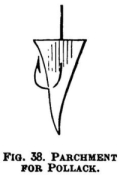
These, together with the fat white flies for Mullet, should be used in the evening. Another fly for Mullet is a "coachman" with silver tinsel body and white wings. "Baby-spinners" are very useful. For Mackerel no bait is required, a small "baby" merely revolving just above the hook. For Bass, &c., the hook may be baited with a "last". In Fishing, July 2nd, 1887, will be found an account of a very successful catch of large Perch on one of these "babies". Indiarubber sand-eels are made at Plymouth in a variety of shapes. The "Capt. Toms" is a good spinner, but I prefer the "Jim Crow", a sand-eel and baby-spinner combined. For Pollack they are best red; for Bass, drab. The parchment for Pollack is cut in the shape of a triangle or arrowhead (Fig. 38). It may be worked rise-and-sink fashion
With two final cautions I will leave bait:
- Natural baits should be fresh and soft, and all bones should be removed.
- Artificial baits should be kept very bright, and the swivels should be well oiled.
"Practical Letters to Young Sea Fishers" (1898) John Bickerdyke at pages 117, 118, 122, 123 & 124
X. Artificial Baits
The angler who has a pair of hands, and knows how to use them, should never be at a loss for a bait for whiffing [1] purposes. Feathers are always to be obtained, and even a sardine box will afford the material for a capital imitation of a fish which, by twisting the tail, or slightly curving it, can be made to spin, or at least jump about in a life-like manner when drawn through the water. Any old hearth rug or antimacassar will provide wool for the bodies of sea flies, while if india-rubber bands are wanting, the next rasher, when being trimmed for its expedition into the frying-pan, will yield an admirable substitute. A piece of white or red rag, even, will take pollack or coal fish, but the feather baits are better.
[1] (at page 189) … whiffing or railing … These two terms, by the way, are loosely used, and are practically synonymous; but to be very correct whiffing applies to trailing from a boat under sail, while railing is the same method carried on from a boat which is being rowed.
XI: Baits Cast with the Fly Rod
A capital bait for casting with a fly rod, which is a novelty to most sea fishermen, can be made from the tail of a mouse. An ordinary round bend worm hook is used on which a piece of medium sized gut is whipped. The gut is well soaked, and then threaded through an ordinary needle. The needle is passed in at the tail, about the centre, threaded through it, and brought out at the thick end, the gut and the shank of the hook following. A few turns of well waxed red silk or twine are required round the thick end of the tail to keep it in place just above the shank. Sea trout and other fish will take this bait, and no doubt regard it as a kind of worm, its hairiness being an additional attraction.

Very light artificial sand eels can be cast with a fly rod, and for sea trout are best worked in that way. They are easily made by means of a piece of grey indiarubber tubing, such as is fitted to very cheap, babies' feeding bottles. It can be bought by the yard. It is not only useful for this particular purpose, but also for making the long, twisted grey rubber eel for coal fish and pollack, though for these fish the black or red rubber is, I consider, as a rule preferable.
To make the sand eel for casting from the fly rod, increase the length of the shank of a No. 12 or 13 hook about 3in. by whipping on to it a piece of wire, ending with a swivel. Thread a piece of tubing on the hook and bring latter down on to the bend, where it should be cut slanting, and then sliced to make it vibrate. The end of the tubing next the swivel should then be tied firmly to the wire. The only thing that remains to be done is to paint the eel. The back can be done with two coats of Stevens' blue-black ink, one coat being brought a little farther down the side than the other. The belly can be touched up with silver paint, and the sides left white. These latter should be scraped occasionally to keep them of good colour. Two pink beads. can be sewn on to the rubber to represent eyes, with black circles drawn round each in ink. When finished the whole should receive a coat of varnish. Paint and other colouring matter does not last long on rubber, but it is easy to retouch these baits occasionally or to make new ones. For sea trout they are cast like flies, just over the edge of the seaweed, and worked with a sink and draw motion, or drawn along. Those who cannot cast a worm without throwing it off the hook should try this method of fishing in salt water for sea trout, as it is very deadly. The worm, if cast with the fly rod, should be worked with a sink and draw motion - that is to say, as soon as it touches the surface let it sink perpendicularly, then draw it in a slanting line to the surface; then let it have another perpendicular fall, and continue this operation until it is brought close up to the angler's feet.
While this book was in the press, I received from a Scotch correspondent a curious coal fish bait. It consists simply of a hook with a spike of grass in bloom laid along the shank.
"Dover as a Sea-Angling Centre" (1900) Deputy Surgeon-General Charles Thomas Paske at pages 90 & 91
Chapter X
Artificial Bait
Of the numerous and ingenious contrivances which figure in all catalogues, but few are here patronised, the most common being "Baby Spinners" and "Sand Eels" so called, but as much like that silvery, darting creature as a dried herring to a fresh one. Nevertheless, they answer the purpose remarkably well and, being cheap and lasting, suit the majority. They are made in three colours - red, white and black, and as far as my experience goes, one is as good as the other. Of any approach to Æstheticsm, fish are profoundly ignorant, anything which wobbles, shines and moves through the water being considered legitimate food - till hooked! The modifications of these sand-eels being many, the angler can suit his own fancy. An artificial prawn is a killing bait, and for bass a piece of mother-of-pearl shaped after the similitude of a fish. But conservatism being stamped on Dover all along the line in indelible characters, it becomes no easy matter to wander outside the beaten track of the unwritten and recognised law, be it socially, politically or piscatorially, without creating great surprise and much wagging of tongues … A boatman once nearly refused to take me afloat when he perceived I was going to use the latter (mother-of-pearl) declaring that nothing could be done with "that ere thing". You may batter it down for a time but it is bound to come up again, such elasticity does it possess. It has been said of old that "when in Turkey we should conduct ourselves as Turkeys", and certainly here in Dover we are expected to follow the example of Dovorians in all things, not excepting the utter ruin of even an ostrich-like digestion by eating heartily at afternoon tea two hours before dinner. My firm belief is, that the evil one suggested such "teas" to suit his own sinister purposes.
"Sea-Fishing" (1911) Charles Owen Minchin at pages 24, 25 145, 146, 147 & 148
Chapter II
The Bass
As to artificial baits, they are numerous and generally ineffectual; but there are several which may be tried, and sometimes one or another comes off all right. The silk phantom bait used in fresh water is decidedly attractive; but the mountings are liable to corrode in sea water, or to give way under the heavy pull of such a strong fish as the bass; in fact, the bass is such a very much stronger fish than the pike that mountings which are quite strong enough for the latter are liable to be broken like pack-thread when put to the test by whiffing over a reef of rocks, where, of course, a bass when hooked must be held pretty tight. Then the "wagtail", either in blue and silver or in vermillion and green, is a really good lure, strong, tempting and durable; a black and white "challenger" or a plain white rubber-eel will often get a good bass late in the evening. There is also an indiarubber model of a sand-eel, painted so as to resemble the natural fish. This is rather killing if whiffed in jerks so as to imitate the movements of the swimmer; but none of these lures are at all so good as the actual living bait, and, of course, they are all useless unless played in the water by rapid motion.
Chapter X
The Pollack
The best artificial baits for these young fishes are a black rubber eel of the smallest size on the tail hook and a gurnard-skin phantom on a dropper about 2ft above it … If the fish are pretty numerous, as soon as one takes the worm it will make the dropper play about in the water in a fish-like way, and a second pollack will probably go for it. From experience it is found that the baits are more successful in this than in the reverse order. Most of the big pollack are taken by trailing a bait - natural or artificial, generally the latter - over the rocks where they harbour, and, as a rule, this sport is best carried on by twilight, not because the fish do not feed in the daytime, but because when the light begins to fail they rise nearer to the surface, and there is less risk of losing bait and trace among the rocks and seaweed.
… The best bait, day in and day out, is probably a well-made rubber eel - red, black or white: black to begin with in the afternoon while there is still a good deal of light in the sky, and white when the darkness is impending. When absolute night has fallen this kind of fishing is at an end. Care should be taken to have the eel properly shaped so that it comes well down beyond the bend of the hook before the tail detaches. If it is only in a straight or nearly straight line with the shank of the hook it will not play properly in the water. In the Lizard district, where the rubber eel is known as "thay paatent", the experts swear by a pale, almost lemon-coloured eel, and in Kerry they say that a very large one, as much as 8in long, is the best. Very good rubber eels are made by Brooks of Plymouth, Head of Penzance and Wadham and Co of Newport, Isle of White. If one of these does not succeed the others can be tried in turn, and it will be hard luck if the fish (assuming they are on the grounds) do not take hold of them. Another excellent rubber bait is the "challenger". In this the body is of one colour and the tail of another - a red or black body with a white tail is the usual combination, and these, it is believed, hold the record for the greatest take of pollack in one night, something over 300 fish averaging nearly 10lbs a piece, for three rods … among artificials the "wagtail", which is made of two rubber fish-shaped strips of different colours, often answers very well …
"Sea Fishing Simplified" (1929) Francis Dyke Holcombe & A. Fraser-Brunner at page 36
Chapter VI
Bass
Bass are sometimes caught by "whiffing" which means towing a rubber eel or other artificial spinning bait behind a boat going slowly along … the rubber eel may be black, red, green or yellow.
"Approach to Angling in Fresh and Sea-Water" (1950) E. Marshall-Hardy and Lieut. N. Vaughan Olver, R.N.V.S.R. at pages 209 & 210
Section IV: Sea Fishing from Jetty, Pier or Shore
Chapter IV
The Seaside Native on a Rocky Coast
Spinning
… The illustration (Fig. 133) shows three good spinners for sea fishing. A and B are mackerel spinners. C is a rubber sandeel which is killing for bass and pollack. There are many others some of which are good and some are bad; experience is your best guide in this matter.
Fig. 134 shows the type of trace used for sea-spinning. Leads as used for float fishing, if heavy enough to enable you to cast some 20 or 30 yards, will serve for spinning. If, however, more weight is needed foldover leads can be added above the top swivel as indicated.
 |
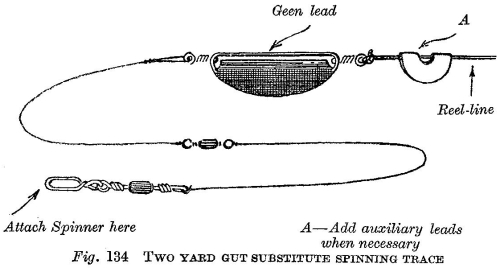 |
"The Technique of Sea Fishing" (1953) W. E. Davies at pages 91 to 94
Chapter VII: Spinning
Best All-Round Bait
I have often been asked what in my opinion is the best all-round spinning bait and each time have answered "the spoon". This spinning, wobbling artificial is the most ancient of devices for luring fish and it is a great pity that its capabilities as a creel-filler are possibly the most underrated of any bait in the tackle box.
It is thirty years since I realised the possibilities of fishing a spoon. Until then, my pollack, coalfish and mackerel had been taken on flies and devons. Then my work entailed a visit to China, where I found the natives using kidney-shaped spoons made of mother-of-pearl. On inquiry I found that such spoons were in use long before bone hooks dressed with dyed fibres and silk had been thought of. Some years later in British Columbia I found the Indians taking sea fish with bone spoons; and was told that the method of making and fishing these spoons had been handed down from father to son for generations. In Finland and Norway, the story was the same. Spoons had been the ancient's fish-getter.
I am convinced that fewer strikes are obtained on a dull than a bright spoon. It is the flash of the artificial which attracts. Spoons should, therefore, be kept well polished. Copper, brass (gold) and silver spoons are specifically chosen because they resemble more or less the fry upon which predatory fish feed. On very bright days and during the neap tides a copper spoon is preferred. Silver or gold give better results on cloudy or dull days. Chromium, incidentally, has the appearance of nickel when out of water; but in water it takes on a dark hue and for this reason is rarely used.
Sound Fishing
When using large spoons, or for that matter any heavy artificial bait, do not snatch them from the water; this puts a heavy strain on the tip of the rod. Bring the bait to the surface and pick it up quietly. This is moreover, sound fishing, for on many occasions a fish will follow the spoon up and take it as it reaches the surface.
Next to the spoon I place the rubber eel second for obtaining sport. In 1951 the rubber eel proved its worth when my boat companion the late Mr. Copping landed a 16-lb. coalfish on an outsize in eels, a 15 inch one. "Old Cop" as he was called by sea anglers over a wide area believed in the old principle of "big fish, big baits". One thing about his rubber eels I noticed which may have accounted for his having more strikes than me, was that at the tail of his bait he had fastened a wobbler. This wobbler was made out of a rubber washer used for sealing preserve jars. The washer is cut in half and a half is fastened to the hook inside the rubber. As the eel spins through the water the wobbler creates a "boiling" in the water and this so far as coalfish are concerned, proves attractive.
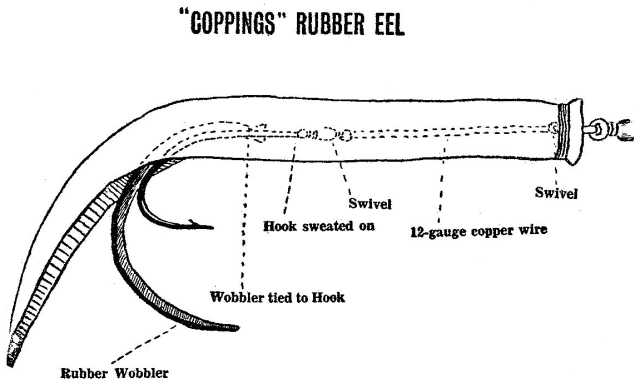
"Old Cop" had his own method of making rubber eels and having tried them on several occasions I can vouch for their effectiveness. Inside the rubber tubing he put a length of 12 gauge soft copper wire. The ends are sweated to swivels and the hook is sweated to the tailend swivel. The beauty of this eel is that as soon as you have a strike the eel straightens out and you then have a direct pull on the fish. When you have landed or lost your fish as the case might be it is an easy matter to bend the bait into any curve to make it spin either left or right.
In third place come devons and wagtails. With these two baits you never know what you might catch. For instance a friend of mine some years ago was spinning a three inch gold devon for coalfish on Loch Torridon and the first strike he got was from a 15-lb salmon which was duly landed after a battle lasting ten minutes.
The fact that devons are heavier than most artificial baits is most helpful as less weight has to be put on the trace to get distance. Another point I like about them is that the hooks are small compared with those used on spoons and eels. A small hook holds better than a large one. The fine wire of the hook bites deep and there is little chance of it being levered out providing the fish is played nice and easy. Never try and bring a fish in by force, it is the surest way I know of losing him.
"Bass: How to Catch Them" (1955) Alan Young at pages 33 & 34
Chapter II
Tackle
Lures
Bass have been caught on so many different patterns of lure that any attempt to list them would read like a tackle catalogue. I shall deal only with well-tried patterns and those with which I have had some success.
It is well to bear the food of bass in mind before buying or making lures. Spinning is usually done in the upper waters where a bass is expecting true fish, sand eels or prawns. The most effective lures are, therefore, those that imitate brit and sprats and the more specialized lures that imitate sand eels.
As a personal generalization under this head, I will say again that I prefer single hooks to doubles or trebles, and when I acquire lures armed with small trebles I substitute large single hooks.
"Pelham Manual for Sea Anglers" (1969) Derek Fletcher at pages 113 & 114
Teasers
Fish are not eternally hungry, although anglers often dismiss their lack of success by explaining 'they are not feeding today'. The fact is that the fish have gorged themselves too full and are merely cruising around to digest their food.
At such times anglers will have far more success by tempting the fish to bite for other reasons as well as hunger. That they do bite for other reasons can be deduced from the fact that quite a large number of fish are caught with unorthodox baits and with their stomachs distended with food.
When fish are working off their excess energy, and are not interested in food, this is the time to irritate them with a teaser lure, such as a fast jinking plug, which is especially effective for bass.
It is worked so that fish have very little chance to intercept, but it irritates them to the point of frenzy. After a few casts with a teaser plug, it is replaced with a more sedate plug of the same colouring which the fish can catch. Anglers who have not tried this method will be surprised at the number of fish that will take the plug after being teased.
Another teasing method for anglers who do not favour plugs is to add a touch of colour to the bait. After bass or pollack have gorged themselves on a shoal of small fish, they will amuse themselves for long periods chasing the small fish around merely out of high spirits. At such times the chance of a fish taking a fish bait being used by an angler, out of thousands of small fish in the shoal, is very remote. A touch of colour to the bait, such as a few strands of red yarn, will make the bait stand out from the shoal as a freak. Nature cannot stand freaks and the fish's attention is soon attracted.
"Competition Sea Angling" (1970) Bruce McMillen at page 45
4. Methods
What a scope there is here for the angler to use his ingenuity. If an original idea, which may feasibly enhance your chances of catching fish, suddenly comes into your head, don't just forget it. Work on it and try it out. It may well result in your winning more than one competition.
Anglers have plenty to learn, and I am firmly convinced that there are still many methods of presenting enticing baits to the fish which have yet to be discovered, so never become fettered by old and hide-bound ideas. The result of your new thinking may prove to be an idea for which anglers have been waiting for years. Fish are quite unpredictable creatures, and also being singularly uncommunicative, the darned things simply will not tell us what they want, so it's up to us to try to find out.
"Successful Sea Angling" (1971) David Carl Forbes at pages 53 & 54
Spoons, spinners, and bars can be tremendous lures for mackerel, bass and pollack, but it is a sad fact that lures have a special sort of magnetism which attracts more anglers than fish …
… Much of the beautiful colour treatment in lures is lost on fish, and quite possibly colour in itself is relatively unimportant, beyond the fish-like silvers and bronzes. What is important is the shape of the lure and the way that lure moves in the water.
Having settled for a lure which you feel will act in the water like a small, abstract fish - and after all, lures are supposed to represent small fish - the secret behind successful spinning is to work the rod and reel to impart 'life' to the lure, retrieving as slowly as you possibly can, so that the movement potential of the lure is exploited to the full. A general fault in spinning is a desire to cast the lure as far as possible and then retrieve it in the fastest possible time. Even with fast-retrieve reels, it is improbable that one could retrieve fast enough to beat a bass, mackerel, or pollack which is streaking after the lure, but most fish tend to ignore a fast, constant movement. Far better to disregard distance, to pick out a particular area and concentrate on that area, relying on short, accurate casts, retrieving through gullies and around rocks and pilings with the lure wobbling and jerking on a slow, erratic course.
"Estuary Fishing" (1974) Frank Holiday at pages 64 & 65
Chapter Four
Baits - Natural and Artificial
Pirks, spinners and imitation eels
Pirks, spinners and imitation eels need to be considered as a group in order to make sense of the situation. It seems hard to believe that thirty or so years ago the only artificial lures used in sea-angling were the mackerel spinner and the rubber eel. In those days eels were made from rubber tubing mounted on a short length of wire which was cranked so that the bait tended to revolve. Alfred Powell writing in 1935 in the Lonsdale Library volume Sea Fishing begins to break away from this tradition by recommending flexible surgical rubber tube. However it was not until the 1950s, when soft plastics became available, that some attempt at representing a swimming, non-revolving, eel was tried. Some of these early plastic eels, oddly enough, were fair representations not of launce but of a swimming worm called the Paddleworm and they may have been successful on this count without the maker realising the fact. Whatever they looked like they caught fish and many a bass was lured to the writer's rod through their use. Later representations, such as the 'Red Gill', are a great advance on the old-style 'rubber eel' and show how problems of presentation can be overcome.
Every sea-angler who appreciates that the launce is paramount as a food-species in summer seas must wonder how best to simulate the slender creatures. One bass expert, who fishes offshore reefs by boat and claims to have had over 100 bass each over 10 lb., spent years working on experimental models of launce. He refuses to exhibit the result of this effort but it is reported to be a two-piece plastic eel about 8 inches long which is hard to detect from the real thing when it is in the sea. Whether this is so or not I don't know but it is certainly true that, for most anglers, the complete answer to launce-simulation has not yet been attained.

My own way with the artificial launce is to go back to rubber - but not the stiff tubing of yesteryear. I use a dense sponge-rubber of fine texture. The eel is cut from a ½-inch thick sheet, the forepart of the body about ¼-inch wide tapering to a tail about half this thickness. A lateral curve is put into the tail during cutting. The depth of the tail is then reduced to about half using sharp scissors to produce additional flexibility and the head is made pointed like the real fish. A single hook is mounted on strong nylon which is worked through the body of the eel so the hook finally reposes midway under the belly and the nylon emerges from the nose. The finished product is then painted with matt colours - a careful selection of blues and yellowish-browns with a pale underside to resemble the actual creature. Tandem hooks improve the numbers of fish hooked.
"Fisherman's Handbook" The Marshall Cavendish Volume 2, Part 37 (1978) Mike Millman at pages 1009 to 1011
Rubber Eels, Lures
For more than a hundred years, rod and line have used artificial lures to catch sea fish. Long before the start of this century, ingenious minds dreamed up many different baits that twisted, wobbled or travelled through the water with an undulating motion. The earliest lure was made from a length of wide rubber-band, one end whipped to the hook shank. It bore a remarkable resemblance to a living worm.
Sophisticated lures appear
From this beginning, more sophisticated lures soon evolved. Two types in particular, known as Brook's Double Twist Spinning Eel and Captain Tom's Spinning Eel, were the first to be made from lengths of indiarubber pipe. This was pushed onto a large hook to form an 'elbow' at the bend, which caused it to spin when worked through the water at speed. Small brass swivels attached to the hook eye prevented the line from twisting to any great extent, and the top end of the pipe was securely fastened to the shank with stout thread.
In 1948 rubber gave way to plastic and the first modern eels appeared. The 'Mevagissey', produced by Alex Ingram, was made by a dip-coating process. Early models featured a long, soft, curved tail, which plugged into a hollow body. When viewed from above, the lure had a natural-looking action, but it tended to spin, which caused the reel line to twist. One day, watching a jet landing with its braking parachute extended, Alex noted that this chute oscillated, and he realized that if the action could be incorporated into a sandeeel, its movement would be much improved. Over a period of time, various prototypes were tried out in the rugged conditions of wreck and reef fishing at many sites in Britain, until the 172mm Red Gill lure finally emerged that was to revolutionize sea fishing.
In the late 1960s dip-coating gave way to injection moulding, and improved plastics produced a much better eel. Modern PVC resists ultra-violet radiation and the effects of saltwater, so that lures now have tremendous durability. A boat angler fishing off Falmouth, who kept careful records of each fish he caught, noted that 199 pollack fell to the same Red Gill lure. Gradually the range has grown, and the latest is the 210mm Thresher, designed for wreck fishing.
Eddystone artificials have certainly made their mark on the sea angling scene since their introduction in 1974. Less sophisticated, but with a devastating tail action, they are now in wide use, and account for large numbers of big fish. Some models designed for spinning have a metal head plugged into the conventional plastic tail. This enables the lure to be cast a considerable distance, without the need for a spiral lead on the trace. Eddystone trolling lures with exceptionally long and very thin tails are also used e with great success by anglers seeking bass and pollack.
Movement - the secret of success
No matter how good the design of an artificial sandeel, its success is totally dependent on one thing - movement. All have a negligible action of their own, and only movement imparted by an angler gives a lure 'life'. Unfortunately, this is not always realised, and one sees artificial sandeels being used garnished with a strip of mackerel, squid or - incredibly - a natural sandeel. Anything on the lure's hook will completely ruin its action.
Soft plastic can easily become deformed, too, if not handled with a reasonable amount of care and it is therefore important not to crush eels into a tackle box.
Plastic eels are available in a wide range of colours, but divers tell us that below 30 ft, even in clear water conditions, colour (as we know it) begins to disappear. So what is the point in painting artificials so attractively - most are used in depths of 40 fathoms (240 feet) to which no light pentrates. The clue is surely in the phrase 'colour as we know it'. The human eye may perceive quite differently from the fish's eye.
During 1972, a year when many outstanding pollack and coalfish were caught in deep water, red lures accounted for the greatest number, including the present British record pollack of 25 lb. Lures of other colours were being offered in an identical manner, but got a very poor response. Consequently, red lures were so much in demand that supplies ran out in the tackle shops and stocks finished in green, yeloow and blue were quickly given a coat of red paint.
Recent studies have shown that lures coloured deep purple with a blue head, and dark red with a gold body, are currently catching extremely well.
Profusion of metal lures
So far we have dealt only with plastic lures, but there are a great many manufactured in metal. This type is used extensively for shore spinning, and, to a lesser extent, trolling from small craft over inshore grounds. The range of shape and colour is bewildering. The newcomer to sea angling is easily confused by the profusion of different types, all of which profess to catch fish when, regreattably, most are designed to catch anglers. A recent estimate of the number of plastic, wood and metal lures originating in North America came to almost 4,000 kinds. While many are obviously the result of detailed study into the habits of certain species, the majority are completely worthless. It is a sad fact that many tackle shops in Britain now carry artificials that are equally ineffectual. Before parting with your money, therefore, take advice from anglers with experience in artificial lure fishing.
Spinning is now a very popular method with shore anglers. Development of suitable tackle has kept pace with the sport and hollow glass rods, fixed-spool and multiplier reels handle lures of ⅛ oz up to 4 oz. All the beginner needs is a 7 ft rod, a fixed-spool reel and 10 1b b.s. line - £12 buys a good-quality outfit from a reputable manufacturer.
Among the most successful metal lures for spinning are Toby, Droppen, Spinflasha and Wingflasha, which have accounted for many fine bass, pollack, mackerel and garfish.
Baited spoon fishing for bass, flounder and plaice really demands a feature of its own and there is reference to it in How to Fish articles elsewhere in Fisherman's Handbook. It is a method much used by experts when working in estuaries and tidal rivers. Spoons take many forms - what is right in one place can be a complete flop in another. Many are home-made from brass, copper and occasionally plastic. Inventors pay great attention to the overall shape, thickness and twist of the blade, and to the colour, which many consider vital.
Swedish model
A commercially produced spoon that takes a lot of beating is ABU's Rauto. Among its captures in deeper water have been record cod on 6 lb line, and much heavier fish on stronger tackle.
The search for new and better designs in both plastic and metal goes on. Many fish, especially bass, are becoming familiar with the appearance of current designs of plastic sandeels and show an added wariness, but there is little doubt that British manufacturers, who lead the world, intend to stay one jump ahead.
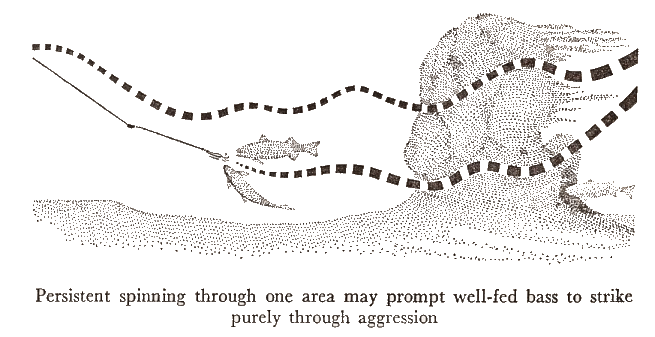
Lure Colour
Most keen anglers have a favourite lure or fly colour, and swear that their choice will out-perform all other offerings. But just how important is colour when it comes to lure and fly selection? Well, according to science, not very important at all. Water progressively absorbs or blocks light of different wavelengths, meaning that colours effectively "vanish" one after another as "white" sunlight travels through the water column. The overall intensity or brightness of visible light also diminishes rapidly underwater.

Because this absorption is greater for longer wavelengths (the red end of the spectrum) than for shorter wavelengths (the blue end of the spectrum), perceived colours are rapidly altered with increasing depth or distance through the water. The precise rate at which this loss of colour occurs varies depending on:
- the intensity of the sunlight
- whether the sun is directly overhead or low on the horizon
- the amount of cloud cover
- the clarity and colour of the water
- the presence of any suspended matter such as weed or plankton
Even in very clear ocean currents far from shore, less than 25% of available sunlight hitting the sea's surface will penetrate much beyond 30 feet or so. By the time we reach a depth of 300 feet, the remaining light may be as little as 0.5% of that available on the surface. In other words, it's a pretty gloomy place down there. In freshwater lakes and rivers, this loss of light with depth is even more dramatic.
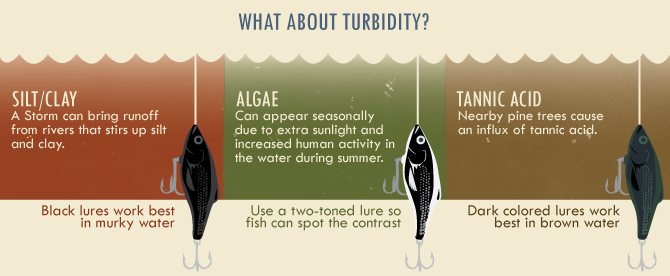
As already mentioned, red is the first colour visible to our eyes to disappear, and is typically gone within 15 or 20 feet of the surface, much less in turbid water. Orange disappears next, then yellow, green, and purple. Blues penetrate deepest of all, both the tones visible to our human eyes and also the shorter, ultra-violet wavelength many fish can see.
This phenomenon has a profound impact on the way things look to us, and also to fish underwater. White objects will appear bluish or gray underwater, and the darkness of that blue/gray appearance increases rapidly with depth. Red objects will begin to look dark brown or even black within a few metres of the surface. Down at 40 or 50 feet, even in very clear water, the world appears to be composed entirely of shades of gray, blue, and black.
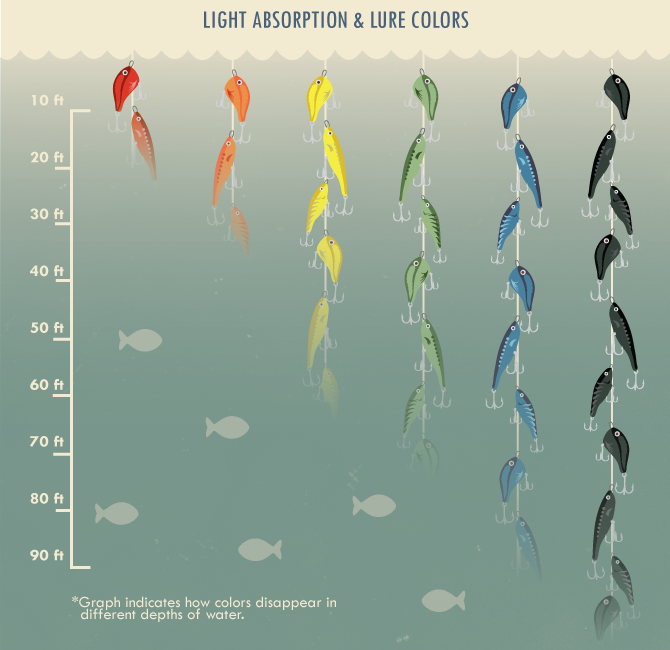
It's worth stressing that this loss, or alteration, of visible colours occurs in both the vertical and the horizontal or diagonal planes. So, 40 feet of vertical depth has roughly the same impact on light waves and colour perception as 40 feet of horizontal or diagonal separation between object and observer. In other words, a red lure may look black when viewed at a depth of 40 feet, but it will also appear black, or at the least brown or very dark grey, when viewed from the side at a distance of 40 feet, even if it's travelling right up in the surface layer.
In summary, colours disappear underwater at the following depths:
- red - 15ft
- orange - 25ft
- yellow - 35 to 45ft
- green - 70 to 75ft
If you are 10ft underwater and you are viewing an object 10ft away, the light has actually travelled 20ft, and all of the reds will be filtered out.
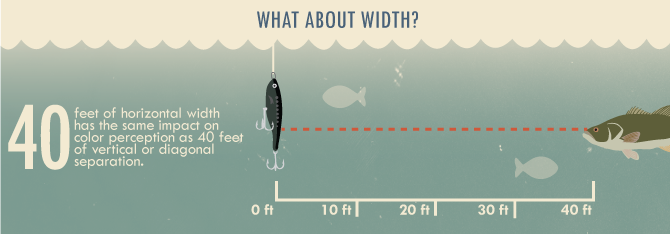
At face value, this phenomenon of light and colour loss underwater makes a mockery of the importance of colour in lures anywhere beyond shallow, ultra-clear sea conditions, yet anglers the world over will continue to argue that one colour is better than another, even in deep-water jigging. The funny thing is, if you ask half a dozen anglers for their opinion on the most effective lure colour, you're likely to receive six different answers. Perhaps it's time we moved colour to the bottom of the list of criteria when choosing a lure or fly, and place far greater emphasis on the size, action, profile, and speed of our offerings.
Lures
① Picol'eau Rigged Eel
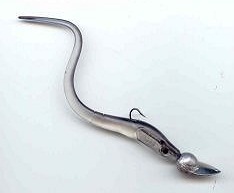
Length: 8 inchWeight: ½, ¾ & 1 oz (13g, 21g and 28g)Action: sink & draw
Available from sharnbrooktackle.com (price £7.35) in 8 colours with silver and black being top fish takers. Great swimming action. The lure is cast out, allowed to sink, then retrieved either at medium pace or sink and draw. An innovative lure designed for bass and pollack fishing from both shore and boat and considered by some as probably the best bass lure around.
The sandeel-like lure incorporates a weighted head and metal bib which is designed to make the lure surface rather than dive, giving the impression to predators that the eel is trying to escape to shallower reaches. The weight can be adjusted to suit the ever changing conditions without having to remove hooks by simply unclipping the weighted head from the hook and replacing it with a more suitable weight. These lures also work well for pollack on the inshore reefs and when fishing off deep water rock ledges. Similar in appearance and performance to the Jig Head Picol'eau (£5.50 twin pack in 5g, 9g, 13g, 17g, 21g and 28g weights).
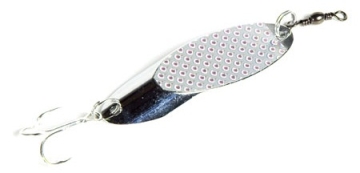
② Dexter Wedge
Length: variousWeight: 1 & 1½ ozAction: deep working spinner
Been around a long time and is still one of the very best bass catchers. It fishes at all retrieve speeds and wobbles and darts from side to side. It imitates small bait fish such as sprat and smelt. It casts like a bullet through head winds and is highly effective all year round, but especially so at the height of summer when shoals of small bait fish are pushed tight inshore by both bass and mackerel. Also takes pollack, mackerel, garfish and coalfish.
"Competition Sea Angling" (1970) Bruce McMillen at pages 42 & 43
3. Baits and Lures
Metal Lures

I believe that one of the most efficient and productive lures in general use is the ABU 'Toby', a bait which has probably accounted for a greater number and a greater variety of fish, both sea and freshwater species, than all the other lures put together. The 'Toby' is particularly deadly for bass, as is the 'Condor' or 'German Sprat'. If you purchase this last named lure and find that a swivel is attached to the pointed end and a treble hook to the flat end, remove the swivel and replace with the treble hook, as this bait is not intended to spin. The removal of the swivel and the re-positioning of the treble hook will make all the difference to your catches. A split ring can be placed at the flat end.
'Condor' or 'German Sprat' lure. (A) as normally supplied, (B) as it should correctly be used without the swivel and with the treble hook attached to the pointed end by a split ring.
It should be of particular interest to the competitive angler to note that sheer 'flash' often plays a vital part in the fish attracting properties of metal lures. As an example, I would quote an experience I had when using some home-made brass lures. They failed to take bass, while anglers using plated lures and fishing alongside me caught a large number. As an experiment, I had one of the home-made brass lures chromium plated and on the first occasion it was used it immediately took fish. A plain brass lure of the same shape was then substituted and again it failed, utterly and completely. Needless to relate, as a result of this experience all of the remaining brass lures were promptly sent for plating. So, competitive anglers, if your plated lures have become dull or have lost their plating, have them re-chromed.
It would be futile for me to attempt to write at any great length upon the subject of lures and spinners, for the very simple reason that spinning is a method least likely to be used in sea angling competitions. I would, however, suggest that those sea anglers who find themselves somewhat bewildered by the vast assortment of lures available, confine their choice to a range of ABU 'Toby', 'Condor' or 'German Sprat'; the Mepps sea lures (which are deadly killers of fish); the 'Mevagissey' sand-eel; orthodox rubber sand-eels in various colours; feather lures and mackerel spinners. In the above range you have an assortment of baits which are proved and tested. There is nothing experimental about them, and equipped with this limited selection you will hold your own against the angler possessing a truly formidable-looking array.
 |
| Suggested modifications to ABU artificial baits. If an extra split ring is added to the tail of the 'Toby', between the hook and lure, a more positive hooking action is achieved. In the author's experience, this lure can be made more attractive if an imitation sand eel is attached to the hooks. The 'Rauto' spoon was originally designed for ice fishing in Scandinavia but has been found to be particularly deadly when fishing for flatfish using the baited spoon method. This lure does not spin but swings with an action similar to that of a saucer dropped into water. |
③ Red Gill Sandeel
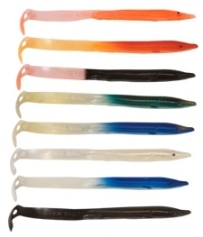
Editor's note: Trade Mark UK00001011465 "Red Gill" (note the spelling) was first registered to Swift Fishing Tackle (Kingstainton) Ltd (dissolved) on 21st May 1973 in NICE class 28 - Fishing tackle and appliances (other than nets). Its renewal date is 21st May 2018 (now expired). Accordingly, for the twin purposes of correctness and consistency, all references in book extracts to "redgill" and "Redgill" have been amended to "Red Gill".
Length: all sizesWeight: n/aAction: free swimming sandeel imitator
A true classic and the first real artificial sandeel of its kind. Its unique tail action provides a life-like imitation of an injured sandeel making it irresistible to predatory species - bass, pollack, wrasse, mackerel and garfish. Several sizes are available and you can choose a size to suit both the baitfish in the water and the size of the fish you expect to catch.
Effective from shore when casting over clean and rough ground, estuary eddies and creek mouths and also superb when trolled freeline from a boat on a long flowing trace using just a big swivel to get the Red Gill below the surface. Top colours are white, black, red and even luminous orange at times. Black is the best all round colour especially in low light levels at it gives a big silhouette for fish to see, but the white also works well in bright light conditions and shallow water.
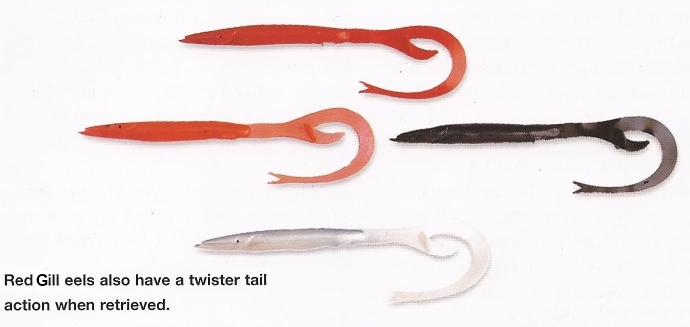
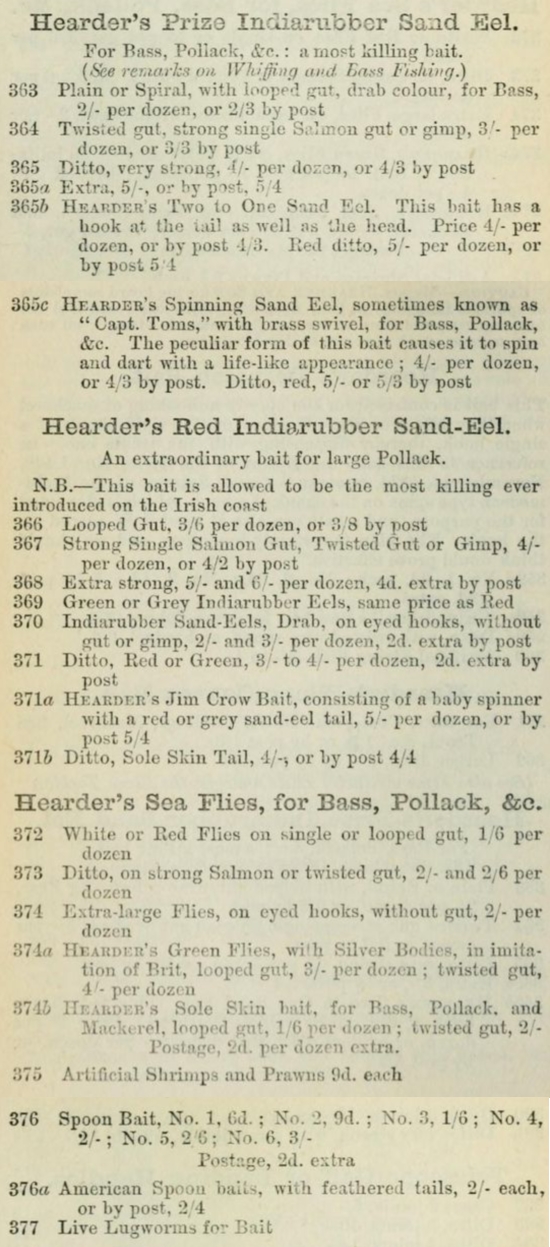
Artificial Sea Baits, Flies &c
"Guide to Sea Fishing and the rivers of south Devon and descriptive catalogue of their prize river and sea fishing tackle, cricket, archery, croquet, umbrellas, parasols &c" (1875 - 7th edition, first published 1800) J. N. Hearder & Son at pages 29, 30 & 31
"The Sea-Fisherman" (1884 - 4th edition) James Carrall Wilcocks at pages 82, 83, 84 & 86
Baits for Whiffing
… may be used both dead and living, which affords a much wider range for choice than in drift-line fishing … in addition to artificial baits, as spinners and imitative sand-eels, with white and red and fancy flies, including a rough kind of palmer or caterpillar made of goat's-hair, which is especially good for bass. In addition to these, we have three valuable artificial baits for pollack, which owe their discovery to accident.
The first is the red indiarubber band, which was, it seems, tried by an amateur short of bait, who happened to have one of them as a fastening to his pocket-book. After cutting it he hooked on one end, and took several Pollack whiffing. It is the custom now to whip one end to the head of the hook (fig. 27), instead of baiting it as a living rag-worm, to which it bears a remarkable resemblance. The most useful size is about 1½ inch in diameter. There are two kinds of these indiarubber rings, one lies flat when placed on a table, the other rests on its edge. The right kind is that which lies flat like a quoit or Saturn's ring; and if my reader will divide one and hold it up by one end, he will see at once the reason it should be preferred, as it hangs in a curl, which causes a rapid life-like action when drawn through the water, and thus becomes very attractive to fish. The action is so rapid that the eye cannot follow it, and it has the appearance of two, instead of one worm on the hook.
The other two baits are Brook's double twist spinning eel or lug and Hearder's Captain Tom's spinning sand-eel or lug-worm (figs. 28 and 29), with which numbers of pollack and bass have been taken, the so-called sand-eel being made of the grey indiarubber pipe placed on the hook so as to form an elbow at the bend, which causes it to spin when drawn through the water, whilst the lug-worm is a red bait of the same kind. Brass swivels are attached to the heads of each to provide for the spinning action. The spinning sand-eel and lugs are taken by both pollack and bass, the grey eel especially in the dusk, as well as by daylight. With the red eel or lug a friend took off Hartland Point over sixty bass 3 to 9 lbs. weight on one visit. Having lived on such a variety of coasts, including rocky, sandy, and shingly shores, some abounding in, and others having little or no natural bait, but on many of which much fish could be taken, I have had to try all manner of things, and have given a considerable variety to choose from in the present article.
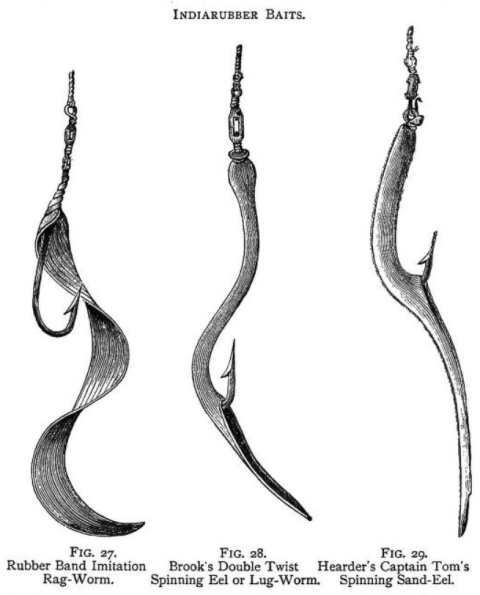
… The artificial baits may also be often used with success, attached to the whiffing lines, and over rocky ground and shallow water, flies are very killing, particularly after sunset. In moderate weather a rod may be used. In consequence of the success obtained by the previously mentioned indiarubber baits in whiffing, the natural baits are not so much used where they are troublesome or difficult to procure.
"Letters to Young Sea Fishers" (1898) John Bickerdyke at pages 116, 192 & 193
X. Artificial Baits
I must not forget the rubber eel, with or without the baby spinner, for this is, perhaps, the most important of the large baits used for pollack, though in some waters it may be less deadly than the feather baits … It is a well-known bait, and kept at all tackle shops. I find, however, that the stout hooks used are often blunt and require sharpening.
XVII. Fishing from a Boat in Motion
Of artificial baits there is an unlimited quantity: red rubber and white rubber sand eels (where one fails the other should be tried), indiarubber band baits, with, or without a baby spinner at the head (see page 115) …
The best rubber eels, which, unfortunately, are not obtainable in the shops, can be easily made out of the black but transparent rubber tubing sold for feeding bottles, and in larger sizes to conduct the air to photographic shutters which are worked pneumatically. Anyone can make them with the assistance of a pair of scissors, a good stout eyed hook, and some well-waxed thread. For large pollack they may be made double the size of those sold in the shops, the hooks of which, by the way, are often very blunt, and require sharpening from time to time on a small hone or a watchmaker's file. When they are catching frequently in the rocks they of course get blunted, and fish after fish will be lost, unless the hook is re-pointed, which, therefore, is a very important detail.
"Sea Fishing for Amateurs" (1904) Frank Hudson at pages 24, 33, 34 & 35
Rod-Fishing
Artificial baits are now universally in request for whiffing, and of these the red or black rubber eel is one of the best. I prefer those with a spinner, but they are often used without."
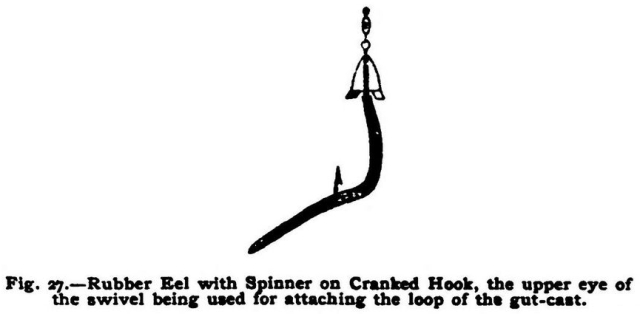
Fig. 27 shows the rubber eel with spinner, extensively used in whiffing from a boat for pollack and bass … Different colours are employed, but the best is made of red rubber, though some prefer black. White or grey rubber eels are very deadly for bass-fishing … Plain eels, without a spinner, are in favour with many anglers, but I always prefer the former, having made large catches with it.
A good plan for catching bass when noticed near the surface is to use a long salmon-rod, and a red eel without a spinner. Let out as much line as possible, and keep the bait playing with the motion of the top joint …
Spinning with a rubber eel is excellent when fishing for bass from rocks - a favourite pastime with thousands of sea anglers. It is not much use trying, however, unless the surf is breaking upon the rocks or the water is discoloured. This dangerous, but fascinating, method may be practised from any steep rock having deep water alongside. Cast your bait out some distance, allowing it to sink; then draw it by a series of jerks towards the base of the rock. A dead sand-eel is also good, worked in the same manner, and pollack also show a great fondness for this lure.
"Practical Sea-Fishing" (1905) P. L. Haslope at pages 62, 63, 65 to 67, 122 & 147
Chapter VI: Artificial Baits and how to Make Them

VERY sea-fisherman knows how difficult it is on many occasions to procure natural bait, especially in rough weather, and at these times artificial lures become extremely useful. They principally consist of spinners rigged up in various ways, often differing very slightly in construction, and are intended to represent launce, sprats, herring, fry, or "brit", upon which such fish as mackerel, pollack, coal-fish, bass, and others largely subsist. The first attempt at making a spinner was a piece of bright tin, with a hole in it, attached above the hook, an arrangement which was locally known as a "shiner". This did not revolve when drawn through the water, and only of late years has the proper method of bending the metal been discovered. It should be noted that artificial baits are not suitable for ground-fishing at anchor, and only acquire their attractiveness from motion imparted to them, as in whiffing, railing, and other methods.
Rubber Eel

Of all baits used in whiffing this is the deadliest, and is now employed successfully all round the coasts of Great Britain. The fish principally caught by it are pollack, coalfish and bass, but others will occasionally take it. For pollack there is no other lure which can compare with a good rubber eel, and in whiffing it will generally catch more fish than any kind of natural bait, as I have many times proved.
It is most important that it should revolve or spin quite easily in the water, and to obtain this motion the hook must be cranked as depicted in Fig. 44. At a point 1 in. from the top of the ring the shank should be bent to an angle of about 140 degrees; thence it is straight for another inch, when it is again bent, a process which turns the point outwards and enables a better hold to be obtained on the mouth of a large fish. Rubber Eels are sold of different sizes, but a useful medium is obtained by using No. 6/0 ringed Limerick hooks. These may be procured ready cranked from the nearest agent of Messrs. W. Bartleet and Sons, Abbey Mills, Redditch, and should be tinned or galvanised …

Much difference of opinion exists as regards the best colour for the rubber tubing, but a yellowish-red shade appears to be the most enticing to pollack. Black or grey is often used, the latter being very attractive to bass. On the whole, however, I have found red eels to account for most fish … Fig. 47 represents a rubber eel ready fitted for fishing, before attaching it to the cast or trace. The rubber when adjusted upon the cranked hook should be tied at the neck above the lower eye of the pin with a turn or two of waxed red silk, to prevent its slipping down. These baits are frequently used without a spinner, which renders their construction more simple; but in whiffing from boats the presence of the glittering metal must form an additional attraction.
A gentleman informs me that he sometimes coats the black rubber with metallic paint to make it silvery, and has taken a good many fish by this plan. The paint will wear off after a day or two, but may easily be renewed.
Chapter IX: Whiffing and Railing
Whiffing
Method of Fishing
… For catching bass there is no better bait than a rubber eel without a spinner, using the long line and a salmon-rod with rather a pliant top, which imparts a lively motion to the eel. Having plenty of line to allow, there will be no difficulty in ultimately killing a bass, which fights, like a gentleman, on the surface, and does not bore down to the weeds. With a large pollack, on the other hand, great care must be exercised, and strong tackle, combined with a stiff, short rod, is absolutely essential …
Chapter XI: Rod and Hand-Line Fishing from Rocks and Piers
Bass Fishing
… One of the most reliable lures is a red rubber eel without a spinner, and the size should be rather smaller than that used for whiffing. This should be cast out as far as possible, allowed to sink, and then drawn gradually to the foot of the rock. If there is much wash, the waves themselves will assist in playing the bait without great exertion on the angler's part …
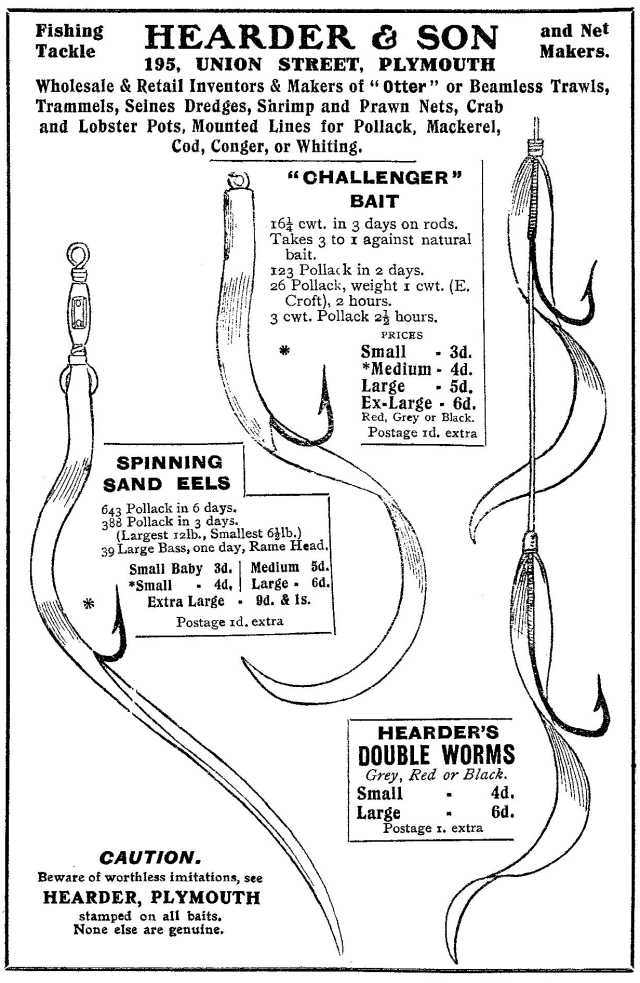
"Sea-Fishing" (1911) Charles Owen Minchin
"Bass: How to Catch Them" (1955) Alan Young at pages 35 & 36
Chapter II
Tackle
Lures That Do Not Spin
First among these is the rubber eel. These lures are almost as old as sea angling. They have stood the test of time and have accounted for innumerable bass, and it is probable that they still still lead the field. They are of simple construction, consisting merely of a piece of trimmed rubber tubing fitted over a hook. The end of the tubing is shaped to a point and extends well beyond the hook. I look for two points in commercially made varieties. The metal preceding the hook shank should be malleable, so that any degree of curve can be put on the lure; and the rubber should be supple, so that the "tail" works easily in the current. Many rubber eels are too stiff, and it should be noted that supple one tend to stiffen after considerable use in salt water.
Rubber eels are made in a wide range of colours, and on this subject I have no advice to offer. Bass have been caught on every colour there is. I usually tie on a dark-coloured one in very clear water and a light one in thick water, but every locality has its pet colour.
The ordinary rubber eels are excellent lures, but in the past two years I have used them much less often in favour of Porosand eels, whose action is extremely lifelike.
"Tackle Sea Angling this Way" (1964) John Michaelson at page 74
8. Bass Fishing
Rubber eels, so effective for pollack, can be tried from a boat. The favoured colour varies in different places and at different times. If you have no success with red, try a black or yellow.
"Pelham Manual for Sea Anglers" (1969) Derek Fletcher at page 13
Artificial Lures
There are numerous artificial lures for sea fishing. One of the most reliable and productive is the rubber sandeel which can be used for bass, pollack and other mid-surface fish.
They are made in various colours and it is a matter of experiment to discover the best for your area. In use the eel must be sloped in shape and not straightened. Its correct movement through the water depends on the slope.
In selecting a set of artificial sandeels choose those made of the most pliable rubber. There are types much too stiff and soon rejected by the fish. It is also important that the hook is needle sharp.
"Competition Sea Angling" (1970) Bruce McMillen at pages 40 & 41
3. Baits and Lures
Imitation sand-eels
The age-old rubber sand-eel, in a variety of colours, is still in popular use. It will, as always, account for many species of fish such as pollack, coalfish, mackerel and bass, not only by spinning but also by trolling. Similarly, there are more modern and realistic imitations of this bait, notably the 'Mevagissey' sand-eel, as well as various jointed versions. The 'Porosandeel', although only a strip of very pliable plastic, gives a truly wonderful impression of a live sand-eel when it is drawn through the water.
"Estuary Fishing" (1974) Frank Holiday at pages 36 & 37
Chapter Two
Boat Fishing
Spinning
The traditional lure for spinning in the sea is the rubber or plastic sand-eel. The orthodox design is a single-piece eel sometimes with a mackerel-spinner mounted on the nose. Modern eels, such as the Red Gill, are far superior to the old-time baits both in appearance and in performance. An angler who is very successful at spinning for bass makes his sand-eels in two sections out of soft plastic with a single 2/0 hook mounted on the underside … These comparatively light baits need to be slightly weighted for casting. A small anti-kink lead, mounted in front of the nose, is usually sufficient. Even so, it will probably be necessary to pause for a few seconds after casting before winding the ell back to the boat. If one is after pollack quite a long pause may be needed because this species usually lies deep. Wind slowly and steadily with the occasional pause remembering that fish often stalk a bait before seizing it.
"Wreck Fishing" (1975) (Osprey Anglers) Clive Gammon at pages 39 & 41
4. Equipment
… Artificial lures play an enormous part in wreck fishing, and they are the subject perhaps of most wreck fishing talk in pubs where anglers gather after the day's sport. One lure, above all others, stands out as supreme. This is the 'Red Gill' plastic sandeel, developed by Alex Ingram of Mevagissey. These eels, by reason of the design of the keel and the pliant tail, look extraordinarily realistic to the angler in the water and they clearly make the same impression on fish because they are taken with greater avidity than any other lure, particularly on days when fish are not feeding as extensively as they sometimes are - when almost any lure will catch them. While anglers are agreed on the efficacy of the design, they will argue for hours over the best colour to use. In the 1973 season, for instance, in Plymouth it was the black and dark brown eels that were most fashionable. At other times the green and silver eels, and sometimes the blue, have had a vogue. An angler whom I met recently swore by completely transparent Red Gills - he had been given a batch of rejects which had not been coloured and found them more effective than the properly finished article. You can have a lot of fun colouring Red Gills for yourself with waterproof ink markers, but to be perfectly honest don't believe that fish discriminate to any great extent between differently coloured versions. It is the seductive movement of the Red Gill in the water that draws the fish, I am sure, and the colour factor is secondary. However, the point makes a good basis for long evening discussions at the bar.
While the body of the Red Gill could not be bettered, most experienced anglers don't use the hooks that are supplied with them, but for big pollack and coalfish replace them with bigger hooks in the 6/0 to 9/0 category. This certainly makes sense, since these have much greater holding power where heavy specimens are concerned.
Red Gills are rather expensive at 40p. a time when you tend to lose a few on every wreck fishing trip, so that when fish are feeding really freely there is a good case for substituting the cheaper or multicoloured rubber eels. These have been fish killers for at least a hundred years, and though they may be marginally less attractive than Red Gills are very worthy of a place in the tackle box. The only rubber eels that you really should avoid are not rubber at all but of stiff plastic. They are a good deal cheaper than other eel imitations but they lack the lifelike movements in the water that soft rubber or soft plastic gives and although they catch some fish they are always outfished when worked alongside the other kinds.
The other artificial lure I have mentioned at different times throughout the book is the pirk … I prefer the traditional Norwegian model, heavy and expensive as it is. Pirks are most useful in seeking out the bigger fish - bigger than average, that is, even for wreck fishing. When natural bait is added to the treble hook they become deadly for big ling and cod. You have to be a great deal more careful about using a pirk in wreck fishing, though, than you do with Red Gills. Normally, when you are fishing a trace of three Red Gills, the lead actually hangs below them and should be attached by a weaker link of line so that if the lead itself goes fast in the wreck you can pull for a break and still save your eels. This is not possible with a pirk which goes at the end of the line with its anchor-like treble hook. If you do go fast with a pirk your only chance is to react immediately and drop your rod tip to give a slack line, when sometimes the hook will come free. Your reaction has to be instant, though, because once the bait starts to drift away and the line is at an angle you will never free it. There is no sure way of not losing a pirk. All you can do is to listen to the skipper who will be watching the echo-sounder, and haul line the minute he yells a warning that the boat is passing over superstructure and the like.
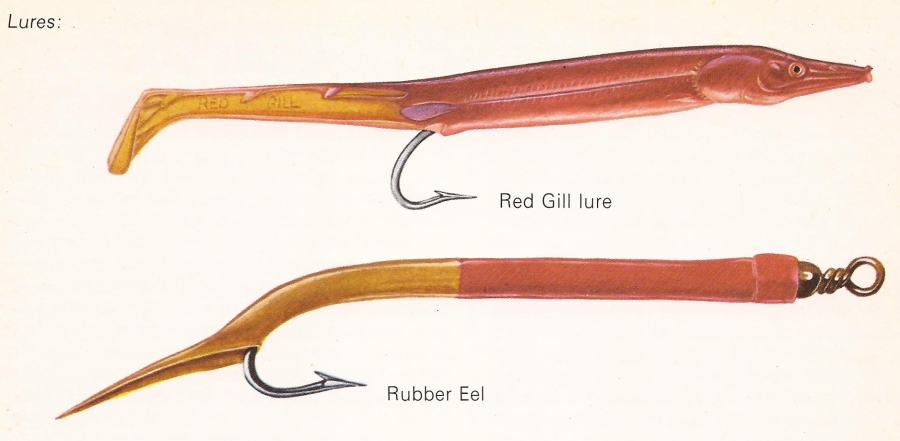
"Sea Angler's First Handbook (Pan Anglers' Library)" (1975) Alan Vare & Arthur E. Hardy at pages 108 & 110
Sea Fishing Methods
Spinning, Trolling, Pirking and Feathering
… Another artificial lure which comes almost into the spinner category is the 'sandeel', usually made from rubber tubing over a large single hook, and the rubber is usually of a red, white or green colouring. In our own experience, the red or white seem to be the best attractors. An improved variety of the sandeel is the 'Red Gill', an imitation sandeel made from moulded rubber, again with a single hook at the business end, and which we regard as probably the best all-round artificial lure for salt water angling …
The general success of all artificial lure fishing relies upon one basic requirement - the fish must be able to see the lure. Consequently, you'll get the best results in clear water, with proportionately less chance as the water gets muddier or cloudier. That's why rocky coasts are generally better for this method, and why the river estuaries of the south-east coast of England rarely produce fish on feathers, pirk or jig - the fish simply can't see the lure through the muddy water. For the same reason, night fishing is rarely productive, but sometimes, in the last light of the day, or when a bright moon glows overhead, the mackerel can be taken, usually quite close to the surface. Alternatively, if your local pier or harbour wall is well lit, at night, you could fish the feathers, or other artificial lures, well on into the night.
"Fisherman's Handbook" The Marshall Cavendish Volume 1, Part 17 (1977) Mike Millman at pages 470 to 473
How to Fish
Sea Trolling
Red Gill
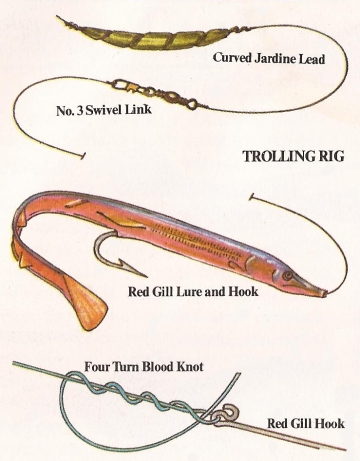
Red Gill, the brainchild of Alex Ingram of Mevagissey, is now a fourth generation lure. His latest innovation is a specially shaped hook, fitted to the large Thresher model, which prevents the body of the lure being detected and pushed up the line, when a fish strikes at it. Of the five models offered the 172mm size is by far the most successful.
In the last couple of years, however, the Eddystone Eel, produced by David Beer of Plymouth, has proved a serious rival. It has a softer tail made from ultra-thin plastic which gives a faster action, making it suitable for trolling at slow speeds without losing its attractive motion. The Eddystone Eel is available in a number of sizes but the medium model of 190mm gives the best results.
A new lure, the Eddystone Troller, which has an all-through action will possibly be the best yet. This lure was the result of an enormous amount of research, done with the cooperation of the expert bass anglers who fish Eddystone, Britain's top bass mark. The spectacular catches are made over the gullies close to the lighthouse itself, where giant bass, some weighing as much as 20 lb, are common. But catching them has proved impossible so far.
Artificial eel
The best rod and line capture made on an artificial eel is the British record bass of 18 lb 14½ oz taken by Roy Slater in 1975. The biggest fish are extremely wily, and refuse to be tempted by anglers' lures, but hundreds of fish weighing between 7 and 14 lb are taken each year. To contact them requires a thorough knowledge of the reef, for the only way they can be caught is by trolling the lure at least 100 yards behind the boat, taking it right through the jagged gullies. The rocks on either side rise to within a foot of the surface, and even a slight knock against the gneiss rock will hole the stoutest craft.
The bass anglers at the Eddystone, rightly known as the most dangerous reef in the English Channel, fish alone, and this presents problems. To leave the tiller or wheel for just a moment in the turbulent waters when the boat is under way, even at three knots, is asking for trouble. To avoid it, rods up to 15ft long and fixed to special holders mounted in the stern are used. When a bass hits the lure, the length of the rod first cushions the powerful strike and then its spring back, combined with the boat's forward speed, drives the hook home. At this point the boat's engine is knocked out of gear, leaving the angler free to net the fish.
The experts have tended, in the past, to use lures of their own design, jealously guarding their secrets. Tempers have risen sharply when lines have crossed and one angler has wound in and seen the other's lure. Home-made varieties are now less common but a few anglers still modify commercial lures in various ways in the hope of gaining the edge over rivals.
Usually two rods are used at once, and these are matched with multiplier reels filled with 35 lb b.s. monofilament line and 25ft traces of 25 lb b.s. The size of lead depends on the strength of tide, speed of the boat, and depth the lure is to be fished, but 1 lb is the average weight. The best patterns for trolling are those whose centre of gravity is below the level of the line, which prevents twisting or kinking. A curved jardine lead is mounted by running the line around a continuous groove and spiral wires at the ends of the lead. This kind can be changed without cutting the line and is very popular for that reason.
Trolling for pollack
Trolling for large pollack on offshore reef marks requires a similar approach. During the day, the fish swim near the bottom, so trolling is best at first light and in the late evening when they rise to within a few feet of the surface. As with the bass, it is vital to work the bait a long way behind the boat, where it is well out of the way of engine noise and propeller turbulence.
Working a lure for these 'race' pollack is an exciting sport, and records prove that trolling is one of the deadliest methods for making big catches. An indisputably classic haul was made many years ago, when Captain and Mrs H Millais trolled rubber eels 6 ft below the surface at 3½ knots, off Sennen Cove in the far west of Cornwall.
Their first session, in the early evening, produced 24 pollack and coalfish, weighing 269 lb, which included a pollack of 21 lb and a 20 lb coalfish, at the time the biggest ever caught on rod and line. The following evening saw a repeat performance, when 34 fish totalling 416 lb came to the net. The best specimen was a coalfish of 23 lb 8 oz, which was to hold the British record for a great many years. While these were exceptional catches, there are many instances of hundreds of pounds of fish being taken, at times in a matter of hours.
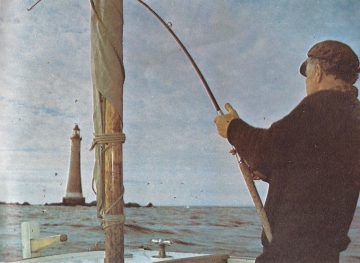
Shallow water
Fishing shallow water close to a rocky shoreline can be very rewarding, especially during the later months of the year, when bass and pollack hunt inshore. The best places to search for them are in the tide rips off headlands. Fine examples that spring readily to mind lie close to Berry Head, in Devon, and Rame Head, Dodman Point, and the Lizard in Cornwall, at all of which big catches are regularly made.
It is best to troll in the early morning, and locals who specialize in this type of fishing are generally afloat by 6.30 am and reckon to have half a dozen good bass in the bag by breakfast. The same trolling tactics are used for fishing close in, but it seems that natural baits, particularly sandeels, catch better in shallow water. Used in a live state, and trolled at very low speeds, success is assured.
Hooks
Eels should be mounted on long shanked fine wire hooks such as the Aberdeen, by passing the hook point through the fish's bottom lip and then nicking it into the soft skin on the underside just behind the head. Presented in this way on a long trace, the eel can swim naturally and will live for some time, thus avoiding the need to change the bait.
Although discussing trolling, it is worth mentioning that live sandeel mounted in the manner described, but offered on a split-shotted 20ft long drift line, as the boat moves along with the tidal run, is a superb method of attracting bass and pollack.
Lifelike movement
Returning to trolling with dead sandeel, it is essential for the eel to be very soft and flexible, so that its movement in the tide will be lifelike. This is best achieved by gently bending the fish backwards and forwards until the backbone is broken in a dozen places. Some anglers prefer to use a thin strip from the length of the sandeel, which is hooked through once at the thickest end of the piece. It is essential to cut the strip evenly, using a thin-bladed, razor-sharp knife. Any suggestion of a jagged edge will spoil the movement aud this will be instantly spotted.
Sea birds are a good indication of fish feeding near the surface, constantly wheeling, and diving over the water. Find them, and you stand a good chance of coming home with a fine catch.
"Sea Fishing For Fun" (1977) Alan Wrangles & Jack P. Tupper at page 73
5. Choosing and Storing Bait
Other baits and home-made lures
One of the most deadly of all the imitation sand eels is the very famous 'Red Gill'. These are really excellent lures for a variety of predatory fish, but especially bass.
"The Guinness Guide to Saltwater Angling: Light tackle technique for British waters" (1977) Brian Harris at pages 53 & 176
3 How to use the tackle: basic techniques
… Spinning can be practised from open beaches as well as from rocky promontories, piers etc, but it seldom works well in water less than about 5 ft (1.5 m) deep, and 15 ft (4.5 m) is usually better. Species that may be taken this way include bass, mackerel, garfish, shad, pollack, coalfish and big ballan wrasse.
Open steep-to shingle beaches are usually better than sandy shallow beaches, and rocky coasts are better than both. Estuaries also provide good opportunities for spinning.
Sometimes a heavy spoon, such as a 1 oz (28 g) Toby, 1 oz Koster, big German Sprat (Condor spoon) or an artificial sand-eel (Red Gill) kept down by up to 2 oz (57 g) of lead - the eel, that is - is necessary to get both range and depth. At other times the salmon-type rod and 8 - 12 lb (3.6 - 5.4 kg) test line necessary for this work can be changed for the single-handed rod and baits weighing only ½ oz (15 g), which may be cast adequate distances with the fixed-spool reel and line of about 5 lb (2.6 kg) test. Whenever this is possible the real meaning of sportfishing is apparent, especially when a 5 lb (2.6 kg) bass, a 1½ lb (0.6 kg) mackerel or a 6 lb (2.7 kg) pollack grabs the lure.
11 Bass
Spinning can be good active sport from some piers and seaward projections, provided the water is fairly clear - visibility from above should be for a distance of at least 8 ft (2.4 m) down into the water. Spinning in murky water seldom works for saltwater fish.
The Red Gill sand-eels, the soleskin lure about 3 in long (7.6 cm) with a small mackerel spinner at its head, Toby, Condor, Koster and Ellips heavyweight wobbling spoons, even a silver Devon minnow about 2 in (5 cm) long with a willow-leaf shaped piece of chamois leather about the same length on one hook of the tail treble, will work at times. Carry a selection. Make casts far out where tide-races form, along weed-covered walls; fish deep and fish shallow, fast and slow. Usually the artificial sand-eel recovered at a modest pace around midwater will find the fish. The wobbling spoons in 1 oz (28 g) or heavier will usually cast far enough and fish deeply enough without additional lead.
For the rubber sand-eel and soleskin lure a bomb-shaped lead suspended from the top eye of a size 8 swivel which links a 4 ft (1.2 m) trace of matching nylon to the main line by a few inches of nylon will serve as sinker, anti-kink device and it will cast much farther than the more usual Wye or spiral spinning leads used.
In a boat, a dinghy close to the shore or a bigger boat way out over reefs or wreckage, shoaling bass may be tackled with trolled Red Gills or spoons, strips of mackerel and squid, or by casting and spinning such lures and baits from an anchored position. When tackling bass from a boat it is usual to first find the shoal by looking for birds working, especially terns. The bass may be feeding on sand-eels, whitebait or shoals of mackerel, even whiting and pouting that are tumbled around in the turbulence of the water flowing at speed over the obstruction. Then it is essential not to motor into the shoal but to keep to the edges, casting along the shoal's edge. A lure right in among the shoal may be ignored; a lone lure wriggling or twinkling along the edge in open water stands a better chance of being taken.
Spinning for bass is usually best in the period from late June to mid-October when there are shoals of either mackerel or of sand-eels, whitebait and sprats …
"Cod Fishing" (1978) Bob Gledhill at pages 102 & 103
Chapter Four
Boat Fishing
Other Lures
The rubber sand-eel is something I've had great fun with for catching cod. I would never describe it as a deadly method, but it's so different from the way cod are normally caught from a boat that it is very pleasurable. There is no better eel than Alex Ingram's Red Gills. I think the long-vaned tail has a lot to do with it. If you hold one in a current, the tail wiggles away sending vibrations in all directions.
To tackle up with an eel, use a French boom and attach the eel by at least eight feet of line. This very long length allows the eel greater freedom of movement. The stronger the current you fish in, the better will be the action of the eel, in fact with very little current the eel won't have any movement at all. Apart from cod, there are many other sea fish that will go for an eel in this way. To get a fish in, you reel the tackle to the rod tip, then handline the long trace to the side of the boat.
"200 Sea Fishing Tips" (1982) Ivan & Ivor Garey Tip 79
12. Artificial Bait
79. The Red Gill - a great bait
The Red Gill is a plastic imitation of a good-sized sand eel. One's first impression is that this is nothing new - there are plenty of other fish imitators on the market. The special feature of the Red Gill is its crosswise tail, which makes it waggle its behind in the most seductive manner! It is said that the Red Gill is such an excellent bait that it even provides a living for professional fishermen, who drag it on very long traces and thus catch plenty of bass. Peter Lobbs, one-time secretary of EFSA … sings its praises and taught us how to use it on a fishing expedition in Scottish waters. The lure is tied to a 4m long, 25lb or 35lb trace, which is connected to the reel line via a long angled boom or a long metal boom. A 150g (5oz) lead takes the lot down to the bottom; the line is then slowly wound in. We caught ling, codling, coalfish and pollack with the Red Gill - all large specimens.
""The Sea Angler's Sporting Fish (1985) Mike Millman at pages 39 & 40
Bass
… Many fine bass are caught by trolling close to the land. Artificial lures such as the deadly Red Gill get the best results, but one must ensure they are worked at least one hundred yards astern of the boat, well clear of propellor vibrations. For boat work a long rod is essential to help cushion the tremendous strike from a large fish. This is matched with a multiplying reel of medium size filled with 15-20 lb monofilament. The correct trolling rig is a twenty foot trace joing a swivel. Above this a jardine lead of at least 8 ozs is threaded on the reel line. With lead core lines, for example the Gladding Mk V Dacron, 30 lb breaking strain, weights are unnecessary, which greatly improves the action of the lure.
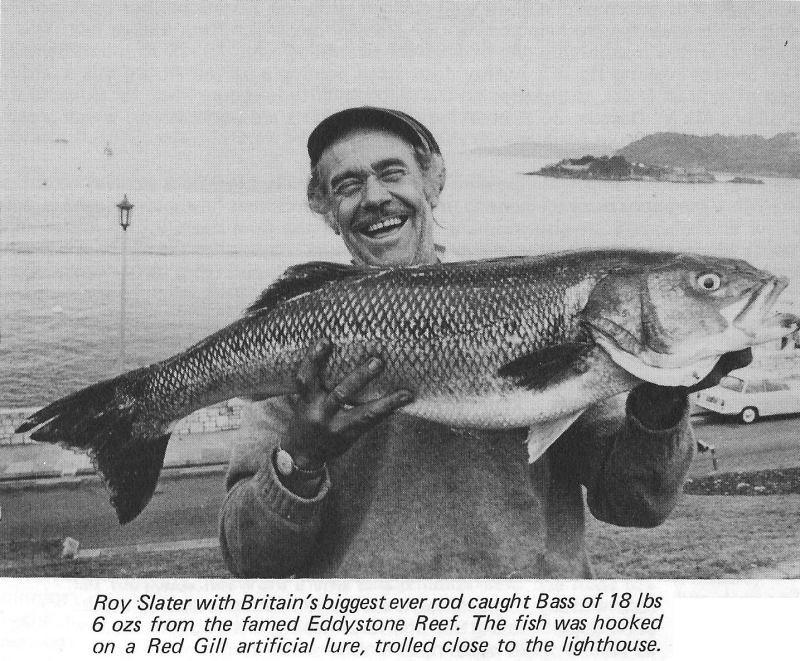
"The Graeme Pullen Guide to Sea Fishing Baits" (1988) Graeme Pullen at pages 112 to 114
Artificials
For the 'biggies' you need to use the largest size Red Gill artificial rubber sandeel, which is devastatingly effective, and has a built-in tail wiggle that is pure seduction for pollock and coalfish. I would even go so far as to say that, since the introduction of this sandeel lure on the market, pollock fishing as we previously knew it, has been revolutionised. Most anglers will have a few Red Gills in their tackle box, and if they haven't, they should do.
These lures are best fished from a drifting boat, with a light breeze to push the craft along, and a strong tide to make the predators active. You need to rig with a long flowing trace, as the eel must obviously look as lifelike as possible. If you put the lead too near the eel it will kill that tail-wiggling action, which is what makes it so successful. It's also important to fish with a lead lighter than you would normally use to touch bottom. If the line is going straight down then the retrieve will mean the eel is swimming vertically which, in its natural state, it rarely if ever does. The lighter lead will allow the line to come back to you at an inclined angle, and the takes will be more confident. It's also possible to use the Red Gill at anchor, something which not many anglers realise. At anchor, providing you have a fair run of tide, you can make that eel work by using a very light lead, sometimes as small as one or two ounces.
… A tip here might help you, something I found out myself by accident. When the tide runs hard most baitfish swim, or rather battle, against the current low to the bottom where the flow is slowed somewhat by the friction with the seabed. The pollock will also be working deeper, so when you drop, then retrieve your lure during the strongest tidal flow, do not come up too far. If you are judging the distance by counting the number of times you turn the reel handle, make it, say, twenty turns. When the tide eases, those same baitfish will rise off the bottom followed by the pollock and coalfish, swimming through a greater variance of depths. Therefore you must bring your lure higher in the water to maximise your chances of a take - say forty turns of the reel handle. Also, if slack water coincides with sunset the fish will naturally rise much higher towards the surface, so therefore bring your lure up to maybe sixty or seventy turns. It's only a small point, but it's one of those bits of knowledge that makes a fair angler a good one.
While the Solvkroken rubber tubing eels are perfectly good to use for shore casting for bass, pollock and coalfish, the smaller version of those same Red Gills will outfish them every time. Again, you will have to use a long tail from lead to eel in order for it to retain the most lifelike appearance. This length will be limited by the length of your rod but, as a general guide, I would say don't drop it below five feet if you have a heavy lead of two ounces.
In both shore and boat use of this artificial sandeel, it is of paramount importance not to strike at any bite. What happens when a pollock or coalfish takes is this. In its natural state the eel is quite long, anything from seven inches to twelve inches if it's a launce. The pollock takes the eel from behind by opening its mouth quickly and sucking the eel back. As it does so it folds the eel into its mouth for swallowing, and therefore any premature striking at the initial plucks where the pollock is sucking at the bait, merely means a missed fish. What you must do is to just keep winding the reel until the fish has sucked in the eel, folded it over for swallowing, and closed its mouth. If you follow this rule you will nail every fish that hits.
The Red Gill sandeel is a must in the tackle box, and in the right hands will catch far more pollock and coalfish than an angler using bait.
"New "Angler's Mail" Guide to Sea Fishing" (1989) Chris Clark at pages 80 & 81
Lure Fishing
Red Gills
This rubber lure mimics the sand eel and on the retrieve its flexible tail flaps vigorously from side to side. It's truly deadly for pollack, bass and mackerel. Red Gills really come into their own at rock marks where there's a fierce tide rip.
Use a long trace
A light 10ft spinning rod, fixed spool reel and 10lb line get the best from these lures and for weight I prefer a spiral lead. Tie up the rig as shown and use as long a trace between the swivel and Red Gill as conditions allow - I fish a minimum of 4ft but on still days this is increased.
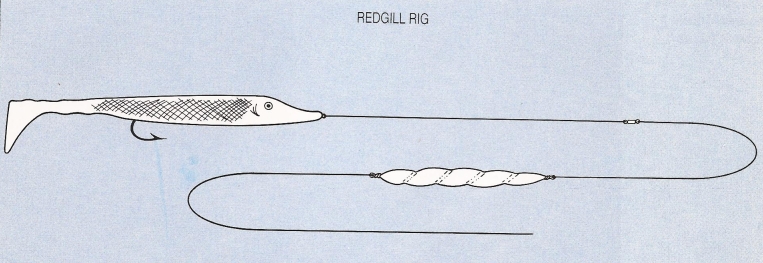
The Red Gill is tied direct to the line by feeding the mono through the hollow nose section. The hook is then tied on and pulled back into the body cavity until just the bend and point are left protruding. Many hooks supplied with Red Gills are far too big for beach fishing and should be replaced with a size 1 or 1/0.
The technique with a Red Gill is to flick it out 20 yards or so into the tide race, pause until it sinks to mid-water or just below and then start a slow, smooth retrieve. If you locate a large shoal of pollack or mackerel sport is sure to be hectic.
"Fishing for Bass: Strategy & Confidence" (1989) Mike Thrussell at pages 75 to 80
7. Spinners and Plugs
… Light travelling into the depths is quickly diffused; it becomes almost non-existent at about 50 m (160 ft) …
… The time of day (in relation to the angle of the sun) plays a great part in how fish see their meals, and also in the choice of lure colour. Bright sunlight and calm seas at approximately mid-day mean that the sun's rays - being directly overhead - penetrate at their best, giving the fish their greatest detail of vision. This is one reason why to trying to catch fish under these conditions is far from easy. The bass probably see baitfish because the sun's rays reflect on their scales, the bass being drawn by the constant flashes of silver as the little fish dart and turn. It's not surprising, therefore, to find that the best spinners used at such times have silver patches with the majority of the body blacked out. Rubber eels and such like are easily seen by the fish to be fraudulent, and so best left in the box - unless you're fishing deep water where the light levels are low. As the sun drops to the horizon, many anglers will tell you that this is the best time of all to fish - but few know why (see Fig. 26).

The shallower the angle of light that hits the water's surface, the more light is reflected or bounced off. Penetration levels fall. Instead of the bass seeing tiny little flashes of silver scales, the best it can hope for is a silhouette or black shadow as a potential food source moves overhead or through the field of vision. The more the light level falls the darker the lures should be. At night black redgills are excellent - they are so, too, even during the day if the surface of the sea is rough and choppy and light levels below are poor. Silver toby spoons and similar may still be effective, as might silver-bodied plugs.
If the water holds some colour and vision is down to a minimum, use a large, white redgill for maximum visibility. I believe that the wagging tail of the redgill eel gives off some vibration, and that the bass picks this up through its lateral line system. Some experiments I've done with night-time spinning and plug fishing show - conclusively, to my mind - that lures that have a wriggle either through the tail of an eel or a double-jointed plug produce fish when light levels are almost nil. Some anglers talk about 'pollack light', which occurs in the evenings over rock marks and the like. During the day catches can be very mediocre, but as the light level falls so the fish feed better. What's happening, I believe, is that during the day the pollack (having good eyesight) see defects in the design of the lures and know something is wrong. With the fading light, all it sees is a fleeing baitfish. So it is with bass.
Bright conditions, with no surface agitation, send the fish deep, so it's pointless spinning shallow marks or flitting a lightweight lure across the surface film. Instead, go deep to find the fish. Bad weather and coloured seas may see fish on the surface, even over shallow ground. The type of bottom over which you are fishing has a great deal to do with the water's clarity: obviously, deep, still water will be clearer than shallow, faster moving water, because of its scouring action. Deep water, say, 6 m (20 ft) or so over a sandy bottom, may have good light levels because the sand reflects the light back, whereas a rough, rocky bottom is non-reflective and so the water is less clear. Over sand, bass may see a silhouette when observing prey below them, so darker lures are more effective. The colours chosen for use over rough ground should tend towards lures of a lighter hue.
How do bass attack an artificial? I think they anticipate the path of an intended meal and intercept it much as a person with a gun leads a flying duck - a high percentage of strikes are hit from the side. But bass are quite capable of swimming upwards and from behind a baitfish, swallowing it whole. This is a question of the size of the baitfish in relation to that of the bass. My own findings suggest that a bass is easily able to swallow whole a fish a tenth of its own size.
In plug fishing, bass are hooked by the tail hook, by the tail and mid-section hook together, or sometimes by the middle hook. When you're spinning a Red Gill, occasionally you can feel a bass pull the tail of the eel but miss the hook. I always thought this was because the bass came up close and didn't like what it saw, but a simpler explanation is that the bass calculated its angle of interception wrong by and missed - perhaps the angler speeded up the retrieve at the wrong time. Even birds of prey can only expect a 50 per cent success rate, and probably bass are the same. I've had a few bass on spinners foul-hooked outside the mouth, probably a result of the bass attacking the middle body of the spinner - as it does so the angler feels the line tighten and strikes, pulling the hooks into the outside of the jaw.
Some thought must be given to lure size. There's little point in using a 20 cm (8 in) diving plug if the fish are hitting 5 cm (2 in) sprats on the surface. It pays to carry a range of sizes extending from tiny revolving spoon-type lures to plugs and spoons 30 cm (12 in) long, so that, again, you can 'match the hatch'.
By the end of April the sea is beginning to clear from the February and March storms and at this time bass use the rough-ground beaches to hunt crabs. None the less, they will hit a lure if confronted by the right one. One way to fish this situation is for you to don a pair of chest-waders and to wade out a few metres (if the beach is shallow) for you need a depth around 1.5 or 2 m (5 or 6 ft) for the bass to see the lure properly. I prefer to find some really snaggy ground with fair-sized boulders and a moderate depth of 2 m (6 ft) or deeper. There will probably be a little surf to contend with.
Silver tobies of 28 g (1 oz) are excellent over this type of ground - it's just a case of cast and use a steady retrieve. Don't be tempted to let the spinner rise and sink by altering your speed of return - you haven't much to play with before you snag up, and the fish will see the silver flash as the spinner goes by if it's worked nearer the surface. Red Gills are very effective, but only in the deeper water. To get any casting distance out of the Gill, it's necessary to fish it on a paternoster, which means the lead leads the eel during the cast. I use a 0.9 or 1.25 m (3 or 4 ft) trace to the eel and about 30 cm (1 ft) of line to the lead on a three-way swivel. Over shallow, rocky ground the lead obviously keeps bumping into rocks, spoiling the eel's action, which is also heavy on tackle (see Fig. 27).

This situation is suited to plugs, especially floaters. Your casting distance will be cut, as floating plugs obviously don't carry much weight. You tease the plug through small channels, between and around boulders, and across the flanks of weedbeds. If the plug has a vane that can be preset to give a choice of depths at which to fish, then set it on its steepest setting, which makes it ride just below the surface. You can reel in a metre or so of line, then momentarily stop - allowing the plug to rise and float. Then, as you wind in again, the plug dives. This imitates a wounded fish trying to swim in short jerks.
You'll often see bass take your plug before you feel anything on the rod. Usually there's a slash on the surface as the fish hits the lure on its upward motion. Sometimes there's a boil as the fish turns away. Perhaps a flash of its silver flanks is as much pre-warning as you'll get. Bass work very close in around such boulders, and casts around 18-27 m (20-30 yd) are often enough, but again it means you must employ every scrap of available cover to hide your presence.
When a bass is hooked, it will head straight for the nearest rock or snag, so heavy but controlled pressure is needed from the start. Make sure the fish is well and truly tired before you bring it into shore. It pays, under calm, clear conditions, to walk the beach to try to find some water that holds a little more colour and suspended sediment - you'll find fish may feed here on a surface plug when the rest of the beach is dead. Deeper areas I fish with a sinking plug (preferably one with a jointed action), simply bringing it home on a steady retrieve. When a fish hits it feels as though you've snagged up, then suddenly the snag moves.
With experience you won't lose too much tackle, but if you do become snagged don't yank feverishly on the rod. Release 0.9 or 1.25 m (3 or 4 ft) of line. Then, if it's a boulder, a quick tightening of the line will often pull it free. If the plug has nosed its way into a frond of weed, give out line - often this will allow the swaying of the weed in the current to dislodge the hook. If all is fast, put the rod down, wrap the line around your fore-arm, and steadily increase the line's tension. Don't yet pull for a break, just keep the tension on and after a couple of minutes the hooks may cut through the weed. By all means, try altering the angle of the line by walking left or right, though this is not always possible on rocky beaches. Always break out using your fore-arm - never your rod, it's better to lose the plug than break your pole.
Just as in bait fishing, you'll discover little corners that fish continue to visit. These are often little bays that act as wash-ups after storms, where some current is formed as the tide crosses shallow ground, and the dropoffs where the shallows become deeper. Even the surf-line on open beaches can be covered by artificial baits. Shallow surf-strands hold good numbers of school bass and by throwing out a small redgill on a paternoster, you can enjoy some sport. Although this is a small-fish technique, bigger fish occasionally turn up. Certainly the lead being dragged across the sand doesn't seem to put the bass off and may well help them to find the eel. The same system can be used with a small, silver spinner fished solo. Look for a slight chop on the water, not mirror calm.
"Sea Fishing: Expert Advice for Beginners" (1991) Trevor Housby at pages 62 & 66
Rubber Eels
Many anglers … prefer to use rubber or plastic eels. Both the Red Gill and Eddystone patterns are deadly fish catchers. The colour of eels varies from day to day. When fishing the artificial eel, size of lure is often of vital importance. Do not make the common mistake of believing that big fish prefer big baits. On the contrary, while fish on a virgin wreck may initially hit just about anything that catches their eye, once the wreck has been fished on a regular basis they can become extremely selective. Educated fish will in fact rather pursue the smallest artificial eel they can find. While large eels may look impressive to the angler, they can terrify fish.
… the artificial eel is a lightweight bait needing a pirk or lead to get it down to fish level. Fished on a rig of this type eels can be excellent fish catchers, particularly of big cod, while pollack and coalfish prefer the artificial eel fished on a long-flowing trace.
The successful angler should be prepared to change rigs until he discovers the right combination. Preconceived ideas seldom produce big catches; a variety of rigs must therefore be carried and used. You cannot go wrong by watching others catching fish, taking note of their terminal tackle, then trying to match it. Never be satisfied. Try to think like the fish you hope to catch. Take mental notes of taking depths, speed of lure retrieve and the types of bites you are getting. When you feel a fish biting do not ever stop winding. If anything, increase the speed of retrieve.
A hunting fish expects a live eel to try and escape. If the bait stops moving the fish will take fright and vanish. Pollack can be especially finicky biters. Often they will follow an eel gently mouthing at its tail. If you speed up the retrieve the fish will usually slam into the bait. This induced-take technique can often save a poor day.
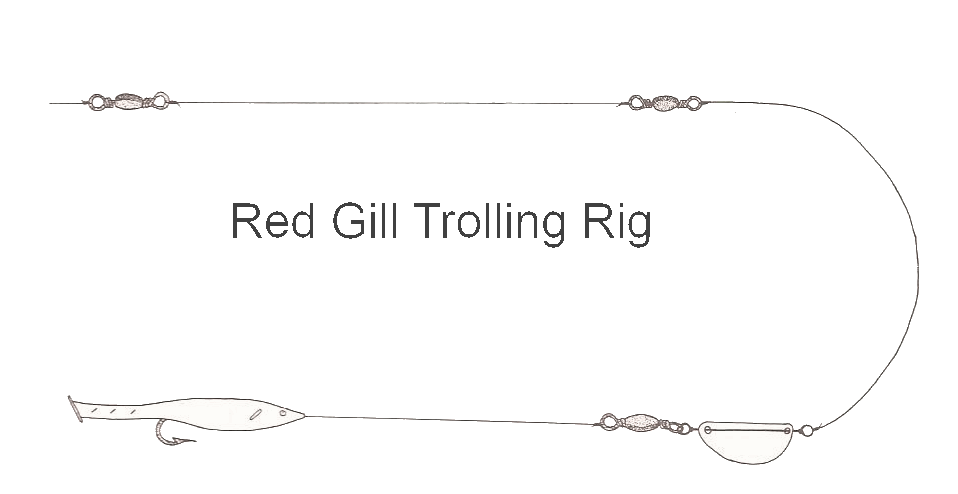
Red Gill Eels
Probably the most successful sea fishing lure in Britain is the Red Gill eel. Originated by the late Alex Ingram of Mevagissey Cornwall, this is a minor masterpiece which has a fast tail-waggle that few fish can resist. On days when fish are being finicky the Red Gill eel usually catches more than any other lure. There was a time when a simple rubber eel was good enough to score on any occasion, but fish learn quickly. On a well fished wreck or reef they soon learn to differentiate between an imitation and the real thing. The detail that goes into the make-up of a Red Gill eel can then make a massive difference.
Red Gill eels come in three sizes - large, intermediate or small. Colour may be a critical factor. In deep water, black or red may be the killing colours, while in shallower water, white, blue or silver may be the successful colours. Charter boat skippers usually carry a range of marker pens to change body colours, which can often make or break a day."
"The Complete Book of Sea Fishing: Tackle and Techniques" (1992) Alan Yates and Jed Entwistle at page 106
11. Tackle Basics
Artificial eels
These are popular fish-takers and there are a number of differing eels available. Early types of eel consisted of a strip of coloured rubber or surgical tube slid over a hook, the tube sliced off with an angled tail below the gape; sometimes the hook shank would be offset and a swivel might be set in the eye. Eels of this type are still available and work well where there are still plenty of fish competing in the food chain.
The Mevagissey eel was an improvement on the earlier version, a two-piece, translucent, coloured body with a separate flexible tail that successfully enticed fish where the competition was less fierce. This inspired the Red Gill, an injection-moulded artificial eel and the first of the modern generation in use today; amongst these the Delta and Eddystone eels are leading rivals. All rely for results on subtle differences in tail action. They are also quite detailed in their finish; as well as single-coloured models, there are eels whose subtle colour changes and translucence may increase the fish-catching qualities. Other offerings have also been produced in the shape of various fish, though rubber or plastic eels remain the big seller in British waters. They are available in a range of sizes and colours.
"Estuary Fishing Afloat & Ashore" (1995) Dave Lewis at page 55
6. Fish Species
Bass
Lure fishing for bass has attained almost cult status in recent years. Although not always as successful as bait fishing, lure fishing provides tremendous sport, allowing the use of the lightest tackle. For general spinning, almost any sort of spoon or spinner will catch bass, but artificial rubber sandeels can be deadly. It is often the smaller sizes that catch both the most and the biggest fish.
"The Art of Wreck Fishing" (1996) Stu Arnold at pages 30 to 40
3. Methods and Tackle
Drift Fishing
This method is split into two main areas; artificial lures and bait fishing. It involves the boat using the tide and wind to pass over, along, or around the wreck, presenting baits more naturally to the fish, at various depths and speeds, especially species that constantly move around and chase their natural types of prey. This enables the angler to use lighter and more sporting tackle in some instances, with lighter lead weights than are necessary whilst at anchor.
Drift fishing wrecks is popular all around our coastline, and is probably responsible for taking the highest percentage of fish for the angler nowadays. It was the main method in the early days of wreck fishing and still is now.
Red Gilling
A household name in the sea angling world and still, by far, one of the most popular and enjoyable ways to fish a wreck.
Red Gills are a type of artificial lure, developed from an idea by Alex J Ingram just after the war. The original lures were known as Mevagissey sandeels and, in 1968, the first Red Gill lure as we know it today was launched. These lures were made first of all by Alex to spin with from beach marks and rocks, and it was not until the early 1970s that the potential of these baits for wreck fishing became apparent.
Red Gill in fact is a registered trade name for a selected group of products, all artificial eels of various sizes, and has nothing to do with the colour red or other kinds of artificial eels in the marketplace today. Red Gills come in five main sizes so whatever kind of baitfish is flavour of the day with the predators below, there is a lure to imitate it.
This is important when drifting a wreck, because if the pollack are feeding on sprats at the time, the small Red Gills of 4 to 5 inches are the ones to use, and if they are feeding on mackerel and herring you should use the appropriate size of lure to maximize your chances of that big catch. I have seen the fish change preferences for size of lure on the same day or state of tide as the fish move out from the wreck, so to capitalise on your day's fishing you must be aware and change your lure size if the fish are coming slow or not taking at all.
Red Gills also come in a wide variety of colours and we have found by experience that, as with size, colour is important too. This is dependant on the depth of water that you are fishing; the deeper the wreck is the darker it becomes. Fish see a totally different end of the spectrum than we do, especially in depths of over 130ft, where dark colours become visible to a fish and lighter shades harder to see.
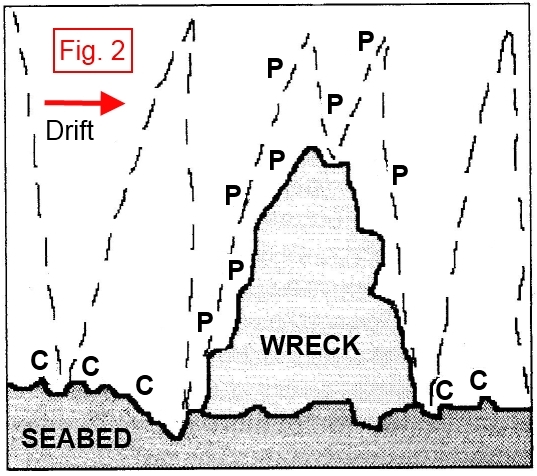
Without doubt, in these deep waters black and dark red are supreme in any size of lure and account for probably 96% of all the pollack, cod and coalfish that have been caught on my boats, and this is definitely the same story around the coastline.
So far as inshore wreck fishing goes, in depths down to a maximum of 130ft the lighter colours can work for you, especially as far as bass are concerned.
In shallow water where light comes into play, the most effective lures are the silver belly, green and blue-backed lures, which bass find irresistible but, unlike pollack and cod that will take a shop-bought lure freely - kinks and all - the bass needs special attention. All lures when purchased have a distinctive kink in the tail caused when the lure is taken out of the mould and bass can see the difference clearly in the way that the lure swims during retrieval. All that you need to do is make up some simple stretchers for the lures from soft aluminium plate, folded so that the Red Gill can lay supported between two points; one side for the head and the other for the tail. Dip the tail section of the lure into a mug of hot water and then place the lure in the stretcher and ease out the sides. After a few days in the stretcher the tail section, which started off with a slight kink, will now be perfectly straight and, believe me, this makes all the difference if you want to catch specimen bass on Red Gills.
If you research the fish that you want to catch, buy the correct colours and sizes of lures for the job in hand as well as looking after your lures, it will pay dividends.
Red Gills and other similar lures are designed to be fished as deep water spinners, fixed to a long length of trace line on special booms worked up and down in the water all around and over a wreck, so as to pass through fish feeding anywhere from the seabed to mid-water - see Fig. 2.
In Fig. 2 the dotted lines show the intended route of a Red Gill whilst drifting. When the boat has stopped uptide of the wreck, the lures are dropped down to the seabed, retrieved and then dropped again down the other side as the boat drifts along over the wreck. P denotes pollack and C cod in relation to their position on the wreck. A fish can hit your lure at any time during the drift, cod usually feeding on the uptide and downtide sides of the wreck, not directly over it as the pollack are known to do.
Setting up your Red Gills
For most drift fishing in deep water, long traces of nylon line are required, usually between 12 and 20ft depending on what the individual angler can cope with, especially in a fresh breeze. I recommend a good quality clear or translucent 25-30lb line to use for this purpose … I do not recommend using any trace line lighter than 20lb, pre-stretched or memory-free nylon, because it always twists, usually just as you intend dropping down and, for hard driving fish like pollack and coalfish, this is a non-starter.
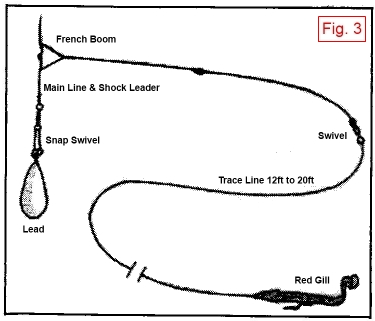
One end of the trace line is tied with a good blood knot to the Red Gill hook after passing the line through the centre hole in the lure, and the other end is fixed direct to a swivel or boom. Although all types of boom work, I have found that French booms made from wire are by far the best because:
- the booms cause less turbulence running in front of the lure;
- they can be attached further up your main line, away from your lead which also causes turbulence;
- they rarely tangle when set up properly;
- most importantly, they do not show up to a fish like a large black plastic boom, especially when using the popular 4 inch version of lure which is smaller in size than most plastic booms. I have always worked on the principal that you want the fish to see and chase your lure, not the terminal tackle.
There is only drawback with French booms - if you are using reel lines of under 25lb, use a small length of shock leader where the boom attaches to the main line. The reason for this is that pollack and coalfish dive so hard and fast when first hooked that lighter strains of line can break where the line is twisted around the boom. I have seen many a good fish lost because the angler could not be bothered to tie on a shock leader.
If, whilst fishing, your trace becomes kinked up, or has somehow developed a small loop in the line in the breeze, do not waste time trying to straighten it out - just cut it off and tie a new trace on, being careful not to draw some of the knot back through the Red Gill.
"Sea Fishing" (1999) Alan Yates at page 29
Lures
Red Gills
Britain's favourite sea-fishing lure is the Red Gill. This is an imitation rubber sand eel which wriggles and flutters just like the real thing when retrieved. The first lures of this type were red, so the name Red Gill stuck and is now applied to all rubber sand eels, no matter what colour they really are. There are a large number of manufacturers, each with their own variations and plenty of different colours available. The Red Gill is deadly for lure fishing from a boat over wrecks, for pollack and similar species. It can also prove effective when trolled from a dinghy for bass over inshore reefs.
The major drawback when casting from the shore is that the Red Gill requires the addition of a lead and this tends to scare bass away, although the addition to the trace of a clear bubble float part-filled with water as a casting aid can be effective from either dinghy or shore.
"Hooked on Bass" (2003) Alan Vaughan & Mike Ladle at pages 81, 82 & 84
4. Tackling up for Bass
Spinning
… In the south-west approaches off the coast of Devon and Cornwall, sandeels are often the premier bass food. Again the choice of lures is quite wide, but in this case the fish are looking for a long, slim 'silver pencil', shimmering and darting along somewhere between the surface of the open sea and the ripple-marked sandy bed. It is no accident that the Red Gill was developed down in the clear Cornish waters. The original rubber eel, simply a piece of rubber tube cut to give it a tail and pushed on to a suitable hook, was superseded by translucent Porosands and silver two-piece Mevagisseys before the wagging, soft-bodied Red Gills and Eddystones made their appearance. These lures, with their built-in fishy-type swimming motion, are about as close to the natural eel as could be imagined.
The soft rubber eel can be fished without added weight. Simply rig it with heavy nylon so that a small swivel is tight to the nose; it can then be tied direct to the line or clipped on like any other lure.
Because they are so light, silicone-rubber eels must be fished very slowly to keep them at any appreciable depth. Weight, in the form of a barrel lead, can be added up-trace or inside the eel. The normal hook fitted to these lures is rather large and coarse, though often sharp. If you favour a finer wire hook, it is possible to replace the original. It may, however, be necessary to pad the hook shank to keep it neatly in the mid-line or to rig the lure with a double hook for stability. The buoyancy and rigging of the eel can be delicately adjusted to the needs of any given fishing situation.
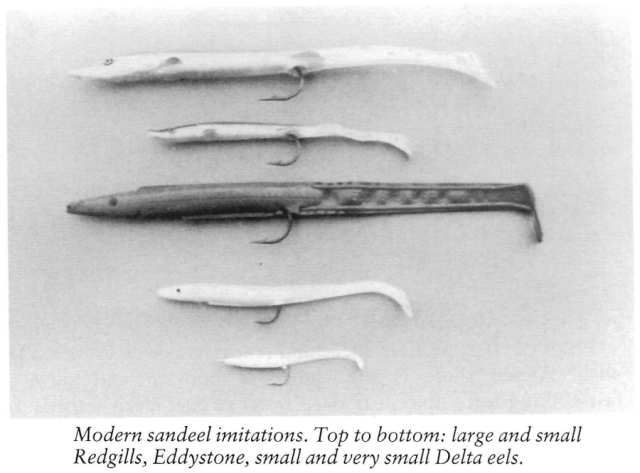
"Salt-Water Fishing: A Step-by-Step Handbook" (2006) Martin Ford & Bruce Vaughan at pages 36 & 37
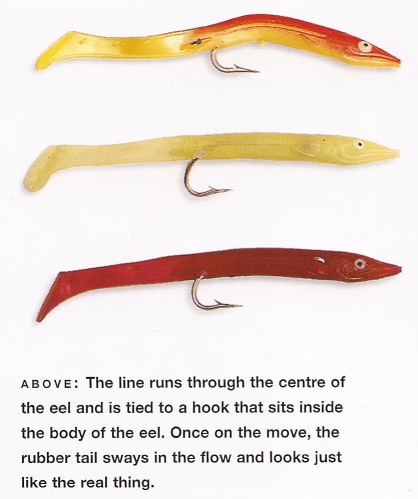
Artificial Baits
Artificial Eels
As the name suggests, these imitation sandeels are constructed to mimic the real thing. Artificial eels are killer lures for such species as pollack, bass and coalfish and are catchers of large species when fished over a wreck from a boat.
The two main attractions of artificial eels are the colour and the incredibly lifelike tail. On most models the tail is made of a flimsy thin rubber which incorporates a small but sensitive rudder at the tip. When retrieved through the water, the rudder is forced from side to side making the tail wobble in the tide. It is this movement that brings the artificial eel to life.
Artificial eels are effective from both shore and boat. However, it's the bigger patterns that tend to be used when boat fishing over a wreck and the smaller ones for rock, pier and jetty work. Eels as large as 15 in (38 cm) in length are standard wreck tackle for the boat angler. These are fished on a flying collar rig. This involves the use of a long 15 lb (6.8 kg) trace, 15 - 20 ft (4.6 - 6.1 m) in length. One end of the trace is tied to a boom which stands out of the main line. The other end of the trace is threaded through the nose of the eel and out through the underside at the beginning of the tail. A hook is then tied to the trace and the trace and hook are pulled back into position inside the eel's body. The lead, which may be as heavy as 8 oz (227 g), is tied on a weak link of line directly under the bottom of the boom. The weak link of line should be of a breaking strain lower than 6 lb (2.72 kg). This is so that the lead can break away from the rig, leaving the eel intact if the angler gets caught up on the wreck.
When sent down to the wreck in a running tide, the artificial eel sits out away from the boom in the tidal flow. The tidal flow works the eel's tail, making it look natural. From the shore the smaller types are good lures to use for bass and pollack when fishing at night.
These work really well if the sea is calm. This is because species like bass are able to pick up on the vibration caused by the tail as the eel is wound in. Colours for both boat and shore are a matter of personal choice. However, over the years a few colours have gained great popularity. Boat anglers in particular favour black, orange or red. There are many different makes of artificial eel available, but two designs in particular have probably accounted for more captures of specimen fish than any other makes. These are Red Gill and the Eddystone eels. Both are constructed from rubber and have a flexible tail which moves when worked in the tide's flow. They are available in different colours and in sizes from 3 - 18 in (7½ - 45 cm).
When to use
From the shore a small black artificial fished at dusk around rocky ground will attract bass. From a boat the bigger patterns are regarded as standard wreck fare.
Top Tip
When buying artificial eels some of the patterns have too heavy a gauge hook fitted. Remove this and replace it with a fine wire pattern. This will ensure that the eel acts as naturally as possible.
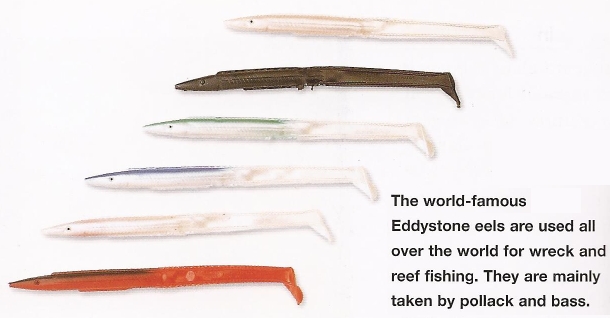
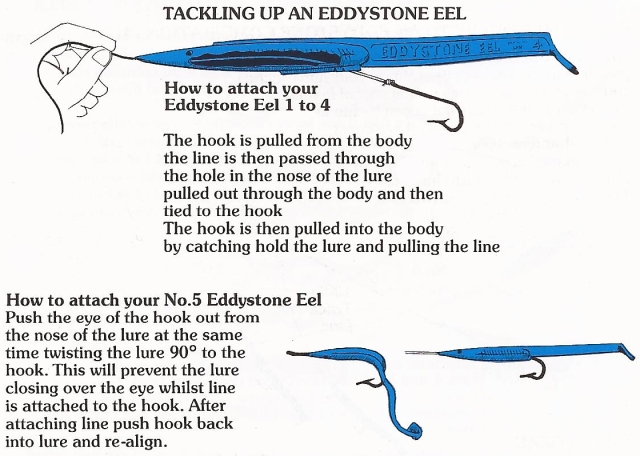
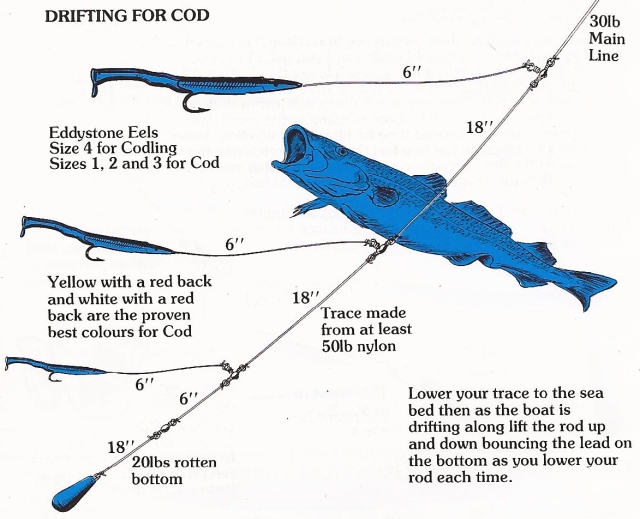
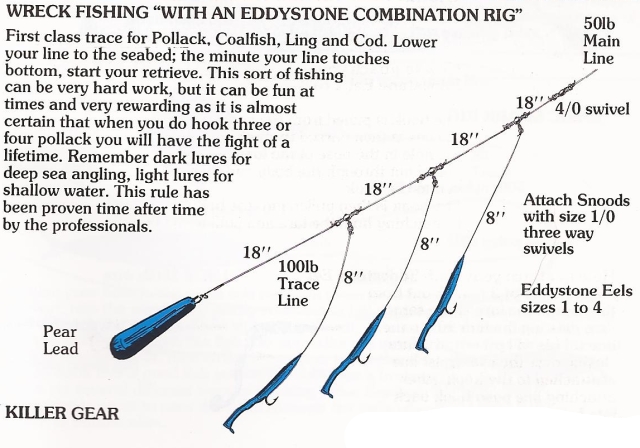
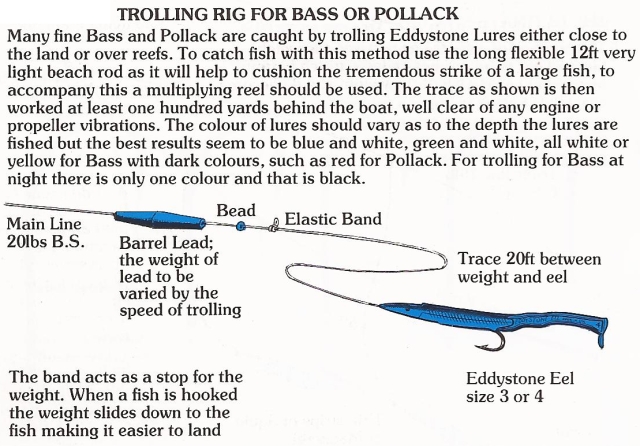
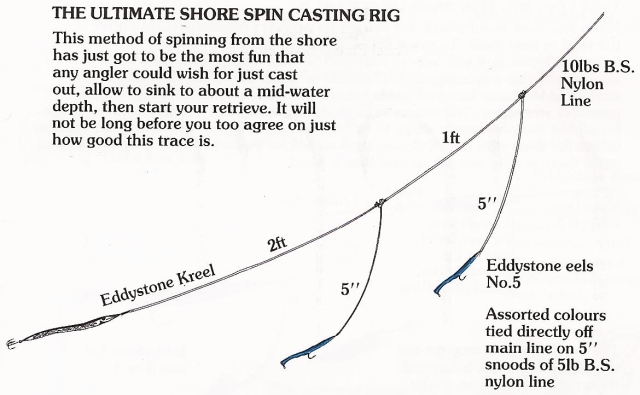
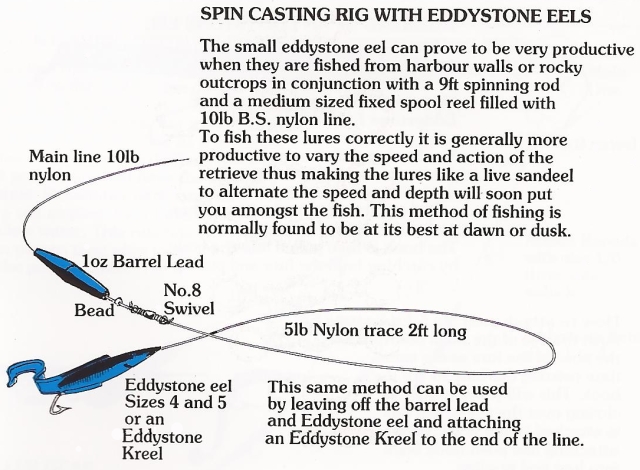
"Hooked on Sea Angling" (2011) Martin & Dave Beer
"Operation Sea Angler: The Second Wave" (2013) Mike Ladle & Steve Pitts at pages 166 & 169
The Science of Lures and Baits
Artifical baits: lure colour
… So are there any solid facts concerning the effectiveness of different coloured lures which might throw some light on the subject ? It seems that there are a few.
… what can we, as lure anglers, conclude from these tests ?
- Firstly, lure colour may not make much difference to effectiveness, but a spot of luminescence on the trace could help induce bites.
- In murky waters a lure with plenty of vibration may improve bites.
- Lures can be effective even when tied to pretty hefty nylon lines, but in very clear water it could be worth refining the tackle a bit.
- Scenting lures may, in some cases, put fish off.
- Bass run uptide in quite narrow lanes, so try to fish across the flow until you locate them and then fish at the same distance where you had your bite.
- Bass will take lures fished slowly against the flow pretty well.
④ Berkley® Gulp!® Sandeel

Length: 4 & 5 inchWeight: n/aAction: free swimming sandeel
Sold in packets of 6, the Berkley® Gulp!® Alive™ sandeel looks and feels like a sandeel but it has a special texture which does not disintegrate and a scent formula which disperses throughout the water attracting predators. Excellent for spinning from boat and rocks rigged in front of a 3-way swivel using a 36 inch trace and using light leads up to 2 oz. It can also be used on a fly rod as you would a normal fly. These have also caught sea trout, mackerel, pollack, scad, mackerel and coalfish. The colours "Silver Mud" and "Sardine" work especially well for bass in all light conditions.
The new Berkley® Gulp!® Alive™ 6 inch sandeel is the next generation in Gulp!® technology. These artificial sandeel lures come floating in what Berkley® describes as a "Magic Gravy" of scent and attractant in small, large, and elongated oval buckets in which the Gulp!® baits can be recharged. These new Gulp!® Alive™ baits absorb 20% more Gulp!® scent and attractant which, it is maintained, makes them at least 20% more effective than the 1st generation lures. They also have a 34% better swimming action than original Gulp!® lures. The tub contains 18 rechargeable sandeels in either "Silver Mud" or "Sapphire Shine" and retail at £14.99.
⑤ Calcutta Flashfoil Swim Shad
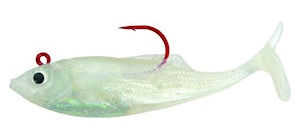
Length: 4 & 5 inchWeight: 1 ozAction: free swimming fish imitator
Calcutta flash foil latex shads incorporate a swim balanced weight system, vibra-action tail, holographic "live eyes", flash foil reflective bodies and raised gill plates that give off bubbles on retrieve, and have proven themselves to be effective lures for all predatory fish. They are available in 5 sizes (3, 4, 5, 6 and 9 inch) and 28 colours. These shads are heavy enough to cast extremely well in to a strong headwind and sink quickly to a good depth. The swimming action is a natural forward wobble with an enticing wriggling tail. They work well in medium to deep water from both the shore and the boat over all types of seabed. They are especially effective around man made structures and rocky headlands, also over reef ground where bass are actively hunting small baitfish caught up in fast tidal currents. They need no additional weight to fish correctly and are simply attached by clipping to a strong link swivel. The best colours for bass in this range are the "Pearl Ice" (see image), "Blue Back" and "Blue Gill".
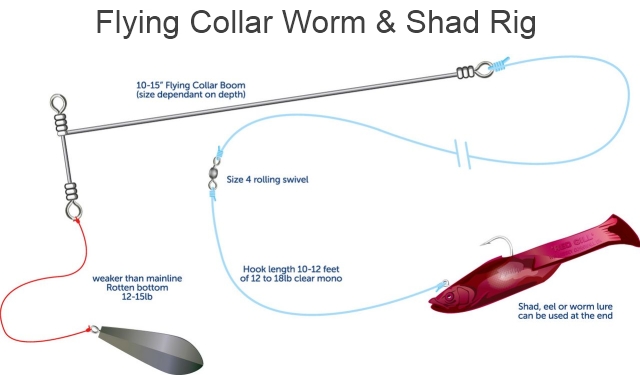
⑥ NOJO's "The Original Serpent Worm"
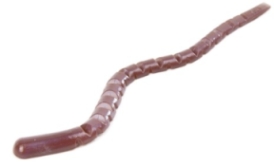
Length: 4½, 6, 7 and 9½ inchesWeight: n/aAction: free swimming worm imitator
Described as "quite possibly the most flexible and original soft plastic lure" and fished with a Rage Power Point jig head (available in hook sizes 6/0 and 8/0 and weights: 15g, 20g, 25g, 30g, 40g and 50g) "The Original Serpent Worm" works exactly like a sandeel along the sea-bed and has a well-earned reputation as a deadly lure for bass. The key to the Nojo "Serpent Worm" action is its tapered shape and segmented body, which gives it a snake-like S motion. Its length can also be customised by removing one or more of its body segments. Manufactured in 35 colours, 12 of which are sold by Jack's LRF for £6.50: 6 inch (9 pieces), 7 inch (7 pieces) and 9½ inch (5 pieces) per pack.
"Cod Fishing: The Complete Guide" (1997) Dave Lewis at pages 49 & 69 to 72
3. Artificial Lures for Cod Fishing
Soft American Rubber Lures
A few years ago soft rubber lures imported from America started to appear in British anglers' tackle boxes. On that side of the Atlantic soft rubber lures, which come in an incredible selection of different sizes, shapes and colours, are used by anglers to catch both fresh and saltwater fish. The big advantage of this style of lure when compared to other lures is that they are very cheap and extremely lifelike. I have caught a wide variety of species in European waters using this style of lure, including plenty of cod.
It is very easy for the angler to become totally bewildered when faced with such a large variety of lures. My own favourite style for general sea fishing are the rubber worms with a twist at the end of their tail. I use worms about 6 inches in length and those made by Mr Twister are among the best. I have tried many different colours and I have had the best results when using either plain orange or jet black with a crimson tail.
There are two ways that these lures can be used to good effect when targeting cod. Firstly, they can be used as a substitute for muppets and fished paternoster style in twos or threes … Secondly, they can be fished singly, in a similar style to artificial sand-eels …
Boat Fishing for Cod
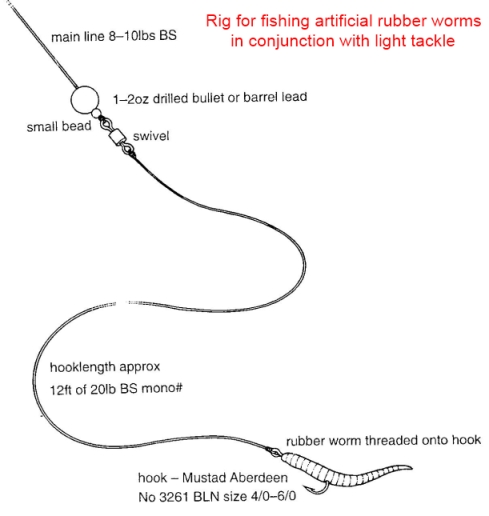
American Soft Rubber Worms
At first I was somewhat sceptical about the effectiveness of this type of lure for our species, but I am now convinced that soft rubber worms are one of the biggest breakthroughs in European sea angling for many decades. I have used rubber worms extensively and in many different situations over the past few years, and the list of species which I have caught on them is impressive, and still growing. When used over a reef, American soft rubber worm baits are one of the very best lures available for cod.
There are several ways that these lures can be fished, one of which is in exactly the same way and using exactly the same technique as that described for artificial sand-eels … [2]
My own favourite technique is described below; it allows the angler to fish for cod over the roughest ground using very light tackle. In order to get the most out of this technique it is important to use a light rod and reel. A spinning rod rated for use with lures up to about 1oz and matched with either a small multiplier or a fixed-spool reel, loaded with 8lb BS line, is ideal. Either a 1oz or 2oz barrel lead or drilled bullet is threaded directly onto the main reel line followed by a bead and a small high-quality swivel. The hook-length is attached to the other end of the swivel; I use about 6ft of 20lb BS clear nylon. An Aberdeen hook (between size 4/0 and 6/0 is ideal for cod) is tied to the other end of the hook-length.
The worm is lightly threaded onto the hook, starting at the head, threading about 1 inch of the worm onto the hook. When fishing over very rough ground, particularly when there is a lot of weed about, the point of the hook can be buried into the worm, which prevents it from getting snagged but in no way reduces its hooking potential.
To fish this rig, slowly lower the lure down to the sea bed, then steadily retrieve it, just as you would an artificial sand-eel. Fish can very often be felt plucking at the worm and it will be a great temptation to speed up or slow down the retrieve, or attempt to strike. You must resist, and maintain exactly the same rate of retrieve. In most cases the fish will eventually decide enough is enough and take the worm. I have seen cod to 20lb plus caught from a reef off Ireland by an angler using exactly this technique.
There are several advantages to using soft rubber worms instead of artificial sand-eels, the first being cost - rubber worms are available at a fraction of the price of rubber sand-eels. The second big advantage is that worms work well when there is little or no tide and fished at a very slow rate of retrieve, whereas artificial sand-eels really need a good run of tide in order to get the most efficient action out of the lure's tail.

Method of mounting American rubber worm lure onto hook.
The last big advantage is that the rubber worms are incredibly soft to touch, and shy fish are definitely less inclined to reject them. Some of the newest worms coming into the country from America are even impregnated with fish oil and other attractors, which can only help to increase the overall effectiveness of these wonderful little lures.
It is hard to determine just how much difference the colour of the worm makes to results. From my own experiments I would suggest that red, black and orange tend to be the most productive, but this has probably got a lot to do with the fact that these are the colours which I tend to use the most. There is still a lot of research waiting to be carried out on the effectiveness of different-coloured lures, and until such time it will always pay to experiment.
[2] Editor's Note: see Wreck Fishing page
"Salt-Water Fishing: A Step-by-Step Handbook" (2006) Martin Ford & Bruce Vaughan at page 38
Artificial Baits
Jellies and Twisters
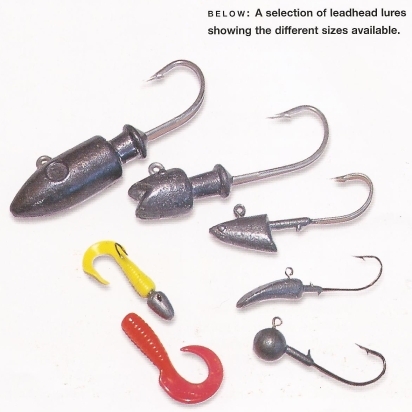
Jellies and Twister lures have become a big part of sea angling over the past few years. Imported from the United States, this new breed of soft rubber lure is at home on the boat or from the shore. There are hundreds of different designs and patterns to choose from. Jelly lures have a worm-shaped body and are usually impregnated with a colourful glitter pattern and fish-catching smell. The worm is very soft and flexible and will often have a built-in tail action to tantalize and tease fish into striking at it. As a rule, the worms tend to be unweighted and it is merely a case of inserting a sharp seahook, such as a 1/0 or 2/0.
When hooking they should be treated in a similar manner as a live worm, with the head threaded down through the centre of the worm's head and exiting at the side, a short distance from the entry point. From the shore they can be fished for bass, pollack and mackerel. Lighter colours tend to work better from the shore during the day as they resemble sandeels, a favourite food of these species. After dark, the colour is not that important as the predator relies on vibration and shape to find its target. The smaller variety can be fished on a three-hook trace from the boat and it is extremely effective for species such as pollack and coalfish.
Leadhead or twister lures are a weighted lure. As the name suggests, the twister lure works on the principle of a twisting tail in order to attract the predator fish. These are made from soft rubber and have a double tail fin that twists on the retrieve. Shore anglers and boat anglers catch many different species using this type of lure. Because they are weighted they are a good choice for the shore angler: there will be no need to add any additional lead to the line for casting.
With a separate leadhead section the angler is free to choose any colour tail he or she wishes to use and can vary it at will during the day. A real bonus with this system is that the tail can be changed easily and the angler does not have to break down the complete rig to do so.
Many of the original leadhead twister lures are designed to fish with the hook positioned upside down. This is a good point to watch out for when buying them as this pattern will rarely snag on the bottom over rocky ground.
The original Mr Twister lures with the leadhead are a must for the shore angler in search of pollack and bass. Fish them over rocks and rough ground on the high tide or just as the tide starts to drop. Leadhead lures also account for some huge catches of ling over the wrecks in the Irish Sea.
Top Tip: If you keep getting hit on a jellyworm but can't hook the fish, cut 1 in (2.5 cm) from the head and re-hook the worm. It could be that the worm is too long for the species chasing it.
⑦ Delalande Super Sandra
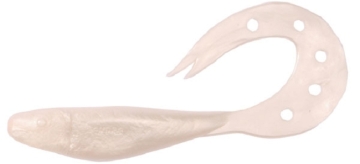
Length: 5, 6 and 9 inches (12, 16 and 23 cm)Weight: ½, ¾ and 2¼ oz (12, 23 and 80g)Action: free swimming fish imitator
The Sandra has been around for years but only now are anglers catching on to what an effective lure it is. This may be down to a recent change in the material used to make them which has meant that the tail has an even more attractive action than before. If you rig them 'weedless' they can be cast on their own and then retrieved with a slow steady retrieve. In deeper water you can add a jig head to get the lure down quicker.
Bass can often be found in amongst seaweed which can result in tackle losses. To avoid these losses and enable fishing in the snaggy areas, the Slug-Go lure was developed with a hidden hook. These are simple spindles of soft plastic with a channel or groove along the 'back' in which the hook point and barb lie. In this way the point is shielded from any snags or weed and can be fished through the densest cover. Special 'weedless' hooks with an offset shank and a square bend (such as the "Texposer") have been developed to keep the lure aligned and to assist hooking the fish.
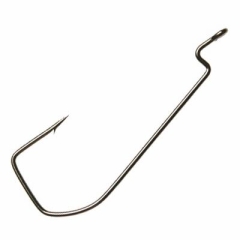
However, the downside of Slug-Go lures is that they are almost devoid of natural action and must be worked by twitching the rod or reeling in a jerky fashion. Mike Ladle modified the Slug-Go lure in order to make them both weedless and active by simply cutting off the back half of the Slug-Go lure and attaching the wiggly tail of a Delalande Super Sandra lure. Mike Ladle has been making good bass catches on his homemade Sandra/Slug-Go hybrid lure (called a 'Slandra') rigged on a Texposer hook. The 'Slandra' combines the casting weight and near weedless set up of the Slug-Go with the deadly tail action of the Sandra. This allows him to cast the lure into weed and retrieve it steadily and very slowly through areas too snaggy for other types of hard lure.
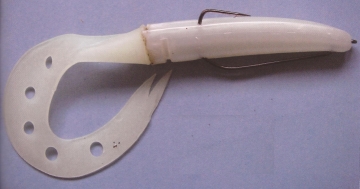
Rigging the lures is very simple. Insert a 'weedless' hook at the front end bringing the point out on the convex side about 1cm back. Push the hook through until the snout of the lure is pressed against the eye of the hook. Twist the hook through 180 degrees and push the point back through the plastic on the convex side and out at the opposite side. Keep the hook in the mid-line of the plastic so that the front end of the lure is not stretched or crumpled. Press the hook point down so that it lies in the groove of the plastic.
To fish these lures use a standard spinning or plugging rod with a fixed-spool reel loaded with 20-30lb braid, a yard of 15lb monofilament and a half blood knot to connect the line to the lure. Cast out into the snaggy area and wind in using a very slow and steady retrieve with the rod tip held low down. Good-size bass will almost always hook themselves without a strike.
"Operation Sea Angler: The Second Wave" (2013) Mike Ladle & Steve Pitts at page 35
Bass
The weed problem
… for some time I'd been using 'Texas-rigged' soft plastics to avoid weed. I butchered a Slug-Go (front half) and a Super Sandra (back half) and glued them together, producing a weedless, wiggly-tailed lure … The instructions were "hold up the rod and wind as slowly as you can". It worked a treat … For the rest of the year I only used my 'Slandra' and caught loads of fish. The advantages are legion:
- They can be fished under any conditions - weed, kelp, drifting debris, shallow water, rocks, day or night.
- They cast reasonably well - 20 to 30 yards on braided line (I've caught fish as close as 6 in from the edge in the dark).
- Anyone can use them, even youngsters are pretty safe with a single hidden hook point. Just keep the rod up and wind as slowly as you can.
- The fish take the plastics confidently (some even take violently) so should hook themselves.
The only real disadvantage is that you have to make the lures yourself. There are possible variations of the idea and some … have been attaching waggy tails instead of Sandra tails to Slug-Gos, producing what they call Slug-Gills - these can be equally effective. Instead of using glue to fix the two parts together … (use) a model-maker's soldering iron. Heat the cut ends, press them together until they cool and … you have a good, weedless bass lure.
⑧ Art Baits Flatfish
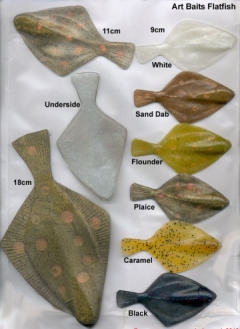
Length: 3½, 4¼ and 7 inches (9, 11 and 18 cm)Weight: N\AAction: free swimming flatfish imitator
Colours: white, sand dab, flounder, plaice, caramel and black
These soft plastic lures are fantastic imitations of various flatfish species and, when worked on a small jig head or dropshot rig, the action is very realistic (see video).
You can twitch them along the bottom or make them flutter higher in the water. In sandy areas flatfish are an important food source for predatory species and these Art Baits Flatfish lures open up a whole new area for the keen bass and cod angler - European anglers have even caught tope on the 18cm model off the Belgian coast. Because of the difficulty in casting these lures any distance, they are likely best suited to boat fishing.
The Lure Anglers Society put these lures through their paces over a period of six weeks in 2011 and reported having captured "all manner of species". Flatfish are preyed upon when small by just about every predatory species including their own kind. Small flounder and plaice have been used as bait for tope, smooth-hound and spurdog for many years and, with the introduction of the Art Baits Flatfish range of lures, realistic looking (and moving) artificial flatfish lures are now available to anglers.
These Belgian plastic lures are made from the latest bio-degradable, non-toxic plastic and hand-poured in three layers. They are so soft that you can leave them in your pocket screwed up and pull them out and they will fish instantly.
⑨ Mepps Aglia Plain Single-Hook French Spinner

Selection of Mepps Single-Hook French Spinners (sizes 3, 4 & 5)
| Size | Grams | Ounces | 00 | 1.5 | 0.05 | 0 | 2.5 | 0.09 | 1 | 3.5 | 1/18 | 2 | 4.5 | ⅛ | 3 | 6.5 | ¼ | 4 | 9 | ⅓ | 5 | 14 | ½ |
|---|

Mepps is both an acronym and a brand name - Manufacturier d'Engins de Precision pour Peches Sportives (Precision Equipment for Sport Fishing). The Mepps spinner was invented by French engineer Andre Meulnart in 1938 and it is his design which is the classic Mepps Aglia spinner, the original in-line spinner, considered to be the World's #1 lure as more trophy fish have been caught on the Mepps Aglia than on any other lure.
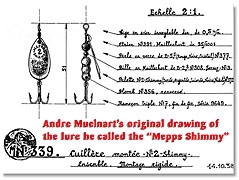
The Aglia's "backbone" is its heavy duty stainless steel shaft, attached to which is a concave oval blade, spinner body and a hook. The blade can be silver or gold plated, polished brass, copper or painted with epoxy. When drawn through the water the blade rotates around the shaft creating both flash and vibration. Either will attract fish, but together they become a deadly combination predatory fish cannot resist. The Aglia is also flashy, decorated with plastic and/or solid brass beads in a wide variety of bright fish-attracting colours.
Mepps Aglia lures are engineered to start spinning the instant they enter the water. They vibrate and flash to attract all species of predatory fish, whether fresh or salt water. The blades are constructed of silver plate, polished with a plain finish. All brass components are used for durability and precise balance cast after cast, fish after fish. A classic lure that works, its 60° angle of rotation giving fast spinning action. Large sizes run deeper.
Lure size is important. The rule of thumb is - use smaller lures to catch smaller fish and larger lures to catch larger fish. Keep in mind plain spinners present a smaller profile than dressed spinners, so they will appear smaller to the fish. Mepps plain single hook Aglias in size #00 or #0 are perfect for small flatfish and thin-lipped mullet. However, being very light they require a nimble rod equipped with a light-action reel spooled with light line - nothing heavier than 6lb BS, and 2lb to 4lb BS is better. Aglias in size #1, #2 and #3 are perfect for larger predatory fish (plaice, turbot, bass and thick-lipped mullet). These sizes are also ideal for teaching youngsters the basics of spinner fishing, as they are heavy enough to cast well with light tackle, yet they are small enough to catch a wide variety of fish. Mepps Aglias in sizes #4 and #5 are preferred by cod and specimen bass fishermen. Mepps single hook Aglias can be used virtually anywhere single hook lures are required.
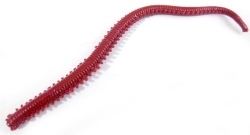
Thin-lipped mullet can be caught using small Mepps Aglia spinners fitted with a single size 8 hook and baited with a single ragworm or 4 inch Gulp!® saltwater sandworm in the "bloody" colour. Berkley Gulp!® saltwater sandworms ("bloody") is no longer an alternative and has become the preferred bait for many top anglers. The Gulp!® lure bleeds a scent like a blood trail so it attracts more fish from greater ranges and triggers them to feed.
Medium-sized spinners make the best thin-lipped mullet lures but avoid cheap versions which do not rotate on very slow retri scores well in clear water conditions and on sunny days, while orange and black are effective on overcast days or in coloured water.
"Popular Sea Fishing" (1968) Peter Wheat (editor) at page 167
The Mullet Family (Peter Wheat)
… Mullet spinning is not popular and it is only of local importance. Nevertheless it is effective and worth trying anywhere. The standard Mepps spoon is as good as any, although the traditional pattern is a silver, willow leaf bar spoon, about 1 inch long with a row of red beads along the bar. The method works even better if a small harbour rag is draped around the treble - in fact the ragworm addition is very often the difference between catching mullet and doing little more than making them chase the lure. Why they should take a spinner is hard to say They are non-predatory by nature, so it would seem that it is their curiosity more than any desire for food which motivates them to move after and snap at lures.
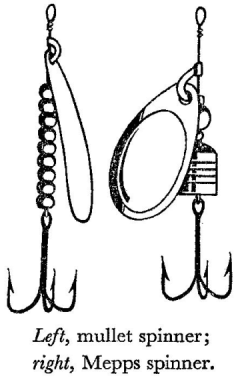
"Operation Sea Angler: The Second Wave" (2013) Mike Ladle & Steve Pitts at pages 101 & 103
Flatfish
The baited spoon
One summer a few years ago we concentrated entirely on the use of baited spoons, spun from the estuary shore, for thin-lipped mullet. Although they had been developed in France many years earlier, these lures were, at that time, only used by anglers in the waters of Chichester Harbour. After trying them in many other spots along the south coast we found that they were almost unbelievably effective. Interestingly, while we were mullet fishing, we picked up quite a few flounders, too.
… There is no reason why spinning should not work for flounders of all sizes, and unhooking big fish (always nicked in the mouth) will be even easier than dealing with the small ones. This is most important in a conservation-conscious age. Spinning is an active method that allows you to search large areas of water and attract fish from a distance. No doubt it could be a useful match tactic if anyone can withstand the inevitable ridicule as they try it out.
⑩ Marukyu Power Isome Worms
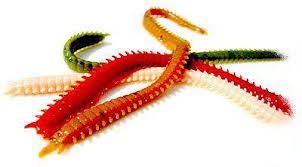
Length: 3, 4 and 4½ inches (8, 10 and 11 cm)Weight: N\AAction: lifelike ragworm imitator
Colours: brown, green, pink, red and white
The Marukyu Power Isome (pronounced "e-sow-may") is a lifelike artificial ragworm, enhanced with attractants and amino acids that attract fish - they smell, feel and taste like ragworm. The Isome can be used on its own as an artificial bait or lure, or in conjunction with other baits. Its combination of unusual scent, amino acids, texture and lifelike appearance produce a lure which fish - from bass to micro gobies - find irresistible.
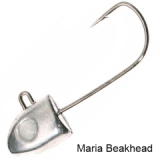
Designed for the angler's convenience, the Isome lure is ready to fish straight out of the packet and, unlike ragworm, is easy to hook, less messy, and does not bite. The secret is in Isome's advanced formulation - the artificial worm is packed full of amino acids (six times more than a real worm) - which are leached into the water over a long period of time. The result - the angler is fishing effectively and for longer.
LRF (light rock fishing) gear is the best way to present them and, by mounting one on a mini jig such as the Maria Beakhead, realistic movement can be imparted into the lure. Provided there is some tide to waft the Isome lure about, it will catch fish on ledger gear, floats and baited spoons.
The Yamashita Beakhead is a mini jig head which is mounted on a light but strong hook and fitted with a bait retaining spiral making it ideal for using with small soft artificial baits such as the Marukyu Power Isome.
The Marukyu Power Isome is 100% biodegradable and will not harm fish or the environment. It is supplied in sealed bags which contain a special liquid to keep the bait in perfect condition. Provided it is kept in the original packaging and liquid then it will last almost indefinitely and even used worms can be safely returned to the packaging to be used again.
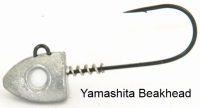
In summary, the Isome's advantages are:
- can be used on its own, or in conjunction with bait
- more scent attraction than live bait
- does not fall off when casting
- available all year round
- keeps indefinitely in a resealable packet
- can be cut into small sections for use on tiny hooks
- ideal as a trailer on baited spinners and spoons
Sarcelle Bait
"Angling in Salt Water: A Practical Work on Sea Fishing with Rod and Line from the Shore, Piers, Jetties, Rocks and from Boats" (1887) John Bickerdyke at page 30
Chapter II: Tackle
Spinning, Trailing, Whiffing and Railing Tackle - Artificial Baits
Artificial Spinning Baits
… and last, but far from least, two red india-rubber bands (Fig. 30), cut, and caught by the ends on two hooks placed a few inches apart. These, when drawn through the water, present a most lifelike appearance. The tackle for them is made in a couple of minutes with two eyed hooks and a length of gut.

"The Badminton Library: Modern Sea Fishing" (1895) John Bickerdyke at pages 124 & 125
Chapter IV: Baits
Artificial Baits
… I will now devote a few pages to a short description of the best whiffing baits. Ranking almost, if not quite, first comes the "Sarcelle". It was designed by Mr. C. A. Payton, "Sarcelle" of the "Field", and is a very successful combination of the baby spinner and the band bait. Its chief use is for shoal bass which are feeding close to the surface. The illustration, by the way, is not a true and original Sarcelle, but an improved edition, made by a friend whose kind suggestions I have already gratefully acknowledged.
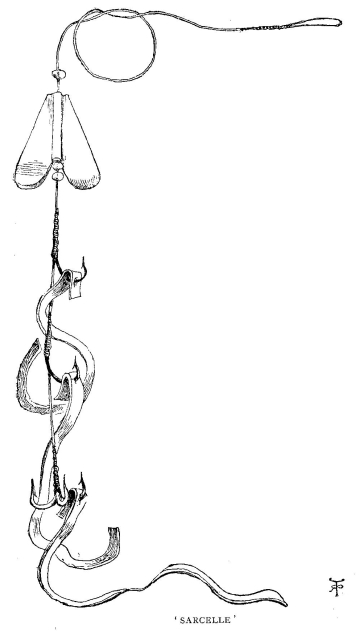 |
 |
Anybody can make a band bait for themselves in five minutes with two hooks (if eyed so much the better), a piece of gut, and a couple of india-rubber bands; the illustration shows so clearly how the thing is done that it requires no written description.

The baby spinner, of which Messrs. C. & R. Brooks, of Plymouth, claim to be the inventors, is a very valuable little addition to the natural bait, placed above a single hook; it spins on the gut and rests on a single glass bead. It does not wear the round gut as might be supposed, but for fish of any size it is certainly desirable to use gimp in connection with this particular form of bait. Another capital bait is a piece of sole or other fish skin cut fish shape and hung below one of these spinners, with or without another piece of sole-skin hung below the hook as illustrated.
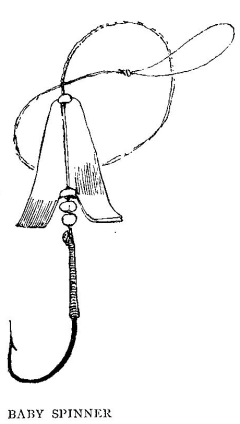 |
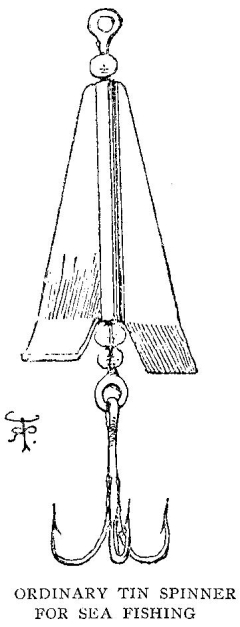 |
"Letters to Young Sea Fishers" (1898) John Bickerdyke at pages 114 & 115
X. Artificial Baits
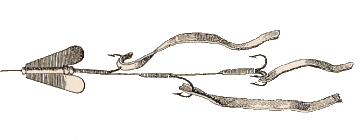
… I shall describe some of the best artificial baits for pollack and bass … Among the very best of them is an elaboration of the bait designed by Mr C. A. Payton, better known, perhaps, as "Sarcelle" of the Field. It will be seen from the illustration that it consists of nothing more than two hooks and a triangle, each of the three bearing a longish strip cut from a not too stout red india-rubber band, while above the topmost hook works what is usually called a baby spinner, kept in position by a couple of glass beads. With the exception of the spinner almost anyone can make these for himself. The action of the rubber bands in the water is most lifelike.
A simple but excellent tackle, on the lines of the "Sarcelle", can be made in a few minutes out of a length of gut, single or twisted, and two eyed hooks from which hang curling, twisting, worm-like pieces of india-rubber band. The size of the hooks and the length of the bait must depend, of course, on the waters being fished. If you are out in deep water, where pollack run up to 20lb, then you must have large, strong hooks, and big, broad india-rubber bands. And I am not sure that the triangle at the end of the "Sarcelle" bait is not better dispensed with. More inshore, and in places where the largest pollack we are likely to catch will be 3lb or 4lb, then the bait must be proportionately small. One hook should be at the end of the tackle, the other from 1½in to 2½in above.
"Sea-Fish" (1898) Frederick George Aflalo at pages 224 & 225
Appendix
There was once upon a time very good bass-fishing round the Gwingeas, anchoring about 100 yards east of them on a flowing tide, or whiffing on all sides; and I recollect when I was fishing at Mevagissey for a couple of months in 1894, "Sarcelle", keenest of sea-fishers, who is, I understand, soon to cast his hooks once more in the Channel, sending me glowing accounts of the bass he once caught there. His "Mogador dodge", which he exhorted me to try, is so good that I give a cut of it. It consists merely of two hooks four inches apart, the gut surmounted by a "baby", and from the bend of each hook trails a strip of fresh herring or other fish. He particularly recommended strips from the belly of a bass, but, alas!, there were few bass when I was there last. Dynamite and other poaching methods had already done their work. I hooked but one - and lost it! - off Chapel Point.

"Practical Sea-Fishing" (1905) P. L. Haslope at pages 69 & 70

"Sarcelle" Bait.
This simply consists of two india-rubber rings which, after being cut, are attached to a Limerick hook … one being whipped on to the top of the shank and the other hooked on to the point. When drawn along they imitate closely two wriggling worms, and prove very enticing to small pollack. This bait does not, however, in practice take as many fish as one might expect. It is often rigged upon two hooks, one above the other; also upon triangles with a small spinner at the head of the bait.
"Pelham Manual for Sea Anglers" (1969) Derek Fletcher at pages 60 & 127
Inner Tube Lure
A strip of red cycle inner tube hung from the hook and kept on the move through the surf will sometimes lure bass and pollack while boat fishing around rocks. Occasionally anglers dip it in pilchard oil which leaves an attractive fishy scent as it is moved through the water.
Valve Rubber Lure
A six-inch strip of cycle valve rubber hanging from the hook can be used successfully as a lure in some areas. Pass the hook though one end of the strip, letting the whole length hang from it. It is simply worked through the water, and is particularly successful during autumn for pollack, although several species are attracted by it.
Belgian Grub
"The book of the all-round angler: a comprehensive treatise on angling in both fresh and salt water" (1888) John Bickerdyke at pages 79 & 80 (Division IV)
Chapter VI: The Pollack
A very curious bait is used for pollack in Torbay. It is called the Belgian grub, and consists of a plaster of Paris caterpillar, moulded on the shank of a hook, painted yellow or white, with a red head. Three or four of these are placed on a line, like a cast of flies, and trailed after the boat, a cut rubber band being placed on the hook of the end grub.
"The Badminton Library: Modern Sea Fishing" (1895) John Bickerdyke at pages 125 & 126
Baits
A very favourite bait for small pollack which are caught in spring on the Cornish and Devon coasts, is an arrangement curious both in form and name to wit, the Belgian Grub. One is shown in the illustration. It consists of a hook on which is moulded a dumpy body of plaster of Paris or other cement, painted various colours sometimes yellow, sometimes yellow and red, or yellow and white. Mr. Farlow showed me a quantity which he had specially prepared for a very successful fisherman, in which the plaster was coloured black and the rubber tail had been apparently stained with ink.

"Practical Letters to Young Sea Fishers" (1898) John Bickerdyke at pages 193 & 328
XVII. Fishing from a Boat in Motion
A bait called the Belgium grub, made of plaster of Paris, and painted various colours - black, red, brown, yellow, and with a tail of indiarubber band - is used instead of flies for these small pollack, and is found very killing on the south-west coast of England.
Chapter XXXIII: Modern Improvements in Tackle Suitable for Sea Fishing
Belgian Grub
There is a well-known bait in the west of England, called the Belgian Grub, used for catching small pollack. The shank of the hook is thickened with plaster of Paris, painted black, yellow, red, or other colour, to suit the fancy of the angler; and, in addition, there is a small tail of india-rubber band, 1½in or a little more in length. Messrs Warner and Sons make a glorified Belgian Grub, in which the body consists entirely of india-rubber, with a flat, broad, silver tinsel ribbing and a red head. Fish certainly ought to take it better than the old-fashioned plaster of Paris arrangement. I am very curious to know who was the original inventor of the Belgian Grub, for it is like nothing on earth or in the water, and I should say he must have been either an extraordinary genius or a madman.

"The Modern Sea Angler" (1958) Hugh Stoker at page 67
Chapter Six
Rock Fishing
Finally, we must mention a method of rock fishing which is widely practised from rocky scaurs bordering deep water. This is the art of 'bobbing' with a trace of feathered lures, or a single cuddy fly made from a white gull's feather bound with tinsel. Both lures are worked underwater at slack tide, with short, quick jerks.
A close, still evening in summer or early autumn, when there is a thunderstorm brewing in the distance, is the time above all others to try one's luck with this kind of fishing. Under such conditions it is not unknown for fish to go suddenly crazy, snatching at practically anything. Then a bobbing trace and a lively rod will provide an evening of never-to-be-forgotten sport.
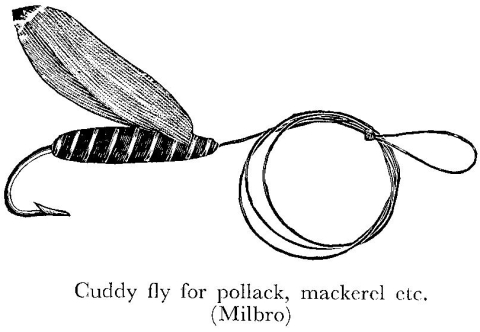
Baited Spoon
"Practical Sea-Fishing" (1905) P. L. Haslope at page 62, 71 & 72
Chapter VI: Artificial Baits and How to Make Them
The first attempt at making a spinner was a piece of bright tin, with a hole in it, attached above the hook, an arrangement which was known locally as a "shiner". This did not revolve when drawn through the water, and only of late years has the proper method of bending the metal been discovered.
Spoon Bait
There are two or three varieties of this bait, but the usual kind is illustrated in Fig. 52. It consists of a piece of bright metal with a ring at each end, convex on one side and concave on the other. It is fitted with a large triangle and swivel. Some spoon-baits are made of pearl instead of metal, whilst others are provided with a tassel. This is the most killing bait for the enormous mahseer, found in Indian rivers, and will often attract bass or other large sea-fish.

"The Sportsman's Library: Sea Fishing" (1935) Major D. P. Lea Birch ("Fleur-de-Lys") at pages 77, 80 & 150
Chapter IV: Tackle
A fair sized spoon, with a piece of lugworm on the hook, has been found effective for flatfish, when worked slowly from a boat.
Chapter V: Bait
Ragworm
Ragworm are a good bait to use from a moving boat: a piece put on the tail hook of a spinner or spoon adds greatly to the attractiveness of the lure.
Chapter X: Flat-Fish
… The flounder is a lively and active fish, so much so that many of them have been caught on a slowly moving spoon, with the hook garnished with a length of worm, thus making the lure more attractive.
"Salt-Water Angling" (1956) Michael Kennedy at pages 133 to 138
Spinning
Spoons are of many types, but fall into two main categories - wobbling spoons and spinning spoons.
Wobbling spoons - fluttering spoons would, perhaps, a better term - waver and flutter when drawn through the water; and are ideally adapted to sink-and-draw fishing, as they flutter and wobble when the line is slackened and they are let sink to the bottom, and sheer and flash when the line is jerked.
… Spinning spoons are true spinners, revolving about a bar, which may or may not be weighted …
The baited spoon has brought about something of a revolution in fishing for flatfish.
It is an ordinary spoon bait, the normal triangle of which is replaced by a long-shanked single hook, which is baited, usually, with lug or ragworm. Trolled or spun near the bottom, it takes flounders, plaice, gurnard and eels; and fished at higher levels it takes bass and pollack.
The success of the baited spoon as a flatfish lure is not so inexplicable as some anglers appear to think. Bright objects have a strange attraction for flatfish - I have more than once rested my hand on the bottom of a shallow, estuary pool, and in a short time as many as a dozen baby flounders had settled on it. Movement attracts all fish, even non-predacious species. The brightness plus movement of a spoon, consequently, interests flatfish (as well as other species), and they proceed to investigate. On swimming up to the spoon, if it is unbaited, they may or may not lose interest in it - it is by no means uncommon for flounders to seize, or attempt to seize, the spoon or other lure with which an angler is spinning for other fish, if it is spun close to the bottom; but more often they will swim away again, after gliding up to it. If, however, the spoon is baited, they will usually transfer their interest from the spoon to the bait, and take the latter. In short, the baited spoon combines the advertisement value of the spinning lure (which is much more likely to be noticed by fish at some distance than a bait lying on the bottom) with the appetite-stimulating appeal of the natural bait.

Either a wobbling or a spinning spoon can be used. If the spoon is a wobbler, it is best made of plastic, mother-of-pearl, or very light metal, which will flutter easily. Fig II, 18 shows how the spoon is fitted for use with bait - the tail triangle is removed, and a chain of two or more swivels, connected by split-rings, is attached to the split-ring at the head of the spoon. The chain of swivels should be long enough to reach to the end of the spoon; and to the end of this chain, by means of a split-ring, are attached a size 2 long-shanked, straight-eyed hook, and a size 8, short-shanked, straight-eyed hook. The spoon may be all white, or brown (or copper) on the convex side, and white on the concave side; the swivel chain, of course, should be attached on the concave side of the spoon. For trolling, a spoon as big as 3in may be used but, for casting, a smaller 2in spoon is more convenient. This size of spoon can be cast with a centre-pin reel outfit, if a spiral or other lead of suitable size is used as a sinker. Alternatively, a weighted kidney spoon may be rigged up for baited spoon fishing. Flatfish prefer a wobbling to a spinning spoon, and a big spoon rather than a small one.
The spoon, for flatfish, is best baited with rag or lugworm (for gurnard and bass, a slip of mackerel or gurnard may be substituted). The worm is threaded up along the long-shanked hook, and then caught through the head by the smaller hook, to hold it in position. The tail of the worm should be left to trail; if desired, a second worm may be impaled on the hook point.
In trolling, all that is necessary is to trail the spoon slowly over the sand, and strike when the line jerks. Spinning a baited spoon is less simple. Ideal conditions for fishing this lure are a level, sandy bottom, and water less than 6 feet deep. The spoon should be cast out, be let sink to the bottom, and then be retrieved fast enough to make it flutter (or spin, as the case may be), but no faster. Usually, a tug at the line is the first intimation that a fish has been attracted by the lure, and it is best to keep on winding - slowly - until the weight of the fish is felt, when a jerk of the rod will set the hook. Sometimes, however, a fish will be seen to follow the spoon several times, without taking the bait. When this happens, try slowing down the spoon, and letting it sink to the bottom when the fish is seen close behind. The fish may then pick up the bait. If it does not, try twitching the spoon off the bottom again, continuing the retrieve, and alternately letting the spoon back to the fish, and drawing it away from it again when its nose is almost touching it - if the fish does not really want to eat the bait, it can, perhaps, be irritated into seizing it.
A miniature baited spoon - a 1½in mother-of-pearl spoon, fitted with a size 4 long-shanked hook and baited with a small ragworm or a herring-bone, can be cast with a light rod and fixed-spool reel; and is, at times, quite effective for flounders, gurnard, small bass, and sea trout.
"Flatfish: How to Catch Them" (1957) "Seangler" (John Garrad) at pages 34, 35 & 38 to 45, 47, 48 & 56 to 62
Chapter II: Baits, Tackle, Boats
Tackle
Hooks
The most important point relating to flatfish in my experience is that, probably because of their crooked mouths, they need a crooked hook. Time and again, when taking out visiting anglers to try the baited spoon, they have had bites but never connected, until I found they were using Limerick, or as I call them "straight" hooks in which the point is in line with the shank. On changing to "sneck" or crooked hooks (hooks with the point turned away from the line of the shank), they have taken fish. In fact I now almost invariably put a kink in the shank in order to bring the point farther out of line. As for size, this largely depends on the bait being used. Flatfish have small mouths and with small ragworm a hook with a bend the size of the little nail is sufficient. Where you know that flatfish run large, and when using large rag, lugworm or fish, hooks one, or even two sizes larger are better. In spite of all that has been written, I have found little difference in the holding quality of either short or long-shanked hooks, so long as they are of the "bent" type. Size, too, is not very important. I have hooked and held large flatfish on the finger nail size; whilst I have had fish of 4 to 5 oz on hooks as large as the thumb nail, intended for bass.
Other Tackle
Most anglers carry too much … the outfit can be reduced to a spoon, float, a boom and a small tobacco tin to hold split rings, swivels, hooks, lead wire, with a small coil of nylon for hook links. A couple of weights for bottom fishing, plus fish bag, wiping rag and priest completes the outfit. I make the hook link, or the last section of the spoon trace, in heavy nylon, 30lb breaking strain if I have it. When a fish is played to the boat, this enables any flatfish to be lifted in. The float should be one with a slit down one side and a plug through the centre into which the line can be laid, and plugged firmly. It can be taken off again without the trouble of dismounting the end tackle.
Chapter III: Trolling the Baited Spoon
Trolling, spinning, railing, whiffing, etc., are only varied names given to one type of fishing, that of towing some kind of tackle behind a moving boat …
The method of trolling a large spoon with the hook baited behind a boat rowed very slowly, has proved to be one of the most deadly methods of taking flatfish …
The Tackle
The Spoon
Thirty odd years of experiment has shown that, for flatfish, a small spoon is of no use. I stress this as after showing numerous anglers my tackle, many have gone away and tried smaller spoons, apparently under the impression that there is no need to use such large spoons. All of them have later complained of their lack of success …
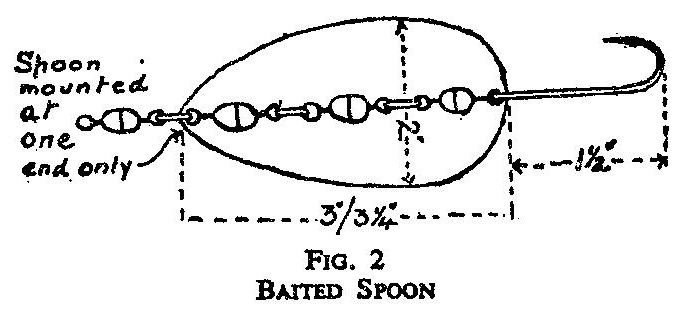
Bait
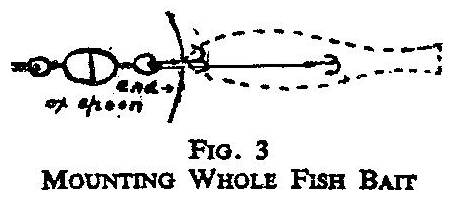
So long as the spoon is used in conjunction with the baited hook, the kind of bait seems largely immaterial. The flounders' regular food does not seem to prevent them taking a different bait. I have taken fish on all the worms; on fish baits (not only herring or mackerel, but even bloater or kipper), hermit crab tails, and even cockle and sea squirt. I have no doubt, however, that fish baits on the hook would be more likely to attract turbot, brill and other fish feeders … A small triangle is attached by a short wire, or nylon link, to the eye of the last swivel. Its length is adjusted so that when one hook of the triangle is passed through both lips of the bait, the nose of the bait is close to the end of the spoon. A second, slightly larger triangle, on a separate longer link, is first hooked into the side of the bait, about two thirds of the way towards the tail. The link is then brought up alongside the bait, and twisted into the swivel eye, over the top of the first link. This longer link should be adjusted so that the fish used for bait is in a straight line behind the swivel chain and not bent to cause a wobble.
Spare Spoons
Apart from a spare in case of loss, an angler using this method regularly can take one or two other spoons, the 4in loop enabling them to be easily changed. Although the plated spoons serve most purposes, one, painted white, will improve catches on dull days, in thick water, or at dusk. Another, painted red, will be useful on bright sunny afternoons when water is gin-clear, with often hardly a ripple. Of the two, the latter is the more important. Whilst the white may add an extra half-hour's fishing late in the evening, they naturally do not show up after dark, or when the water gets really thick. On the other hand, during long bright summer days I have been the only angler taking fish through having a red spoon with me. The plated and even the white, in brilliant weather, appear to flash too much and scare fish away rather than attract them.
The Method
… this tackle is used by towing it behind a boat, rowed very slowly. There are two rules to remember to obtain the best catches, and a number of minor points that add to its effectiveness.
1. Troll as slowly as possible. The speed of rowing should be no more than enough to keep the spoon from touching bottom. This means that the rowing is not hard work. All that is needed is a slow, firm pull (not a jerk) once every few seconds when the rod tip shows that the movement of the spoon is slowing down.
2. Troll with the tide or current. Flatfish feed and swim with the current, and a baited hook coming to them against the current is therefore unnatural, and they seldom take it. For one fish taken against the current, a score will be taken trolling with it. Where I have had bites, apparently against the current, I have later found that there is an eddy under water.
Minor points are that flounders, dabs and probably other flatfish, have developed the habit of keeping to regular tracks, especially in estuaries. They also swim together in small shoals …
Flounder Tracks
In estuaries flounders have regular tracks. These usually follow the main run of the current. If there are bends, the current will run into and round the outside of each bend. If the next bend is on the opposite side, the current (and the tracks) will edge diagonally across the channel from the end of one bend to the beginning of the next. It will pay an angler to make a rough map of his estuary and plot on it where each fish is caught. In time the markings will connect up and show the general line of these tracks. In my own water, 75 yards to one side or the other of the tracks, bites practically cease.
On open coasts, tracing tracks is more difficult, but two general rules act as a guide. Flatfish will be swimming with the current. They will also be working toward the shore as the tide rises and away as it ebbs. Troll with the tide, working from the shore outwards until you find how far off shore the fish are keeping. On the ebb, work farther off shore. An Admiralty Chart will be found useful, as it will show hollows or gullies scoured out by the ebb (which runs the faster). Fish make use of these gullies, coming up them, working from them towards the shore on the flood, and back to and along them as they go seaward on the ebb. It should also be remembered that it is recorded of dabs, that they swim in processions along the hollows or gullies in sandbanks. Where the chart shows these, it will be worth trolling through them, even though it means fishing across the tide. One cannot be dogmatic about fish tracks in the open sea, but these few hints will give the angler a chance of finding them.
Chapter IV: Drifting, Sinking and Drawing, and Casting the Baited Spoon
I am devoting some pages to the first two methods for a particular reason. Whilst plaice and flounders have been taken on the trolled spoon, I have not taken dabs in this way. All the dabs I have taken have been on a baited spoon simply allowed to drift on the current from a moored boat, a fact which seems to show that they have habits different from other flatfish … It also has an advantage in that it does not necessarily need to be worked from a boat. It could be worked from pier or quay and, in suitable places, from rocks or even groynes. It can be used in two ways; simply allowed to drift when there is sufficient current running to impart movement to the spoon; or by sinking and drawing, which can be used whether there is a current running or not.
Drifting
The trolling spoon and trace can be used without alteration in moderate currents. In stronger currents weight may be needed. It must be appreciated that, when drifting, the current will have more effect on the line than when it is being towed with the current behind a boat. To get the spoon deep enough in currents of any strength, a substantial jardine lead may be needed on the line above the top swivel of the trace.
The spoon is put overboard or lowered into the water and the current allowed to take control and start the spoon revolving. Line must be paid out slowly and kept tight enough to feel the spoon ticking over. If line is paid out too fast the spoon may sink, but the bait on the hook offers enough resistance to the water to raise it above the spoon and hook into the trace. When bottom is felt wind in a yard and leave the spoon to work itself. Generally, it is most effective near the bottom, although on one occasion I took a dab, whilst lowering, at a distance I should estimate at 12 ft off the bottom, in five fathom water.
When working in shallow water I have found the most effective way to get out line, once the current is working the spoon, is to slowly lower the point of the rod almost to the surface. Then slacken the grip on the line (or take off the check) and raise the rod slowly without jerking. The resistance of the working spoon will be sufficient to pull line off the reel. Pause when the rod is nearly vertical to make sure the spoon is still ticking over and then again lower slowly. By keeping a tight line in this way I have got out 20 to 25 ft of line in only 10 ft of water; which has the advantage of getting the bait well away from the shadow of a boat, or from any disturbance caused by the angler's movements. Sooner or later you will feel a faint bump as the spoon touches bottom. Lift the rod to its usual holding position and keep steady, winding in a little line if necessary. The spoon can then be left to drift, trying it occasionally to make sure it has not touched bottom, due perhaps to some slackening in the current.
You may have to experiment with spoons. Whilst most spoons will tick over steadily when trolled, some are too heavy to tick over nicely with only the current to move them. I have found that a 3 in spoon of rather flat section, in a light rustless steel, is turned by the current more easily than the "table" spoon. The modern way of mounting a spoon, wide end forward, may be found more effective, as the current seems to have more effect on it. I, however, have not found them effective when trolling, as you cannot seem to row slowly enough to keep them from turning too fast, and still keep the boat under control.
Sinking and Drawing

When there is little or no current these spoons can be effectively worked by sinking and drawing. The tackle may, however, need some alteration. It should be obvious that, when sinking and drawing with lead on the line, perhaps 6 ft above the spoon, you could be sinking and drawing the lead without moving the spoon which could be resting on the bottom. All lead must, therefore, be shifted down the trace as near the spoon as possible. I have found it works effectively with the jardine lead shifted to the lower end of the trace and touching the front swivel of the spoon. A better way, devised by the late Mr. Percy Wadham for casting, is to alter the swivel mounting. It usually takes three swivels to fill in the length under these large spoons between the head split ring and the hook. Remove the last-but-one swivel and its attendant split rings and fill in the gap with a piece of fine wire (Fig. 5). Lead wire can then be wound round this piece of wire which brings the weight right in under the spoon and does not interfere with the working of either swivels or the spoon. The revolving spoon hides the lead. Another item of interest found by Mr. Wadham was that, if this lead is painted over with red cellire [3], the tackle took more fish than with the bare dull lead.
Let the spoon sink until it touches bottom with the rod top nearly on the surface of the water, then wind in 6 in. of line. Hold the line, or put on the check; then slowly raise and lower the rod. When lifting the tick of the spoon can be felt and, as with trolling, this will guide you as to whether you are raising it too fast. These spoons are always more effective when working slowly. Lower just as slowly. The spoon waves about as it sinks and the bites often come as the spoon is sinking. Unlike trolling, it is as well to strike gently (but not hard) at the bite. It may help if you can visualize the sinking tackle. The hook and the swivel chain with lead on the wire will be sinking almost vertically, but the large spoon with its resistance to the water may be waving about at nearly right angles. A hard strike causing the spoon to start revolving from its position at right angles could shift the baited hook well to one side of the mouth of the fish. If your rod is on the short side, you may have to work the tackle by winding in and paying out.
[3] Editor's Note: cellire is a clear, gloss-finish cellulose varnish sold in various colours including black, red, yellow and white.
Experiment
A word as to experimenting with spoons. Do not be tempted to use, say, Kidney Bar Spoons or the Eared Colorado which have lead already cast onto the bars on which they are mounted. They will no doubt sink all right, but in months of trials these types have never taken flatfish. Also, do not be tempted to try smaller spoons. Flatfish take the 3 in. or even the 3¼ in. Smaller spoons tempt eels; whilst I have found that 4 in. or larger tempt ballan wrasse (of all fish). It should also be remembered that flounders and plaice have, so far, only been taken on the spoons when trolled. In estuaries where flounders are the principal fish, or on known plaice grounds, you will have to troll if you wish to be sure of catches.
There is a wide field for experiment in the drifting spoon. Although only dabs, but not flounders or plaice, have taken the 3 in. spoons used in this way, every time I try a spoon of a different size or shape, it seems to attract different fish. It is, therefore, possible that a different shape or size may attract plaice or flounders although so far I have not found it. Equally, a drifted 3 in. which will take dabs may take turbot or brill on grounds where they are found; but they may need a different size, or even need to be trolled for.
Casting
The baited spoon can be cast direct from the rod and worked by winding in - spinning, as I believe it is called by our freshwater brethren. Before using it in this way, however, some of the points mentioned earlier must be remembered, as these have a considerable effect on its success. Flounders and plaice have so far only been taken on a spoon trolled slowly with the current. Further, these fish often follow a spoon for yards, nibbling or sucking at the bait before they take it. Casting must, therefore, be done in such a way that these conditions are satisfied.
The spoon must be cast as far as possible upcurrent and wound slowly back with the current. A considerable cast will, therefore, be needed to allow for a fish following and nibbling for some yards before it takes the bait. This is where the fixed spool reel comes into its own in sea fishing. As the spoon is fairly heavy it lends itself to this casting without additional weight. This seems to be the only reel that would enable an angler to make continuous casts long enough to give the spoon a chance to work properly.
Remember, flounder and plaice rarely, if ever, take a spoon working against the current. It is, therefore, of little use casting across or down current. This puts the spoon in the "drifting" position. Although from correspondence I know that many anglers would prefer casting, I cannot recommend it as profitable with flatfish for the reasons mentioned at the beginning of this section.
It has been found somewhat more effective worked from the beach. After the cast, during the short pause whilst the spoon is sinking, walk along the beach in the direction in which the current is running. In this way the spoon can actually be "trolled with the current" for some yards before it comes inshore near enough to strike the bottom. I know of one angler who landed 16 plaice in one evening in this way.
As the method is not so effective as the others, I shall not give instruction on the actual casting. If more weight than the spoon is needed, say, with a reel other than a fixed spool, the spoon described under "Sinking and Drawing", with the leaded wire, Fig. 5, will be the most suitable.
"The Modern Sea Angler" (1958) Hugh Stoker at page 101
Chapter Nine
Sea Fish Worth Catching - and how to Catch Them
Flounder
Boat Fishing
… In addition, there is 'baited-spooning'. A revolving plated spoon, about 3 inches long, and carrying a single long-shanked hook, is baited with lugworm and trolled gently behind the boat, which should be rowed or sailed with the tide. This method of fishing can be very rewarding, but it is most important to use the correct sort of spoon. A single hook - not a triangle - is absolutely essential, and this must not revolve with the lure. If difficulty is experienced in obtaining a spoon fitted with the right size and shape of hook, it is possible to nip off the existing hook with pliers, and attach another with a short length of nylon. Indeed, this modification often improves a flounder-spoon of the correct pattern.
"Sea Angling with the Baited Spoon" (1960) "Seangler" John Garrad at pages 15 & 16
Spoon and Spinner History, Classification and Naming of Spoons Baited or Unbaited Spoons
I had hoped to start this book with a history of spoons and spinners; but in spite of intensive research I have not obtained sufficient information, even to make a start on such a history … My "history" then, is only composed of a few scattered items of which only the third is at all informative …
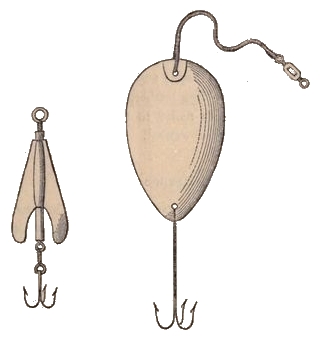
3. The first, and in fact the only reference that gives us any real information on either spoons or spinners, is in the first book written, that relates wholly to sea fishing; Sea Fish and how to catch them, by W. B. Lord, M.A. published in 1862. The reference is worth quoting in full. In a short paragraph headed "Spoon Baits", he writes:
"Whether invented by our very ingenious cousins on the other side of the Atlantic, or by the aborigines of the Polynesian Islands, which has been rather an open question, are exceedingly destructive baits for predatory fish of most kinds, whether inhabiting rivers, lakes, or the sea. They are easily made by cutting off the handles of albata-plate spoons of the size required. Drill a hole at each end, mount one end with a strong loop and swivel, and the other with a double or triple hook, and your bait is prepared for fixing to the trace (vide cut). The new spinning bait* (the italics are mine) is represented in the woodcut with the spoon, and is mounted exactly in the same way."
(a) Evidently the idea of using a domestic spoon is nearly a century old.
(b) The woodcut shows a spoon, mounted as a Norwich Spoon … but the wide end forward, a method of mounting recently revived.
(c) The new spinning bait illustrated, is a spinner, somewhat longer than the present day mackerel or baby spinner, and fitted with a triangle hook.
In the book this is starred, and a footnote states: "The new spinning baits are to be obtained from Mr. Hearder, Buckwell Street, Plymouth, at 6d each."
From this extract which is the only reference in the book, we learn that, although spoons, even at that date were apparently well known, the spinner, if not recently invented, had only just been put on the market. This gives the date of the first spinner as about 1861.
"Tackle Sea Angling this Way" (1964) John Michaelson at pages 86 & 87
10. Flatfish and Others
Flounders on gently sloping sandy or muddy beaches and in estuaries where they go well into fresh water provide good sport from the shore, with the boat angler having no great advantage. The record is 5 lb. 11½ oz., with the average between one and two pounds. Depending on the water temperature, flounders come within range of the angler about the end of April and stay until October. Ledgering for them with lug, rag, peeler or a strip of herring is the usual technique. The rolling ledger is effective where practicable. Once mastered, the most effective method is a baited spoon. The spoon must be big, with a long-shanked hook streaming well behind it baited with lug, rag or a piece of herring. A second small hook in a ring at the back of the spoon can be used to keep a lugworm in place.
The bait must not spin. The theory of this comparatively recent technique is that a flounder mistakes the spoon not for prey - it is not predatory - but for another flounder and pursues it out of curiosity or avarice, thus meeting the bait. Fish the spoon slowly near the bottom. Hooking may be difficult, since the flounder sucks rather than seizes the bait. This means hardly perceptible knocks repeated. Experience increases success in striking.
When float fishing, try to trot the weight along the bottom, with the hook trailing six to nine inches behind. The slight disturbance of the bottom arouses the interest of flounders nearby.
"Sea Angling" (1965) Derek Fletcher at pages 98 to 102
Chapter 12: Flat-Fish Family
… Their diet is a varied one, and fish have been taken with lug and ragworm, limpets, small pieces of herring and shrimps. Whilst in one area they will feed hungrily on limpet, on another coast only lugworm will produce fish.
… the best bottom flounder-fishing comes during frosty weather in a calm sea but a strong east wind puts them off the feed. My best 'bags' have been after dark, although they can be caught at all times of the day …
A surprising change has taken place in the technique of flounder-fishing during recent years. No longer does the successful angler cast his baited paternoster out, fit the rod to a beach tripod, and wait for a tell-tale bell to ring. True, many fish are still taken this way, but now the accent is on light tackle and keeping the bait on the move. This method is becoming a firm favourite with both boat and pier anglers.
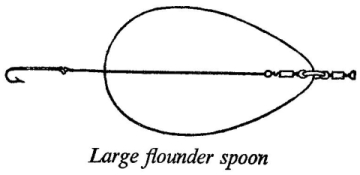
The most sporting method of taking flounders is with the baited spoon, the originator of this method being Mr. J. P. Garrad. Anglers owe a great deal to this gentleman, for his patience and his extensive experiments which began soon after the first world war.
An 8ft freshwater spinning-rod, with either a small light Nottingham-type or multiplier reel and 8lb b.s. line will give the maximum of sport. A two-part 6ft trace, linked by swivels, with a large loop at one end enables the type of spoon to be changed without untying. At the head of the trace there should be a ¾oz Jardine lead. There are several spoons on the market, but it is important not to get one too small. A 3in white enamelled or plated spoon is sufficient with a single long-shanked hook. The hook, of course, has to be baited and any of the baits mentioned will take fish. It has been found that white spoons are most suitable for dusk work and cloudy days … red-coloured spoons … are best reserved for clear water and sunny weather.
The principle behind the baited spoon is that the flounder, watching the wobbling spoon passing overhead, mistakes it for another flounder pursuing food and, overcome by hunger or curiosity, it swims up to investigate and soon seizes the tempting baited hook. Although most spoon-fishing is done froma boat, the technique can be mastered from groyne, shore or pier. Cast out, slowly recovering the line at a sufficient speed to keep the spoon revolving. Avoid weed-covered sea-beds and fish with the current.
Although I have already stated that my best flounder-fishing was in frosty weather, for successful spoon-fishing choose calm, mild weather. Cold weather tends to make the flounders slow to rise, and one will have just as much sport with other methods … Flounders keep to the deep water of the creeks at low tide, moving up with the flood tide to feed.
One important point is to make sure that only the spoon spins. A revolving hook will immediately put a flounder off, as it sucks or mouths the bait for a few seconds before taking it. It is not necessary to strike as the fish, when fully satisfied that nothing is amiss, will hook itself as it dives with the bait.
Although it was thought until quite recently that fish could only be taken trolling with the current, there are indications that just as many fish can be caught spoon-baiting against it. However, it is easier to control the depth of the spoon with the tide, and the beginner will do well to keep to this method until he has thoroughly mastered the technique.
"Pelham Manual for Sea Anglers" (1969) Derek Fletcher at pages 14, 48 & 49
Artificial Lures
Another productive lure is the flounder spoon and there are several types on the market. The white three inch ones are usually best, and the single long-shanked hook on the spoon is baited, generally with ragworm.
Mostly they are trolled behind boats, but the method can be mastered from low groynes and bottom decks of piers. It is a very effective method of catching flounders, particularly in harbours. When the vibrating spoon passes over an area of flatfish, the flounder believes it is another fish chasing food. Anxious not to miss the menu it flaps up to investigate and takes the trailing bait.
The rod should be laid across the stern of a slowly moving boat, with the tip watched constantly. Normally the revolving spoon causes the rod tip to beat, but an interested flounder will start it twitching. The line then tightens up and the rod bends as the flattie dives to the bottom, bait in its mouth.
… A comparative new spoon for flatfish in this country is the Rauto, a lure originally designed for Scandinavian waters, but proving its worth around the British coast.
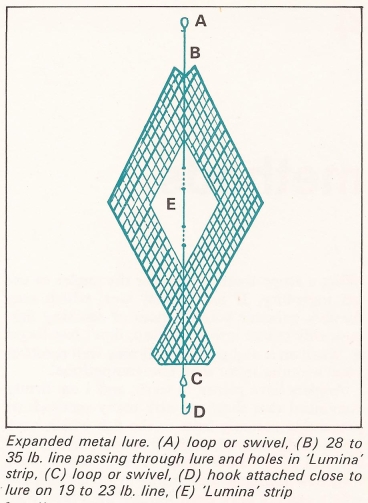
"Competition Sea Angling" (1970) Bruce McMillen at pages 45 & 46
4. Methods
One technique that has proved particularly successful involves the use of the baited spoon, a method devoted almost exclusively to the catching of flatfish, bass and eels. It was perfected by the late John Garrad ('Seangler') whose book on the subject is commended to all sea anglers interested in inshore fishing. This book gives every essential detail of the procedure to which Mr. Garrad devoted an appreciable portion of his lifetime, both testing and developing. The baited spoon technique basically involves the use of a baited hook which is closely linked to a metal or plastic spoon. The term 'baited spoon' may, therefore, be perhaps something of a misnomer, for it is the hook which is baited and not the spoon. Nevertheless, the addition of the spoon to the bait most certainly proves more attractive to the fish, and Mr. Garrad's work on this technique is a typical example of what the angler can do to improve his catches, simply by developing an idea rather than postponing and eventually forgetting it.
I have evolved a variation on the baited spoon theme, in which a strip of expanded metal, such as that used for loud speaker fronts, is utilised. The expanded metal can be cut into the shape of a flatfish, and on one of these baited lures, measuring 7¼ in x 4 in I have taken bass, eels, flounders, spur dogfish etc. Much smaller lures may, of course, be utilised with every success.
It is in my opinion, particularly important to attach to each lure a strip of 'Lumina', a highly luminous plastic which, incidentally, may also be attached with advantage, to normal hook-baits. These expanded metal lures work much better where there is a current. They do not spin, as do the orthodox baited spoons, which can be constructed by the 'do-it-yourself' angler out of plastic or stainless steel variety are normally more successful than are those made of plastic, this is probably due to the flash of the bright metal proving more attractive to the fish.
Here is another original idea which may well improve your chances of success. Obtain some tiny plastic or metal salt spoons, cut off the handles and drill a small hole into one end of the spoon and attach a swivel. Attach the other end of the swivel to the snood or trace, just above your hook which has been baited in an orthodox way. The tiny spoon, particularly if it is bright metal, will help to attract the fish to your bait, especially so if the current gives movement to the spoon.
"Cod Fishing" (1978) Bob Gledhill at page 102
Chapter Four
Boat Fishing
Other Lures
The baited spoon is a method very rarely used seriously in cod fishing, and its exclusion is understandable considering the existing variety of methods already practised, but because it is little used, don't think it isn't much good. If you can gauge the circumstances right, the baited spoon can be a deadly way of fishing.
The first time I saw an Abu Rauto spoon used, the angler who used it latched into a cod of 43 lb. When his next cast produced one of 35 lb and I was still only finding fish in the 12-15 lb range, I thought it time to take a closer look at the spoon.
There are two schools of thought about why the baited spoon catches cod. The first is that the cod picks up the vibration of the spoon, sees it flash, and its curiosity sends it over to find the source of the disturbance. It finds a nice piece of food and takes it. The other idea is that the spoon works when the cod are bloated out with food. At times when natural feed like sprat, shrimp or sand-eel are plentiful, the cod are disinclined to take big baits because physically they can't manage any more. But they see and feel a flashing spoon, and possibly through bad temper as much as curiosity, move over to snap at what is causing the disturbance. The cod sees a piece of food, not a huge lump of fish which it couldn't possibly manage, but a tiny morsel. Rather than let it go, the cod snaps the tiny piece of bait up. You or I couldn't manage a steak right after a seven-course banquet, but we'd find room for a nice little piece of Stilton.
Both ideas sound reasonable, but both rely on the angler moving the spoon frequently to keep up the vibrations. A good way of fishing with a spoon is to use it in conjunction with a steel paternoster, tied on a short snood. Lift the tackle up and down in the tide almost continually. You will probably have to modify the spoon by increasing the line strength and the hook size, as most are designed primarily for catching flatfish.
Two Hundred Sea Fishing Tips (1982) Ivan & Ivor Garey Tip 154
26. Flatfish
154. Flatfish special
It is well-known that flounders and dab, but especially the former, can successfully be caught with artificial bait. The flatfish is curious about everything that moves within its field of vision and will react by swimming towards the object. Usually it does not bite immediately. The fish first investigates the object and will not bite unless it discovers something edible. It must therefore be lured with artificial bait and must then be presented with a recognisable food item. This is done by tying a short length of line to the spoon or pirk. A small piece of lugworm, ragworm or fish is mounted on the hook and makes the "flatfish special". The baited spoon is allowed to sink to the bottom and is then retrieved about 30cm (a foot) every ten seconds. This involves approximately one turn of the reel handle at a time.
In some places this is the most attractive method imaginable. Except, of course, for the fly rod …
"The Complete Book of Sea Fishing: Tackle and Techniques" (1992) Alan Yates and Jed Entwistle at page 109
11. Tackle Basics
Spoons
Another favourite fish attractor; there are several types, including bar spoons which are primarily a casting or trolling lure. They are sometimes used in strong tides when downtide bottom fishing as an attractor on the trace above a baited hook. They are made from a flattish elongated piece of metal, usually chromed brass or stainless steel; hopefully this is shaped in such a way as to give it an action enticing to any fish that spies it being retrieved to a rod or trolled behind a boat. The Toby lure is a particularly effective bar spoon, obtainable in a number of sizes.
Wobbler spoons are often the plaice fisherman's choice. The favourite used to be ABU Tackle's rauto spoon which went out of production some years ago, but a number of similar models have taken its place. Best of these is probably Delta's sonic spoon; similar in shape and action to the rauto, it also has slots in its body to give its action added effect, and the water supposedly creates some fish-attracting sound as it passes through the slots.
Spoons that spin are usually shaped just like the business end of a conventional spoon, and revolve around a central rod or wire. There are several makes on the market, usually made from chromed brass or steel, also from white or coloured plastic. They have long been a favourite of flounder anglers and large spoons are sometimes used by cod fishermen as an attractor; these are fished on the trace, 1 to 3ft (0.3 to 0.9m) above the hook.
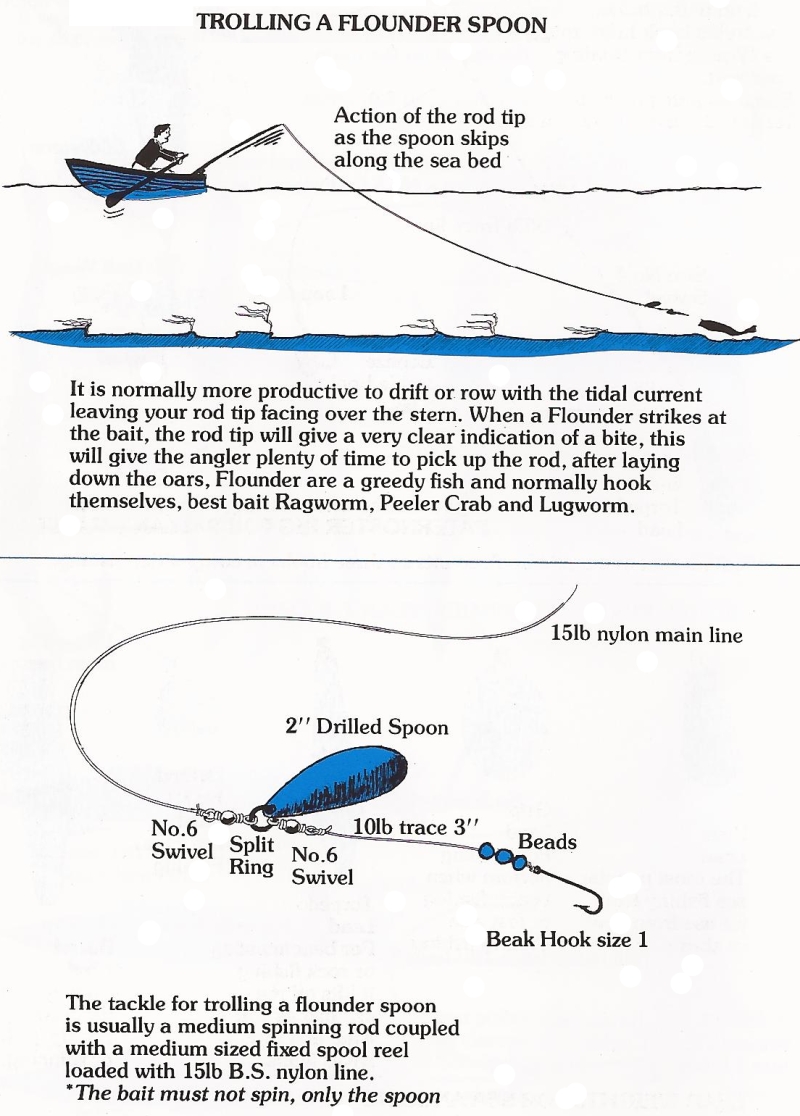
"Hooked on Sea Angling" (2011) Martin & Dave Beer
"Salt-Water Fishing: A Step-by-Step Handbook" (2006) Martin Ford & Bruce Vaughan at page 33
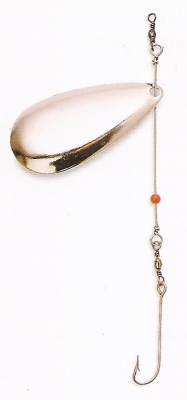
Artificial Baits
Spoons
Spoons are rather a specialist item of tackle and tend to be used by the sea angler when fishing for flatfish. As the name suggests, the shape is that of a spoon, and some sea anglers make their own from old metal spoons. They are available from tackle shops in two varieties, metal and plastic, in sizes from 2 - 4in (5 - 10cm) in length.
The plastic variety is produced in a number of different colours, including orange, yellow and white, while metal spoons can be made more attractive by tipping the edges with red or white paint. However, a custom-built, homemade version with a string of attractor beads may well out-fish a shop-bought spoon. It is the boat angler who will benefit most from using spoons, as they are easier to work in the tide from a boat and will require little or no weight.
Species such as flounder, plaice and turbot can all be tricked by the fluttering movement of a spoon as it rotates in the tidal flow. Like the spinner, some spoons have a split ring fitted at each end. A small swivel is fitted to each split ring, allowing the spoon to rotate as it is retrieved. One of the swivels is tied to the main line, and a short length of 10lb (4.54kg) line some 6in (15cm) long is tied to the other line. To the end of this a hook is attached, usually a long shank, fine wire, size 1 or similar. The addition of a few coloured beads on the hook length gives the spoon that vital bit of added attraction.
Another version of the spoon rig is where the spoon is threaded onto a central axis at the narrow end only. A weight is fitted below and the hook is attached further down. This method of attachment allows the spoon to rotate around the axis, disturbing the sand and mud with the larger end of the blade. This imitates a small flatfish trying to escape and is a good presentation for turbot.
With either method the hook is baited with ragworm, lugworm or crab bait. As the spoon moves across the bottom with the tide, it sends up small clouds of sand and mud. This suggests to any nearby flatfish that a small crab or prawn is scurrying over the sand. Once spotted, the hungry flatfish moves in for the kill and is hooked in the process. Another reason for the spoon's great catching ability is said to be that bigger flatfish look upon the spoon as a small flatfish, trying to run off with a piece of bait. In an effort to stop this supposed smaller fish, the spoon is often hit quite hard by a larger specimen.
An important note to bear in mind when using a spoon is to fish it with the tidal flow. This is due to the fact that flounder, in particular, feed and swim with the flow. Spoons can also be used from the shore, but it will be necessary to add weight to the spoon if it is to be cast any distance. If weight is added this should be done in the form of a barrel lead or series of small ball weights that can be fitted onto the central axis.
When to Use
Spoons are, in the right hands, more effective than a static bait and should be used at every opportunity, especially if flounder are the quarry.
Top Tip
If making your own spoons or buying shop-bought patterns, it's good practice to add plenty of colourful beads to the trace below the spoon. These beads will give the spoon an extra attraction.
Flies
"Sea-fishing as a sport" (1865) Lambton J. H. Young at pages 64 & 65
Baits
Flies … are used either with rods, as in river and lake fishing, or else by whiffing. White flies are found to be the best, and, when used of a night, large numbers of bass, mullet, pollack, or mackerel are taken. I have observed an old man-of-war's-man make a rough fly out of a large sea hook and some white pigeon feathers; the fly was put on a light line and the boat rowed at a good speed in a circle, and in nearly every case bass were taken, when his neighbours could not get a bite, and wondered at this man's success who often returned with a dozen or more fish of large size as the result of his superior tact. In the River Dart some years since a clergyman used to drift in his boat with the flood tide of an autumn evening, and fish with the white moth flies, and by this plan obtain good sport; his salmon rod was severely tried by the strength of a fifteen-pound bass. Often any rough composition of red and white feathers on a hook, with red sealing-wax for a head, is dignified with the name of a fly, but I much doubt if a salmon or large trout would be taken in with such monstrosities.
"The Sea-Fisherman" (1884 - 4th edition) James Carrall Wilcocks at pages 86, 88, 89 & 90
Fly Fishing at Sea
Fly-fishing at sea was formerly confined to the few, but is now very generally practised. In favourable positions it may be followed from the shore, where steep rocks with deep water, or a pier-head, or shingle beach at the mouth of a bar-harbour offer points of vantage, whence the fly may be cast without the embarrassment of a steep wall of cliff; but such are few and far between, and as a rule it is much more successfully carried on from a boat.
For materials the whitest goose feathers to be procured, with such blue, green, red, and yellow feathers and wools as are commonly used to tie flies for salmon and salmon trout; also any of this kind half worn out may be used for sea-fishing, and if of a dark colour a few fibres of white goose feather may be added to the wings with advantage. The following are those most adapted for general use:
1st. A salmon fly, red body, gold tinsel, a bushy tail, gaudy and white wings (fig. 33, a).
2nd. Irish or Scotch rolled fly, if fly it may be called, either with or without a red worsted body. The feather to be taken from the bottom of the neck of a white goose in the back, just between the wings, then to be rolled up like a leaf between the fingers, and lashed on by the root of the feather to the head of the hook, so that it may point straight back over the hook. This is a very effective bait, and has long been a favourite on the Irish and Scotch coasts, although I have not heard of its use elsewhere (fig. 33, b).
3rd. Hearder's fly or feather bait. This is made with two small red or white goose feathers tied flat one on each side of the hook without a body (fig. 33, c).
These three flies may be made on hooks Nos. 8, 9, 10, or 11 according to the sized fish expected to be met with. (See cut of hooks, fig. 63, p. 211.)
4th. A plain white fly, consisting of white wings cut from the quill-feathers of a goose or swan on a bare white hook, No. 10.

5th. white fly of a large size, hook No. 8, body red, green or blue wool, ribbed with gold and silver twist or flattened wire, or the body red, green, and blue wool in succession, without gold or silver wire.
6th. "The Shaldon Shiner", so named from the village of Shaldon on the west side of Teignmouth harbour, close to which this fly was used with great success by the late J. C. Hele, Esq., one of the most expert fly-fishers of his day both in salt and fresh water, and through whom the author was induced to adopt fly-fishing at sea. It is a kind of imitation of the dragon-fly. The body is as thin as possible, being nothing but flattened silver wire, a small brush of scarlet feather for the tail, a little green, blue, and red dubbing out of an old turkey carpet for the shoulders, and bright blue wings, to which add half a dozen fibres of goose feather in front. With this, fishing at the mouth of a river-harbour, or in the pools just inside, you will probably take a sea trout or two, or even a salmon, particularly if you fish at the beginning of the ebb tide. Make it on a 9, 10, or 11 hook (fig. 63, p. 211). In the Taw and Torridge estuary at Instow, N. Devon, the fly in use is made with white and grey feathers and a silver body, and with this great sport is frequently obtained.
A rough but useful fly may be made out of white goat's-hair, with a body of red wool. The beard on account of its length is preferred, but that from the body if long enough will also answer.
Two flies will be quite as many as you can conveniently cast, and more will only embarrass you; but if not accustomed to fly-fishing in fresh water, as well as to boating at sea, employ a man to pull, for you will find it rather awkward work to manage the rod and keep your footing in the boat at the same time, and had better be satisfied with towing or trailing your line after the boat, until you have practised throwing a fly on shore. The loops at the heads of the flies should be either of fine silk line, fine snooding, or double twisted gut.
"Hints and Wrinkles on Sea Fishing" (1894) "Ichthyosaurus" (A. Baines & Frederick George Aflalo) at pages 49 to 54
Methods of Sea Fishing
Fly fishing for sea fish - chiefly bass, pollack, mackerel and herring - is not quite the same as the somewhat more difficult practice of throwing the fly for trout, salmon or grayling. The "fly" resembles … no living creature, fly or otherwise. Perhaps the bass take it for a small fish.
… Such flies are best white; and for this reason I imagine that they are mistaken for silvery brit.
But fly fishing, as generally understood in sea fishing lore, merely consists in getting between the wind and the fish, which are generally found by the help of the gulls, letting out your fly and line to a sufficient length, and letting the wind accomplish the rest.
The point to remember is that, as there is a good deal of line out between the rod tip and the fish, the angler must strike hard … and the moment you feel any check on the fly. Of course, when the bass are skipping all over the surface in great numbers, you may be unlucky enough to hook one in the tail or back; but this will not happen often, and if your angling conscience is very uncompromising you can always return it to the water alive. In such cases, the firmness of one's scruples is, curiously enough, found to depend on the presence or absence of other fishermen.
But the fly is used in salt water in two other ways: it may be trailed behind a boat for mackerel or pollack; or it may be dropped beneath the surface, and worked at various depths, chiefly for pollack.
… The best kind of fly is one with a body of red worsted bound with tinsel, and a couple of white feathers for wings. Such flies cost about two shillings a dozen.
When, owing to some intervening rock or strong current, the boat cannot be moved sufficiently near the fish, two flies, one a dropper, can be worked effectively with a hand line and kite arrangement. The dodge is about five thousand years old, and hails from the East.
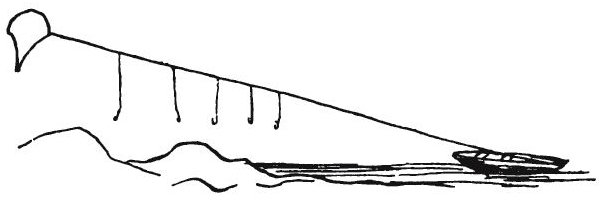
Working these flies - and one generally uses a trace of from three to a dozen - behind a boat is known as whiffing or railing, and is a very effective way of fishing during the summer months, particularly for pollack, where there are plenty of rocks. The trace … is used with a light lead at the end or no lead at all, the depth being regulated by the rowing speed. When sailing, heavier leads are necessary to keep the flies below the surface. Pollack are sometimes caught in this way quite near the bottom, and, as the first bait should move briskly, it is necessary to use large leads. If the bait moves slowly at such depths , gurnard will probably take it. The lead should be in any case at the end of the line, so that bites are easily felt.

Sometimes an indiarubber sand eel or some bright kind of spinner is more effective with such tackle than the flies, but only one must be used, as is also the case with that most deadly of all, the live sand eel. This then is a short account of flyfishing in salt water … Truly, the sea fisherman never knows what may get on his hook next, maybe a sea serpent, a seal or a missing convict.
"Angling in Rivers, Lakes & Sea" (1920) Walter Matthew Gallichan ("Geoffrey Mortimer") at pages 103 to 107, 110 & 111
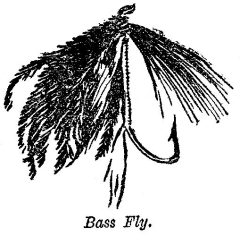
Part III
Sea Fishing
Chapter I
Angling in the Sea
Fishing from Rocks
Rocks are often excellent stands for fly fishing for bass. I regard this kind of fishing as a good second to angling for game fish with the fly; and if you are by the seaside when bass and pollack are about, I advise you to try your skill with the fly-rod in competition with these sporting fish of the sea. Bass flies are now a speciality of the fly-tyers, and every year attention is being paid to this fine sport with the game-fish of salt water. The bass is not the only fish that will take an artificial fly. Grey mullet, mackerel, sea trout, and occasionally salmon, are to be lured with the fly in salt water. Pollack, codfish and garfish are also surface feeders, and herrings will sometimes rise readily to the fly.
Chapter II
Bass, Pollack, Grey Mullet, etc.
General Hints
… For flies choose some of the ordinary salmon dressings, a large Alexandra, and patterns with tinsel bodies. A salmon rod is perhaps the best implement of its kind for bass-fishing with the fly …
Bass Fishing with the Fly
Having found a rock hugged by bass on the flood-tide, cast your fly and work it with little jerks either upon or just under the water. You will probably see or hear the splash of fish. Cast over these splashes and keep out of sight, for bass are often shy of the rod. Never row a boat amongst a school of bass, but have your craft held within long casting distance. Follow the shoals cautiously and avoid disturbing them by flourishes and splashing with the oars.
When the days are glaring and the sea a translucent blue you must take advantage of a cloudy night for bass-fishing with the fly …
The Pollack
Pollack are caught with the fly … Pollack will run at almost any kind of big fly when they are chasing small fry near the surface …
Chapter III
Other Sea Fish
Mackerel
Reeling
Reeling, or railing from a boat, is a favourite mode of mackerel fishing at many seaside towns. A sailing boat is usually hired for the sport, but you can fish from a row-boat. You will need a trace lead with swivels, and a yard or two of gut, and for bait use a piece of fish skin tied to the hook. When the fish are surface-feeding, a light lead will answer, but occasionally a heavier sinker will be required. Geen's lead can be recommended for mackerel reeling.
Let the bait spin behind the boat, and hold the rod ready for a pull. A piece of clay-pipe stem, threaded on the gut above the hook, is often used, and there are times when this lure kills a large number of fish. Sometimes several hooks are lashed on the gut above and below the pipe stem. A piece of chamois leather, or a bit of an old white kid glove, may be used, but the clay-pipe stem is almost always taken. Small spoon-baits, baby-spinners and artificial metal minnows will entice mackerel.
By all means try the artificial fly for mackerel when they are on the surface. You may have lively sport at such times, for mackerel are attracted by any bright object moving through the water …
"The Sportsman's Library: Sea Fishing" (1935) Major D. P. Lea Birch ("Fleur-de-Lys") at pages 41, 100 & 101
Chapter II
Boat Fishing
For bass, sole skin flies and a gay affair known as the Shaldon Shiner are likely lures. If the fisherman happens to be able to tie his own flies, he will have no difficulty in devising something attractive.
Chapter VI
Bass
As to flies, the angler, if he is at all handy with his fingers, will find no difficulty in devising enticing patterns. If on the other hand he prefers to buy his bass flies, he will find that the principal tackle makers stock several good patterns. A bright silver tinsel body, rather thin, with a peacock herl tail and white wings mixed with peacock herl and scarlet macaw strands, will be found good. This is more or less the well-known Alexandra. The Shaldon Shiner, silver tinsel body, tail of scarlet fibres, red and blue pig's wool at shoulders, with bright blue and white strands for wings, is another killing pattern. Then there is the soleskin fly minnow, Bathgate's being an attractive kind; also there is the soleskin fly with bright silver body and tinted wings.
"Bass: How to Catch Them" (1955) Alan Young at pages 73 & 74
Chapter II
Tackle
Fly Fishing
I have headed this section "fly fishing" because many books on sea angling mention the subject. There may be sea anglers who really "fly fish" for bass. I have never met any and, on the few occasions when I have taken a trout rod and suitable flies with me, I have never got within casting distance of bass …
Bass can be caught on feathered hooks, possibly cast with fly-fishing technique, but these flies are designed to imitate small fish so they should more rightly come under the heading of spinning.
The commercial bass (or mackerel) fly certainly catches fish, especially when it is towed behind a boat or fished deep on the "sink-and-draw" principle. With a fixed-spool reel it can, too, be cast a considerable distance - fished like a spinner.

The lure is not an ideal one, however, even for its purpose, and a lure of the streamer type, common in America but not often used in salt water in this country, is a far more attractive imitation.
Streamer-type flies capable of catching bass can be quite easily made at home. They consist simply of two 2½in or 3in cock's hackles bound near the eye to the shank of a long-shanked hook of suitable size. I use salmon hooks … but effective lures can be made with ordinary sea-fishing hooks (Fig. 13). The hackles can be natural, white or buff or can be dyed in any desired colour. I have found plain white to be as good as any.
Half-moon leads or split shot can be added to give sufficient weight for casting (the fixed-spool reel is ideal for this) and the lure is fished like a spinner.
Spinners
"Guide to Sea Fishing and the rivers of south Devon and descriptive catalogue of their prize river and sea fishing tackle, cricket, archery, croquet, umbrellas, parasols &c" (1875 - 7th edition) J. N. Hearder & Son at pages 83 & 84
Hearder's silver Spinner
Before dismissing the subject of whiffing, a few remarks are necessary on the more extensive application of the silver Spinner. The success which followed the introduction of this sea bait by the writer has increased with its use, until its utility is at present so universally recognized that the sale amounts to tens of thousands annually. This fact alone is sufficient to establish its value. Not only is it useful for mackerel, but other and larger fish are also attracted and captured by it; hence their sizes have been increased to meet requirements. Even whiting, plaice, and cod, which are bottom fish, often take it freely when used at the end of a chopstick or a boat-shaped rig. In the neighbourhood of rocky headlands large pollock of 10 or 15 lbs are caught with it, along the Scottish Coast, in the Shetland Islands, amongst the Hebrides, and on the coast of Norway, Codling and large Cod are taken with it at the bottom, whilst in the ocean extra sizes take the Dolphin, Albacore, Bonita, &c. At Gibraltar, Rangers, Bass, and other fish are freely taken with it by spinning with a rod from the rocks. In the Mediterranean it takes several of the surface fish, and at the Cape of Good Hope it takes the Snook, Cape Salmon, and fish of that class. A list of these spinners will be found at page 28.
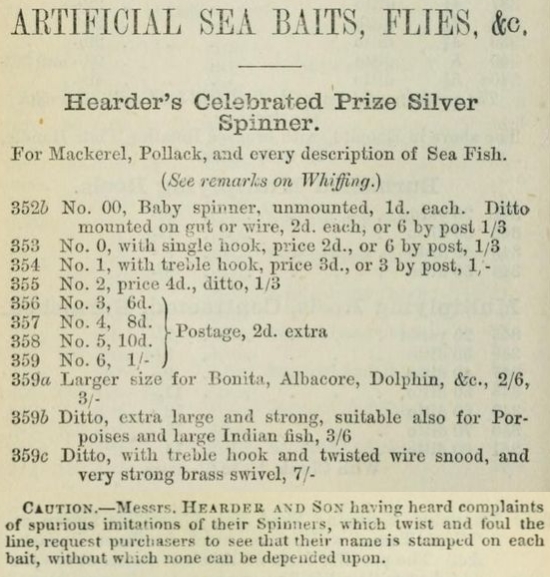
"Hints and Wrinkles on Sea Fishing" (1894) "Ichthyosaurus" (A. Baines & Frederick George Aflalo) at pages 54 to 56
Methods of Sea Fishing
Spinning, properly so called, differs from the foregoing method [4] in that the angler is stationary whether in an anchored boat, on a jetty or among the rocks.
The rod may be shorter and stiffer than that used for fly fishing; eighteen feet are a good length for the latter, while for spinning thirteen will be found sufficient.
The tackle must be very strong, and the … trace may be attached to a single bait. There is a large choice of such baits; and perhaps Hearder's plano-convex minnow, india rubber eel and double flight of rubber bands are equal favourites. For bass, nothing can beat the minnow, except, perhaps, a sand eel; but sand eels are difficult to procure and very fragile and, therefore, they easily spin to pieces. So the tin minnow remains first favourite. There is also a spinner sold consisting of a small flat piece of mother-of-pearl, on which I have also hooked a few bass. For pollack, the rubber worms or bands are most effective, especially those made in grey. The red are more used in the sun.
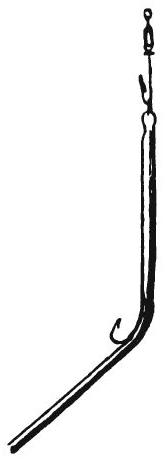 |
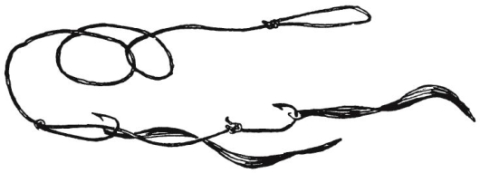 |
 |
| Hearder's indiarubber eel | Hearder's double flight of rubber bands | Hearder's plano-convex minnow |
Spinning consists in throwing the bait as far as possible, letting it sink, and drawing it back with a slow, jerky action. The minnow requires no lead, being sufficiently heavy to carry out the line and to sink even in the tideway. The rubber baits (and even the minnow in a strong wind or current) must, however, be supplemented with a small lead, pipe-shaped and not round.
Experts at this kind of work are in favour of throwing across the tide, but I have hooked fish throwing against it, or with it, as other circumstances and surroundings made convenient.
In order to spin from a boat, it is by no means necessary to stand up; indeed, few people understand the art of standing up in a tiny boat without danger, especially on a breezy day, the day of all others for spinning and bass fishing generally.
I forgot to mention that a small swivel should be placed just above the bait, enabling it to revolve free of the rest of the line.
[4] Editor's note: the "foregoing method" being whiffing and railing
Modern Sea Angling" (1921) Francis Dyke Holcombe at pages 66 & 69
Chapter V Bass
An interesting method of catching bass which is practised from the pier at Herne Bay was fully described in an article in the Fishing Gazette about three years ago, so that there is no need to say very much about it here. A fine silk line and light unweighted spinning bait is used, and all sorts of ingenious devices (such as the affixing of small air balloons, feathers, etc., to the line) are employed to get the lure out to the fish, when they are "schooling" at or near the surface some little way from the pier. In its way this style of fishing is the nearest approach which the writer has heard of in this country to the famous "tunaplane" or kite used by American sea anglers at Santa Catalina, and described in one or two of the late Dr. C. F. Holder's delightful books. The present writer has never fished at Herne Bay, so he cannot say anything about this fishing from actual experience, but he is told by a friend who knows the place pretty well that the bass taken in this way are mostly small.
A more restful method of course, and one more commonly followed, is to whiff for them, using tackle similar to, but rather lighter than, that employed in whiffing for pollack - of which more hereafter. Of whiffing baits there are many - rubber sand eels of various colours, wagtails, minnows, etc.; and most of them will kill bass at times. An attractive whiffing bait may be made by cutting once through an ordinary india rubber band, afterwards painting one side with silver paint, which must be renewed from time to time. Bass may also be caught at times by casting a rubber eel or similar lure from rocky headlands and similar places, either with a spinning rod or a double-handed fly rod … It is perhaps unorthodox to say so, but the writer has proved by experiment that when bass refuse an artificial sandeel they will sometimes accept it when furnished with a "last" of mackerel on the bend of the hook (after the style of the pollack fisherman), although when the lure is garnished in this way what on earth the fish take it for the writer does not know.
"Sea-Fishing from the Shore" (1940) A. R. Harris Cass M.B.E. at pages 24 & 25

Chapter II
Fish to be Caught
"When the corn is in the stock, the mackerel are in shore" is a familiar phrase near some parts of the coast … I am afraid I cannot recommend … shore fishing as within the accepted meaning of that class of sport, as a practically motionless baited hook lying on or near the bottom would not interest a mackerel. I have caught mackerel from the shore, but only by means of a "Little Witch" spinner.
"Bass: How to Catch Them" (1955) Alan Young at pages 34, 35, 71 & 72
Chapter II
Tackle
Spinners
… My own favourites are a 2in nickel and copper Vibro spinner for rough water and a mother-of-pearl fly spoon for calm clear water. I have used others in the past and have caught bass with them, but in these days I feel that if bass are to be caught at all on spinners, one of these two patterns is likely to be successful. I know anglers who are prepared to swear by other patterns with equal enthusiasm and, I do not doubt, with equal or better records of performance to back their views. Almost any type of spinner that looks in action like a small silvery fish or a sand eel is likely to catch bass. I think the main qualification is confidence on the part of the angler. If he is completely confident in the power of his lure he will fish it carefully and well, and if bass are there he is likely to catch them.
Before passing from the subject of spinners I must mention wagtails, for these spinning lures - which probably resemble both small fish and eels - are held in very great esteem in the west of England, where they have accounted for many good bass.
Chapter IV
Methods
Spinning
… In spinning for bass the object is to present to the fish an imitation of small fish or sand eels. A suitable lure on its trace is attached to the line. It is cast into the sea, allowed to sink to what is considered an appropriate depth, and recovered by reeling in. As it is drawn through the water the lure spins, dives or wobbles according to its nature.
When a bass "takes" there is rarely need to strike. Instantaneous and momentary tautening of the line is usually sufficient to drive home the hook, for bass have no time to hesitate when seizing active prey.
Since the fish that the lures imitate spend most of their time in the upper layers of the water, it is there that spinners must be used. This is fortunate, for fishing a spinner at depth entails heavy weights and can even then only be done effectively by trailing the apparatus behind a boat.
Spinning can be done from boats, projections and rocks and there is no object in going into separate detail for these positions since the method is the same in all. It can obviously be practised to greatest advantage when a large proportion of the bass present or in passage are feeding in the upper water - a condition likely when shoals of sand eels or brit are also present. When I have leisure to fish a whole tide, I usually fish by some method other than spinning, but I have at hand a spinning rod with lure already mounted so that I can immediately take advantage of any shoal of brit etc., which happens to put in an appearance.
In winter I occasionally fish an imitation eel in the breakers, choosing for this pleasant exercise a wide bay where one can walk for, perhaps, a mile or more along the beach without interruption. As the tide comes in I cast the lure into the waves and allow it to be tossed about until it is eventually cast up. This means moving slowly along in the direction of the current, casting every twenty yards or so. Though not so productive, perhaps, as most of the other methods, it catches bass and is a pleasant way of spending a pleasant day - particularly one of the bright days that so often follows a gale.
"The Modern Sea Angler" (1958) Hugh Stoker at page 80
Chapter Eight
Fishing While Under Way
… For this kind of slow trolling a natural bait, such as the lesser sand-eel, whitebait or mackerel lask, frequently proves more effective than the revolving mackerel spinner. Often the two last-named baits can be used with advantage with some other type of lure, and in this respect experience has proved the worth of the combined clay-pipe stem and mackerel lask, illustrated in Fig. 31 …

"Sea Fishing for Beginners" (1970) Maurice Wiggin at pages 103 & 104
Chapter VI
Rock Fishing
… I personally am very fond of fluttering little bar-spoons, and undoubtedly the fish find them very intriguing, but they are very light, really too light for this job, and although mackerel go mad about them more often than not, it means that you have to use a weight on the trace to get casting distance and to sink them far enough. This is really undesirable: you are fishing fairly badly restricted spaces, as a rule, it is accuracy you want more than distance, and the weight should therefore all be concentrated at the tip, the very end - it's like throwing a dart or shooting an arrow.
But if you do have to attach lead, so be it. You should have a trace about two or three feet long, no longer, attached to your reel line via the inevitable swivel. You can hook a quickly detachable Hillman Lead on to the top eye of the swivel, thereby lessening any tendency to line kink; or you can incorporate a costly though very lovely Wye lead in the trace - it carries its own swivel; or you can wrap the line round the incisions in a spiral lead; or you can simply fold a half-moon lead over the top eye of the swivel. This is the easiest method. A half-moon lead comes to you as a full moon, with a hole in it, like a Polo mint. It is folding it over that makes it a half moon. I like that lead: it is its own built-in anti-kink device. Of course you can use Devon Minnows, sinking plugs, anything in the armoury: but I guess the most popular and effective spinner is one version or another of the celebrated long narrow spoon. This really does work: especially the sort which is thick and very heavy for its size, and which has a subtle kink or twist built into it which gives it a lovely capricious flutter and flash and wobble. This type of spoon - it comes in many variations - is not only attractive to bass and pollack, but has the weight you need to flick it out.
Don't be put off if the tide rips mighty fast and swirly past your rocks. Bass won't be put off: they are great-hearted adventuring fish, the only fish, really, that will come right inshore and nose among the rocks in such a swirl of heavy water. Fish the race with confidence - and plenty of weight on your spoon.
Spinning is emphatically not a matter of simply chucking your lure out and stolidly winding it back in. By no means. You can work a touch of artistry into your retrieve - indeed, you'll have to. Let the bait rise and fall in the water, varying its depth partly by the speed of your retrieve (the faster you wind the more it will climb in the water) and partly by raising and lowering the rod tip. Vary the path of the lure, too, laterally, by wagging the rod, even swinging it from side to side. Vary the speed of the retrieve at all times - slow down, twitch it, give a quick couple of turns, stop dead (for a second only!) start again slow, accelerate, decelerate - do everything you can to give your lure an erratic course, down there in the water. Let the rod and line and lure be an extension of your arms and hands: think lure: think fish: project your senses like antennae (which they are) down into the water with that wriggling, quivering, sinuous, dodging, presumably in-jured, pitiful little lure.
"Estuary Fishing" (1974) Frank Holiday at pages 66 to 68
Chapter Four
Baits - Natural and Artificial
Pirks, spinners and imitation eels
Plugs are seldom discussed in reference to sea-angling no doubt because, as was the case with pirks, they still remain to be 'discovered'. Pollack, mackerel and bass will readily take a suitable plug in the right conditions. In summer when predators are feeding on brit and other fry a small plug fished in the surface layer can be quite deadly. Such fishing can be sea-angling at its best. A light spinning rod, fixed spool reel and 6 lb monofil line is the type of outfit to use for this work.
There is much room for experiment in the design of plugs for sea fishing. No one for instance, as far as I am aware, has ever produced a hollow plug which could be filled (or partly filled) with water in the manner of a bubble-float so that it has casting-weight while at the same time being buoyant. Bass and other fish can be very selective when feeding on brit which may be no more than an inch long and it is often useless to try and get them to take an artificial bait which may be three times that length. In these conditions a small plug drifted down to them so that it mingles with the brit is often quite effective. Balsa is a good material to use for these mini-plugs deployed on a drift-line and the result, in the best models, can be a quivering, incredibly life-like action.
Spin fishermen, whether from boat or shore, tend to rely on old favourites such as the 'German Sprat' which has taken thousands of bass off Splaugh Rocks in Ireland. Personally I am not very keen on these baits although I occasionally use them. The narrow spoons which Sweden produces in such excellent variety are also popular and very effective. However there is more to a spoon than stamping out a graceful-looking metal profile and putting a curve into it. It is my belief that spoons and other artificial baits induce takes not so much by their appearance as by the rhythm of vibrations they set up in the surrounding water. Thus some spoons fish well while others, although similar in appearance, fish badly. Only practical tests will determine which is the best fish-catcher. This of course is also an argument in favour of making one's own spoons in quantity and testing them out methodically in actual fishing.
Chromed brass rims from car headlights can be obtained from any scrap-yard. Using sharp tin snips several long narrow spoons can be obtained from each rim. The profile is obtained from a photograph or is a carefully considered design of your own. It is drawn on thick cardboard, very carefully cut out and then the profile is stencilled on to the metal. The simplest way of making the spoon-blanks concave, when they have been cut out with tin snips, is to make male and female dies out of hardwood, put the blank between the two, then draw them tight in a bench-vice. No two spoons will come out exactly the same and the only way of finding out which is the good, the bad and the ugly is to fish them. The majority will take a few fish in favourable conditions. Some you will stop using because they never seem to catch at all. One or two will nearly always catch fish although, in spite of the most careful weighing and measuring, you will be unable to discover why.
In view of the numerous experiments conducted on the design of artificial baits it seems surprising that there is so much to learn. An Irish professional fisherman, who had made thousands of baits of different sorts, told me that bronze has interesting qualities for bait-making. He believed this so strongly that he was prepared to saw up an old engine-bearing by hand in order to obtain the material. I am not prepared to scoff at this belief and it could turn out to be very sophisticated and scientific if it was fully understood. The fact is that we know very little about the sort of signal being picked up by a predator via the nerve-cells along its lateral line. It seems possible that baits having a certain resonance as they pass through the water could well have an attraction so far undescribed. After all, the alloy used in a bell is critical to the sort of sound it produces. It tickles the fancy to wonder what sort of effect you would get - no expense being spared - if a gold alloy was used. In fact I once heard of a man who used this very material while fishing at great depth in Lake Windermere for char and he had some good catches.
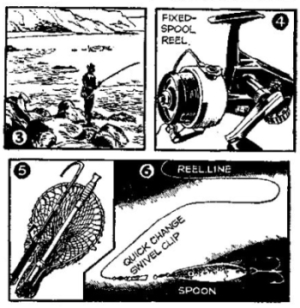
The Daily Mirror, Thursday 9 January 1975 at page 23
Fishing with the Experts
Reef Bass No 2
By Hugh Stoker
- When spinning off rocks I use a two-handed, 9ft. hollow glass "salmon-type" spinning rod. The medium capacity, fixed spool reel is loaded with 11 lb. b.s. line.
- It's advisable to use a good quality reel with a saltwater-proof specification. Alternatively, rinse your reel under a freshwater tap after each fishing session.
- You will also need a folding landing net or telescopic gaff to help land big bass A net is preferable as it does not injure the fish as it does not injure the fish.
- When spinning over shallow rocks I usually use a slow-sinking wobbling spoon, like the ⅝ oz ABU "Toby" shown here. Being self-weighted, it casts well without any up-trace lead.
The Daily Mirror, Saturday 24 November 1979 at page 25
By Hal Mount
When boat fishing for whiting, add a perch or similar spinner (finest hook) to the trace about 8 in. above the baited hook. Since trying this method, Colchester sea angler M. R. Waite has doubled his catches.
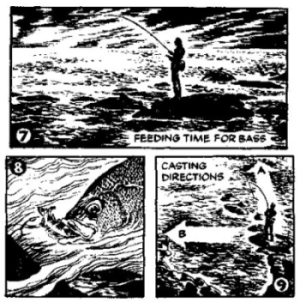
The Daily Mirror, Friday 19 January 1975 at page 23
Fishing with the Experts
Reef Bass No 3
By Hugh Stoker
- Reef bass often feed most eagerly around sunrise and sunset. Another good time to try spinning for them is during an incoming tide. After costing out allow the lure to sink, but don't let it snag the bottom.
- Feeding bass enter rocky coves in search of small fish. They often venture very close in, and towards dusk may grab your lure when it is only a few yards out.
- Two methods of spinning from an out jutting rock position. Most common casting direction is seawards (arrow A), but casting parallel with the shore (B) often produces even better results.
"Go Sea Angling" (2010) Mario Massimino at page 25
Rigs
Spinning Rig: Sometimes it may not be possible to obtain fresh bait. As an alternative to this you can spin artificial lures. This rig is similar to a running ledger rig - the line is threaded through a barrel weight and a bead and then tied to a swivel. A piece of line is attached to the other end of the swivel about 18 inches long and to this is attached a plastic eel or similar lure. This method can be deadly for predatory fish. It is cast out and then retrieved slowly, giving the lure a life of its own. Keep the bait moving for two reasons; firstly, an artificial lure lying on the bottom isn't going to catch anything except seaweed and rocks and that's the second reason, you will snag the bottom and lose your tackle.

"Sea Angling Pocket Rig Book" (2013) Fishing Made Easy Series M. P. Dawn Publications
Spinning Rig
This rig is mainly used for light spinning with rubber lures (Red Gills etc), mackerel spinners and live or frozen sandeels. Cast out from beaches or the rocks, this method can be deadly for bass, pollack, mackerel, scad and garfish.
Parts List
- 6" to 8" shockleader
- 12" to 24" hook length
- 1 x barrel weight
- 2 x pieces silicon tube
- 2 x small swivels
- rubber sandeel etc or 1 x size 1/0 to 2/0 hook

Light Rock Fishing
Light Rock Fishing ("L. R. F.") explained here and here
Light Rock Fishing Blogs
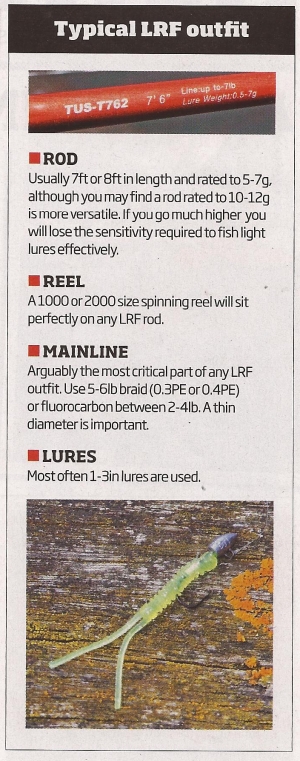
Alan Yates' Fishing Blog: Spring 2014
Summer is on the horizon and should be early this year with the mild winter and it won't be long before the first mackerel arrive at the northern end of the English Channel which, along with the mass crab moult and the return of the small bait fish like whitebait, sandeel etc., will fuel some excellent shore fishing. It's a great time of year as species spread around the coast in the clearing water although it's a whole new ball game in terms of the fishing.
Back into the tackle box go the feathers, the floats, all manner of lures and I have taken to adding an L. R. F. (Light Rock Fishing) rod and braid reel to my summer shore sea fishing tackle in recent years as an alternative method for those days when standard beach gear doesn't happen. L. R. F. is mostly about catching the small fish when they are all there. Using a single small hook or lure with all the lead on the hook, a small spinning rod and braid line allows the angler to fish the nooks and crannies with worm or lures.
It works best in the wilds of Ireland where you can trickle and tickle a lure alongside the steep rock marks and in and out of the kelp fronds and rock ledges from cliffs in search of wrasse and bass but here at home its surprising what you can catch close in if you scale down enough and, although it is mostly about small fish, when you hook a bigger one the gear allows even a 12oz fish to perform. L. R. F. from the pier, jetty, beaches etc, especially from a pier with stilts or piles (e.g. Deal Pier) can prove great fun for mackerel, garfish, scad, coalfish, pollack, even bass.
I recently fished from a beach on the Isle of Wight with L. R. F. gear swimming a ragworm close in under the edge of the estuary lip. The bass where mainly under 2lb but they attacked the worm as I retrieved it slowly and on 15lb braid and a 7ft spinning rod, I had discovered a way to make chequer (small bass) fishing enjoyable.
L. R. F. may be typecast by its name, light rock fishing being the very basis of a technique of fishing that has expanded and developed widely since it took off amongst serious sea anglers. The one thing it has done is to expose the UK sea angler's hidden desire to fish with lures! L. R. F. with tiny lures alongside rocks, piers, harbours, etc includes all the excitement and imagination of bass fishing with lures, although in miniature.
As well as lures, anglers also fish the tactic with bait and this has enhanced results, finesse and fun even more. And the fact is that L. R. F. is a fantastic way to escape the harsh reality that much of today's sea angling around the UK is poor. We sea anglers put up with a lot and, apart from the barren seas left for us to fish by the commercial scourge, politicians and the EU we have to contend with the fact that a majority of sea species average under 1lb, are seasonal and only show for a few weeks of the year and worst of all are lost in the vastness of the ocean.
… Time to put the Sibiki lures, floats and other summer paraphernalia in the tackle box. A great time of year when the sea is calm, clear and lifeless except for a crazy shoal of mackerel and some surface popping garfish. A real challenge to make sport fun rather than carnage and, like L. R. F., it involves a bit more sneaking around in the early hours and low light to find those better bass etc - light sea fishing gear, lures, a free-lined ragworm head hooked so it can swim, tiny lures - have you ever tried fishing a floating soft crab at 4am, or crust in the corner of the harbour? The possibilities are endless. So, get away from the summer stereotype with a bit of imagination and effort and give it a go.
The Porosand-Eel
The packet reads as follows:
THE POROSAND-EEL (Regd. Trade Mark) [5]
This is the cheapest and most effective artificial sand-eel (or worm) on the market and is taken by game fish because of its texture and action when rubber, metal and wood baits are refused. Bass, Pollack, Mackerel and even Salmon Trout will come readily to it at dusk and dawn, used spinning or trolling without lead, and well away from the boat.
Tied at the wide end to the eye of a long-shanked silver whiting hook the bend and point is then pushed through the bait.
In a fast tideway it will work itself and reeled slowly over sunken rocks or similar obstructions, where fish lurk to catch passing food, the POROSAND-EEL is a deadly lure.
Attached to the hooks of a small metal spinner it has been found to kill school-bass far quicker than the spinner alone. Trolled deep or shallow for pollack it is equally effective.
The POROSAND-EEL is NOT a piece of natural bait, it has to be worked to represent a swimming eel. When torn or discoloured it should be replaced with a new bait at once.
Stocked by Tacklists everywhere
FISH THAT ARE DOUBTFUL ABOUT THEIR MEALS,
CAN BE DECEIVED BY THE "POROSAND-EELS"
Made only by POROSAN LTD., 30, South Street, CHICHESTER, ENGLAND
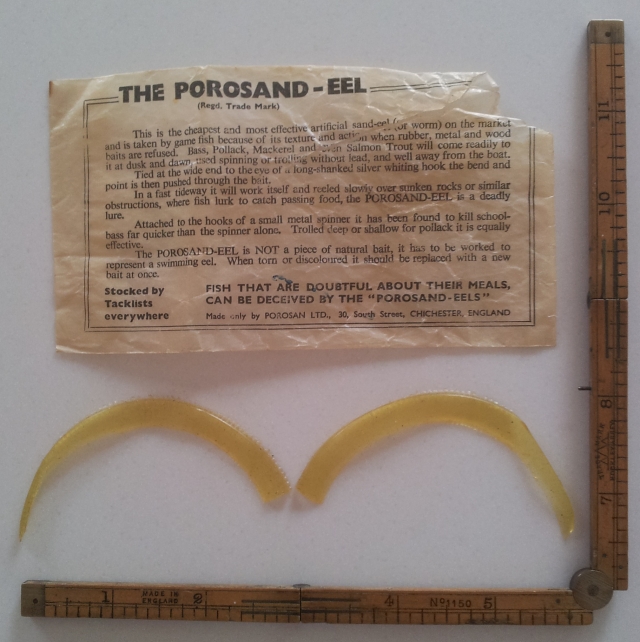
[5] Editor's note: There is no record of any such registered trade mark at the Intellectual Property Office.